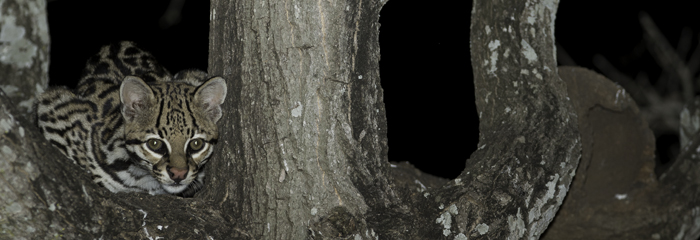
Trip Reports:
The Southern Pantanal
Wildlife Photo Tour
2014
Read the reports for
The Summary of all three trips
Trip One
Trip Two
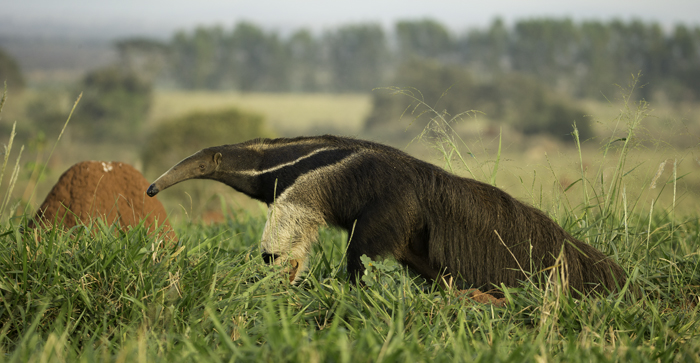

Two years ago my friend Tom Wester and I and a few others did a scouting trip to the Southern Pantanal. Various guides we had met in the north, in jaguar country, had talked about the area, as had some tour leaders that I had spoken to. Our scouting trip was a success, and I planned to return as soon as I could, but because of our schedule required a two year wait. The wait was worth it.
In contrast to the North, where so much time and energy is devoted to finding Jaguars, accomplished by cruising the rivers, in the South wildlife viewing is done by open truck or on foot, although the option exists to do boat trips as well. Indeed, on our Scouting Trip I had one of the best, and closest, Jaguar I ever had, being less than 22 feet away from a cat that rested on a river bank above us as we photographed from a skiff.
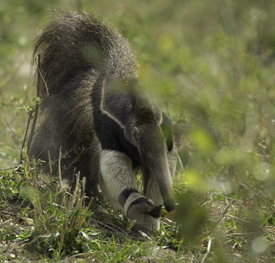 This year, with sufficient success with Jaguars to not tempt us into cruising in boats, we spent all of our time game viewing and photographing by truck, or on foot when we were after Giant Anteaters or Tamandua (Lesser Anteaters). The diversity found in the South equals and perhaps even exceeds that which we find in the North, and coupling the two into one long trip provides one with almost all the significant wildlife, particularly mammals, one can expect to find in the entire region. Covering both areas I photographed 19 species of mammals, saw 20, and missed 3 that I've had in the past.
This year, with sufficient success with Jaguars to not tempt us into cruising in boats, we spent all of our time game viewing and photographing by truck, or on foot when we were after Giant Anteaters or Tamandua (Lesser Anteaters). The diversity found in the South equals and perhaps even exceeds that which we find in the North, and coupling the two into one long trip provides one with almost all the significant wildlife, particularly mammals, one can expect to find in the entire region. Covering both areas I photographed 19 species of mammals, saw 20, and missed 3 that I've had in the past.
We visited two very different ranches that provided us with a variety of opportunities, and many different subjects. Our two big objectives, to photograph Ocelots and Giant Anteaters, were met at both locations, and towards the end of the trip we had had so many Giant Anteaters that we were only interested in finding a female carrying young!
We'll be offering this wonderful Tour again in 2016 and to preserve some sense of uniqueness, and perhaps frustrate those who simply wish to copy an itinerary, I have not identified the particular lodges.
The following is the daily journal of the trip:
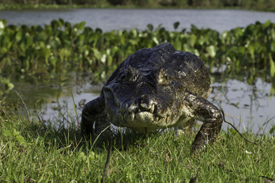
Day 1. We left PWC at 8AM in order for the folks flying home to make their connection, while the rest of us spent another five hours in the airport waiting for our flight. The flight to Campo Grande takes about an hour, and because of my Platinum and Bill’s Elite status via Delta, we had our entire group board the plane first, and our luggage arrived too! The drive to Jardim where we would spend the night was long, and started off poorly as our transportation connection screwed up and we had too many people with too much luggage, requiring us to jam stuff into every corner of the bus. Mid-way, this was corrected, and we picked up a pull-along trailer where we deposited the extra gear. We arrived in Jardim around 10, totally exhausted from a long day of travel.
Day 2. Jardim to the Sinkhole to Bonito to our first Lodge
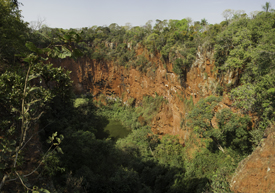
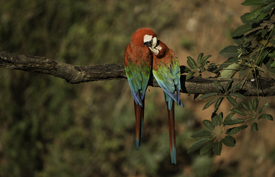
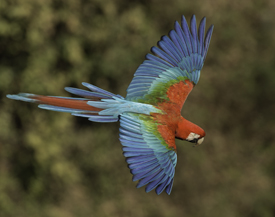 We had breakfast at 6 and we were on the road by 6:30 for a 50 minute drive to the Sinkhole where strikingly beautiful Red and Blue Macaws roost and nest in a huge limestone depression that is about 300 feet deep and 400 foot wide. The biggest Macaw show occurs at dawn when all the birds leave the crater to fly into fields and forests to feed, but throughout the morning small groups of birds return, where they fly inside the crater in circles and truly challenged our AF capabilities as we tried to follow the birds in flight. Several times birds perched on open branches, once truly at eye-level and close, so the shooting was quite good. By 10AM the bird activity had slowed down considerably, and our guide told us we’d have an hour’s drive to the next stop, where we’d have lunch and have a chance to photograph the birds at the feeder. Last time I was there birds were everywhere, so it sounded like a good plan. Thus, we cut short the crater shooting (although in truth not much was happening), and the light was growing increasingly contrasty.
We had breakfast at 6 and we were on the road by 6:30 for a 50 minute drive to the Sinkhole where strikingly beautiful Red and Blue Macaws roost and nest in a huge limestone depression that is about 300 feet deep and 400 foot wide. The biggest Macaw show occurs at dawn when all the birds leave the crater to fly into fields and forests to feed, but throughout the morning small groups of birds return, where they fly inside the crater in circles and truly challenged our AF capabilities as we tried to follow the birds in flight. Several times birds perched on open branches, once truly at eye-level and close, so the shooting was quite good. By 10AM the bird activity had slowed down considerably, and our guide told us we’d have an hour’s drive to the next stop, where we’d have lunch and have a chance to photograph the birds at the feeder. Last time I was there birds were everywhere, so it sounded like a good plan. Thus, we cut short the crater shooting (although in truth not much was happening), and the light was growing increasingly contrasty.
By the time we had drinks at the crater's kiosk and packed up and boarded the bus it was 10:45 but to our surprise, only 15-20 minutes later, we were at the lunch 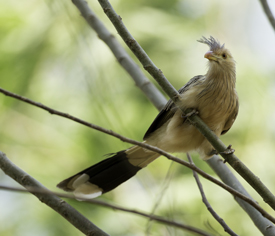 spot!. That year the feeders outside the main building were packed with parrots and parakeets, but this year the feeders were empty. Luckily the shooting was still fairly productive – I found a Guira Cuckoo flock that cooperated briefly, and several in the group shot a Blue and Yellow Macaw at its nest, with Jerome catching a great image as the bird launched itself from the nest hole, straight towards him.
spot!. That year the feeders outside the main building were packed with parrots and parakeets, but this year the feeders were empty. Luckily the shooting was still fairly productive – I found a Guira Cuckoo flock that cooperated briefly, and several in the group shot a Blue and Yellow Macaw at its nest, with Jerome catching a great image as the bird launched itself from the nest hole, straight towards him.
Judy and Don had followed two Red-legged Seremias we had seen as we drove in, and had nice shots. These long-legged birds that are truly the ecological equivalent of the African Secretary Bird (much like the Crane Hawk with the Gymnogene), looking quite similar and having the same diet. When I met up with Don and Judy later at the Macaw nest they pointed out the direction where the birds had been and I found the birds beneath a tree. Using a ‘lost key’ 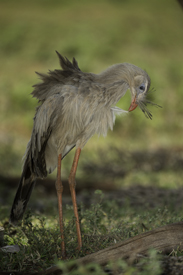 approach, I got within frame-filling distance of the two birds, and I ended up shooting them with fill-flash to reduce the contrast between their shady spot and the bright, sunlit background. It was the best shooting I’ve ever had with this, the South American equivalent of a Velociraptor.
approach, I got within frame-filling distance of the two birds, and I ended up shooting them with fill-flash to reduce the contrast between their shady spot and the bright, sunlit background. It was the best shooting I’ve ever had with this, the South American equivalent of a Velociraptor.
We left at 1 for our next lodge, and although the roads in the South are paved (in contrast to the commute on the Transpantenaria Highway in the North), the trip was still long and arduous and we were beat by the time we arrived. We had planned a night game drive, but this one would be part of the lodge’s offering and would have 28 people aboard, if we went. Instead, all of us opted out to rest and unpack our gear in preparation for a busy day tomorrow.
Day 3. Lodge 1
We left shortly after 6AM, exchanging a smaller ‘safari truck’ for a larger version where we had much more room. We were hoping for Giant Anteaters, and watched carefully the area where, two years ago, we were quite successful with this 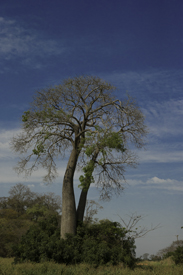 mammal. Then, on a given morning we might see as many as six anteaters, but today we had no luck. This pre-breakfast drive was fairly uneventful, but after breakfast (7:20-8:00 AM) we headed back out, covering some of the same upland territory once again. Our shooting was rather limited until we reached the flatlands and the rice fields, where we had fairly constant and rewarding shooting – doing all of it from the seats and bed of the safari truck.
mammal. Then, on a given morning we might see as many as six anteaters, but today we had no luck. This pre-breakfast drive was fairly uneventful, but after breakfast (7:20-8:00 AM) we headed back out, covering some of the same upland territory once again. Our shooting was rather limited until we reached the flatlands and the rice fields, where we had fairly constant and rewarding shooting – doing all of it from the seats and bed of the safari truck.
The subjects included a Burrowing Owl adult and a juvenile; great images of a Savannah Hawk; Crested Caracara; and Roadside Hawk; Marsh Deer – both does and two bucks; scenic shots of Fat-bellied Trees that resemble Madagascar baobobs; and poor record shots of Southern Screamers; Brazilian Teal; and a few other birds. The game drive lasted until 11:40, a good length of time for a private safari. It was a very good morning!
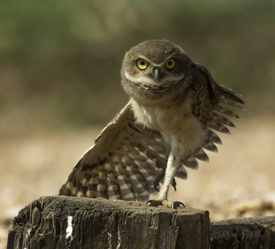
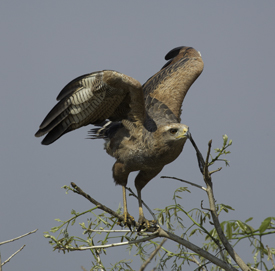
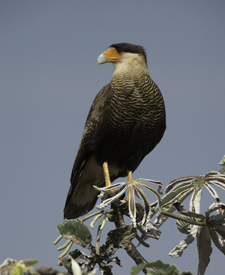
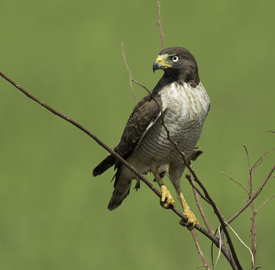
Shot right from our game-drive truck: Immature Burrowing Owl; Savannah Hawk
Southern Crested Caracara; Roadside Hawk
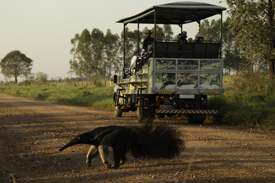 PM. We left at 3:30PM in what seemed like impossibly hot conditions for having any luck, but by 4:15 we found our first Giant Anteater, in high grass but shy, and we continued on. Later, in the same field we found three more Anteaters, and we enjoyed a modest amount of success. The guides spotted a female Anteater with a baby on her back that was further out in the field and beacause of the distance our guide suggested we move on when she went into the woods and disappeared. While we considered this the Anteater reappeared, so Judy and I and one of the guides walked through the tall grass to approach, while the rest of the group drove on to reach the same spot via a road.
PM. We left at 3:30PM in what seemed like impossibly hot conditions for having any luck, but by 4:15 we found our first Giant Anteater, in high grass but shy, and we continued on. Later, in the same field we found three more Anteaters, and we enjoyed a modest amount of success. The guides spotted a female Anteater with a baby on her back that was further out in the field and beacause of the distance our guide suggested we move on when she went into the woods and disappeared. While we considered this the Anteater reappeared, so Judy and I and one of the guides walked through the tall grass to approach, while the rest of the group drove on to reach the same spot via a road.
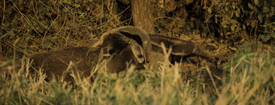
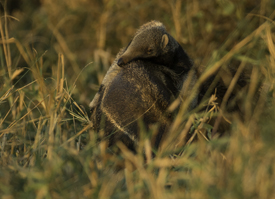 The anteater came out into the open, to an extent, but I think the guides here are accustomed to impatient tourists and our guide approached the anteater too quickly, and made enough noise walking through the leaves that evenI could hear him. The anteater must have been alerted as well and retreated deeper into the woods and did not return. We did have one brief shooting opportunity, but somehow, stupidly, my AF was set on the leaves behind the anteater, and my best shots are definitely soft. Judy, I’m hoping, did far better.
The anteater came out into the open, to an extent, but I think the guides here are accustomed to impatient tourists and our guide approached the anteater too quickly, and made enough noise walking through the leaves that evenI could hear him. The anteater must have been alerted as well and retreated deeper into the woods and did not return. We did have one brief shooting opportunity, but somehow, stupidly, my AF was set on the leaves behind the anteater, and my best shots are definitely soft. Judy, I’m hoping, did far better.
We returned by 5:30, and quickly grabbed flashes for an early night game drive where we hoped to photograph or see ocelot. One crossed the road that only the guides saw, but it remained hidden and we missed it. Near the lodge we did find another Giant Anteater close to the road, and everyone had a great view and a good opportunity for photos.
Day 4. Lodge 1
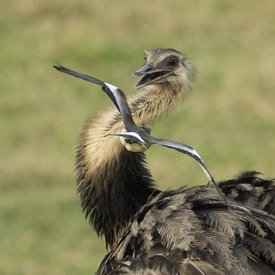 We left at 6AM for what was supposed to be a 45 minute outing, since 40 school students would be at breakfast at 7AM. Soon out of camp we had a Crab-eating Fox wandering beside the road, watching a Greater Rhea that was being dive-bombed by a Southern Lapwing, apparently defending its nest. I missed several passes as the Lapwing harassed the Rhea as I was still on the fox, but the action with the Rhea continued and I made the switch, with the lapwing swooping quite close to the larger bird’s head and eventually driving the Rhea off.
We left at 6AM for what was supposed to be a 45 minute outing, since 40 school students would be at breakfast at 7AM. Soon out of camp we had a Crab-eating Fox wandering beside the road, watching a Greater Rhea that was being dive-bombed by a Southern Lapwing, apparently defending its nest. I missed several passes as the Lapwing harassed the Rhea as I was still on the fox, but the action with the Rhea continued and I made the switch, with the lapwing swooping quite close to the larger bird’s head and eventually driving the Rhea off.
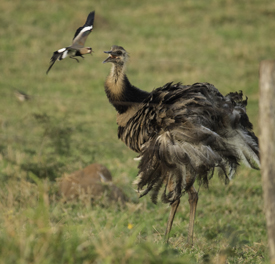
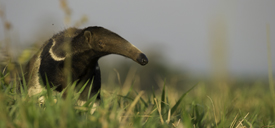 Around 6:30AM we found a fairly cooperative Giant Anteater that Tom, Judy, and I worked, walking through the wet grasses to get several nice early morning shots. The anteater ended up walking right beside our truck, where Bill, Doris, and Jerome were waiting and had a chance to shoot.
Around 6:30AM we found a fairly cooperative Giant Anteater that Tom, Judy, and I worked, walking through the wet grasses to get several nice early morning shots. The anteater ended up walking right beside our truck, where Bill, Doris, and Jerome were waiting and had a chance to shoot.
After breakfast we headed back out, finding Jaguar tracks quite close to the lodge. Along the canal bordering the jungle edge we photographed a Wattled Jacana family with three small chicks, a Black and White Marsh Tyrant, Black-collared Hawk, Rufous-collared Seedeater, Muscovy Duck, and Neotropical Cormorant.
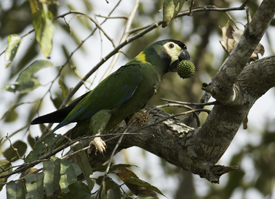 A Yellow-collared Macaw fed on a ‘magical fruit’ that is said to grow hair, and a Blue-crowned Trogan flew in to the same tree for some quick shots.
A Yellow-collared Macaw fed on a ‘magical fruit’ that is said to grow hair, and a Blue-crowned Trogan flew in to the same tree for some quick shots.
At a Rufous Hornero nest a group of Black-hooded Parakeets investigated the Hornero's clay nest, and our guide suspected they might have been checking out the opening as a nest hole for themselves. The construction of the nest, baked clay that develops the harness of a ceramic pot, seemed to defy the parakeet’s bills, but I wondered if, had they been able to open it, and chicks were inside, would the Parakeets eat them? I think they would. At any rate, the Hornero seemed confident about the futility of the Parakeets action and although it stayed near, the Hornero did not dive-bomb the parakeets, making me think it knew that the clay nest was solid and secure.
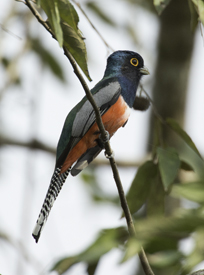
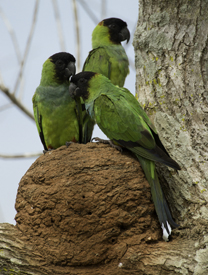
Shortly after our guides spotted an Ocelot approaching us, far up the road, but it eventually wandered into the brush and disappeared. While we waited, two Marsh Deer bucks ran along the rice fields on the other side of the canal bordering our track, and we raced ahead, hoping to get some shots before these long-legged deer disappeared in the high elephant grass that separated the two fields. Instead, when we stopped the truck, both bucks, sequentially, appeared on the canal bank directly across from us, ran down the bank, and dove into the canal to swim to our side, where they crossed the road and disappeared into the jungle. The shots as the deer jumped into the canal were spectacular.
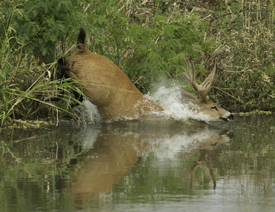
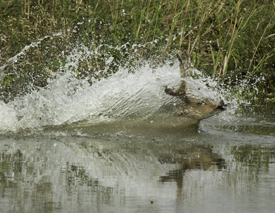
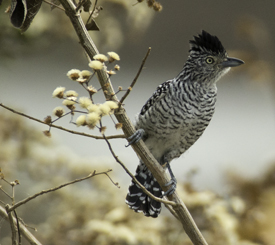
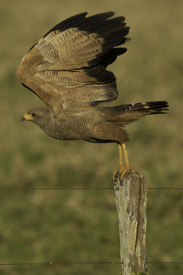
On our way back to camp we passed several brush fires that had been set to remove ground cover for mice, and Savannah Hawks, Crested Caracaras, Roadside Hawks, and Greater Black Hawks, were all perched near the road waiting for scurrying prey. A White-tailed Hawk flushed out as well, but aside from giving us a good view we had no chance for photos. We did some nice shooting of Greater Rheas feeding in the brush, and a Barred Antshrike sang and displayed along the roadside, offering good shots too.
PM. We cruised the main road with a different driver but the same guide/spotter, hoping to find a mother Anteater with a baby. Although we saw several giant anteaters, and might have been able to work one or two of these, we held off, concentrating on our goal of finding a baby but we were unsuccess. The field where we had the mother Anteater yesterday was being worked by cowboys driving cattle, and that spectacle, which was quite dramatic to watch and photograph, undoubtedly kept any anteaters inside the forest . Except for the cowboy drive, we did little shooting.
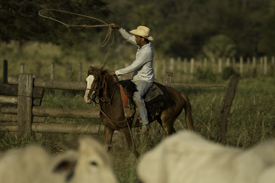
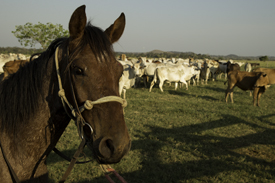
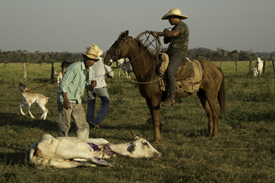
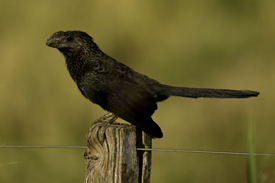
After the game drive we had 20 minutes before we left for another early night game drive, since a ‘party’ or alcedo was planned at 8PM. I was a bit dubious about having the same schedule as last night since that one was unsuccessful but as it turned out this game drive was great. Shortly after dark we had our first Ocelot, walking down the road towards us. We immediately doused the lights out until it was quite near, with the Spotter following its approach in the dim light of a starry sky. I had a chance for a shot once the spotlight was turned on, but I was afraid I’d be blocking a view for the others and I waited, finally snapping one frame just as the ocelot turned and disappeared behind a bush. A few minutes later we encountered the cat again, lying peacefully just off the road, right on the edge of a great opening, but a few high grasses ruined what would have been a perfect view. When the Ocelot finally got up, the cat moved faster than I could obtain a focus and the cat disappeared in the high elephant grass. Again, our driver found an opening and surprised the cat when it reappeared, but the cat ran through the clearing before any of us had a chance to shoot.
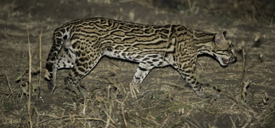 We moved on, soon finding another cat across an irrigation dike and in good view. Again I had trouble achieving focus and missed the first chances when the Ocelot’s head appeared in view facing us. The cat retreated from the lights and ran down the canal, crossing a bridge and passing behind our vehicle, and everyone – even me—got several nice shots as it ran by.
We moved on, soon finding another cat across an irrigation dike and in good view. Again I had trouble achieving focus and missed the first chances when the Ocelot’s head appeared in view facing us. The cat retreated from the lights and ran down the canal, crossing a bridge and passing behind our vehicle, and everyone – even me—got several nice shots as it ran by.
Two more Ocelots were spotted in fields that were either too far away or were too shy for shooting, and then we found another, this time a lame one whose normally resplendent fur looked very dull, as if the cat was ill. We made a few mediocre shots, but the grass, and the cat’s coloration, were not the best.
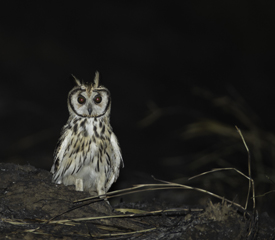 A Striped Owl appeared on a tree, then flew off to a dirt mound, giving us two opportunities for this bird that resembles a long-eared owl from the US. I was in the process of adding more money into the tip envelope when the owl appeared, and I almost missed any shots.
A Striped Owl appeared on a tree, then flew off to a dirt mound, giving us two opportunities for this bird that resembles a long-eared owl from the US. I was in the process of adding more money into the tip envelope when the owl appeared, and I almost missed any shots.
Then, because we were now late for the dinner, I decided to add some more money and just as I pulled out the envelope we had another Ocelot, this one sitting in the crotch of a tree. It was a great front-on view and completely in the clear, and after 40 frames or so we moved a bit closer, whereupon the cat changed position and then climbed down the tree head-first. Again, in the process of stuffing envelopes I was unprepared, and I almost missed the shots!
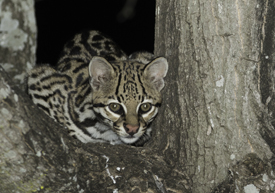
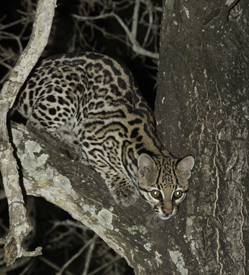
It was interesting to watch the Ocelot climb down from the tree. A similar-looking cat, the Margay, rotates its ankle bones backwards, as a squirrel’s does, for a more secure anchor when it climbs down a tree. The Ocelot’s ankles do not rotate, just as a house cat’s do not, and the shots clearly showed this deficit as the cat finally had to jump to the ground. It was a spectacular ending to our first destination.
Day 5. Lodge 1 to Lodge 2
We left at 7:30 after paying our bills (requiring us to wake up the receptionis) for the 3 hour drive to our final destination. We stopped along the way at a supermarket where several of us bought gaucho knives, and I bought a mate’ set of cups, before continuing on, traveling on a paved road for most of the distance. En route we encountered another Giant Anteater, this one drinking at a water hole near the roadside, but by the time we stopped the bus and we got out the anteater had already moved off, a shaggy, improbably-looking mop of an animal drifting through the grasses.
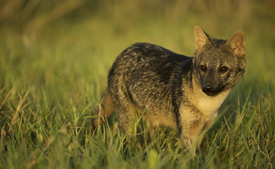 Our second lodge is one of my favorite locations, with Hyacinth Macaws roosting or perhaps even nesting in the tall broken palms towering right outside the reception area. A Swiss photographer, who may have supplied game cameras for an ocelot project, was reviewing images at the lunch area, and he had a nice Ocelot on his laptop screen, one that we too hoped to film that evening.
Our second lodge is one of my favorite locations, with Hyacinth Macaws roosting or perhaps even nesting in the tall broken palms towering right outside the reception area. A Swiss photographer, who may have supplied game cameras for an ocelot project, was reviewing images at the lunch area, and he had a nice Ocelot on his laptop screen, one that we too hoped to film that evening.
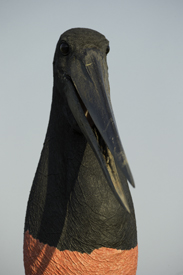
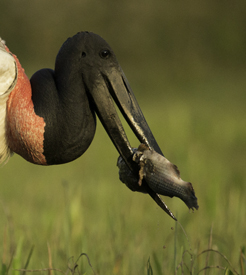
At 3:45 we did a game drive, traveling to an area where I had Crab-eating Foxes on my scouting trip. A fox did arrive, as did two Jabiru Storks, who flew in so close that a wide-angle lens (for shooting an animal in habitat image) would have been a better choice than would our telephotos. Still, we did get nice shots of the fox, the stork, and, as a real bonus, a buck Pampas Deer in velvet that we approached 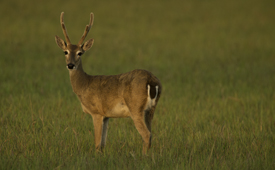 using the truck and we did quite well. On my scouting trip I saw this deer a few times, but those shooting opportunities resulted in deer barely more than specks. This buck was a great one!
using the truck and we did quite well. On my scouting trip I saw this deer a few times, but those shooting opportunities resulted in deer barely more than specks. This buck was a great one!
We arrived back at the lodge at 5:50, and planned to turn around and head back out by 6PM for the ocelot, but some in the group were late and we didn’t leave until 6:10. It ended up not mattering, as the Swiss photographer had claimed the spot, and had set up serious lights with umbrellas for his shooting. It was obvious that we were not welcome, and getting a very frigid reception, we left. It was his last night of shooting and I knew we’d have a chance at the Ocelot tomorrow. In all fairness, I’d have wanted the private time, too, if it was my last evening to shoot, and I wouldn't want to be bothered by a bunch of 'tourists' either. We headed back for dinner where three Crab-eating Foxes and a Yellow Armadillo sat in the grasses near the dining area, waiting for handouts.
Day 6. Lodge 2
Pre-breakfast most of us photographed the birds at the feeder – Plush-crested Jays and Purplish Jays (a darkish bird that barely doesn't appear to have a purple color, unless hit by flash, when it certainly does!), Toco Toucans, and several Cowbirds.
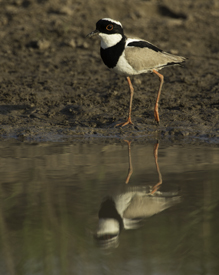
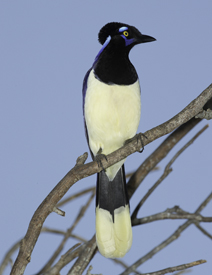

Pied Plover; Plush-crested Jay; Purplish Jay
We headed back out to the Caiman pond area where we photographed several of these crocodilians that came ashore for a fish handout. Some of these reptiles were remarkably bold, requiring us to back up – we were laying on the ground using wide-angles. Don had his camera on a pole for video and let a Caiman come close, (you can see the video at https://vimeo.com/105677162 ) which then lunged and grabbed his camera! Judy caught the moment with her camera, too, which is quite comical with the caiman clamped down upon the front of the lens. Fortunately it released the camera quickly, injuring neither itself or the camera lens.
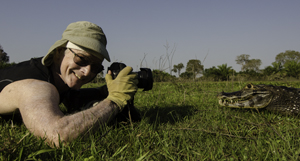
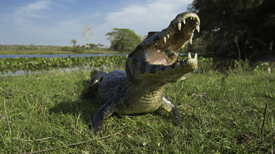
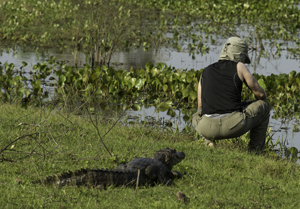
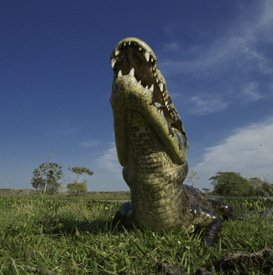
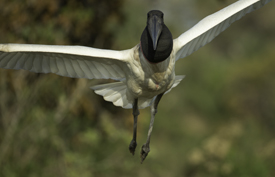
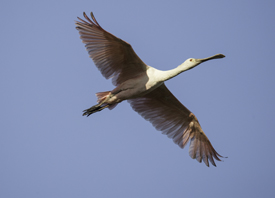
Top: The Caimans were fearless and we often had to back up, and
Don's video was grabbed when he extended it via a pole.
Middle: It looks like the Caiman was sneaking up to me ... was it?
Bottom: Jabiru Stork flying in to investigate; Roseate Spoonbill flying by.
Heading back to camp we stopped at a seed tree where a Toco Toucan was feeding, and a favorite tree for Hyacinth Macaws. A short while later, as we continued towards home we had another Giant Anteater, and did rather well with photos. After lunch I headed back out to the Ocelot spot which was now vacated by 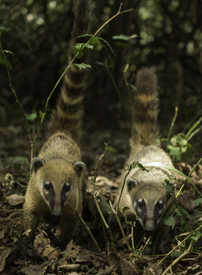 the Swiss photographer and I began to set up my improvised lighting system, using bamboo poles and threaded rods for holding the Phottix slave trippers and flashes. My guide called me MacGiver because of the jury-rigging involved in setting up the flashes, using the bamboo and lashing poles to vines and tree trunks. While I was doing this I was practically mobbed by a gang of Coatimundis that apparently thought they were going to be fed. The Coati shooting was great, and several times while I was lying flat I had to kick out and rustle the leaves at my feet so that the Coatis would keep outside my minimum focus distance. They chirred and whistled oddly, annoyed or curious, but did not keeping me from setting the stands for the night’s shooting.
the Swiss photographer and I began to set up my improvised lighting system, using bamboo poles and threaded rods for holding the Phottix slave trippers and flashes. My guide called me MacGiver because of the jury-rigging involved in setting up the flashes, using the bamboo and lashing poles to vines and tree trunks. While I was doing this I was practically mobbed by a gang of Coatimundis that apparently thought they were going to be fed. The Coati shooting was great, and several times while I was lying flat I had to kick out and rustle the leaves at my feet so that the Coatis would keep outside my minimum focus distance. They chirred and whistled oddly, annoyed or curious, but did not keeping me from setting the stands for the night’s shooting.
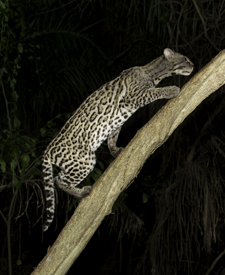 PM. An Anteater with a baby had been spotted and we spent the afternoon searching for it without success. Another anteater, however, offered some nice shots. As the sun set our driver dropped off everyone, and I ran to my room to get the flash gear to set up for the Ocelot before dark. About twenty minutes later Bill, Judy, Don, and Doris joined me at the Ocelot location where we waited in the growing gloom and buzzing mosquitos for the ocelot. By 6:45 our guide suggested we go to dinner, and Don, Judy, and Doris left, but Bill and I stayed in case the Ocelot arrived. To the north the sky was ablaze with a huge thunderstorm and the towering cumulous cloud periodically lit up as if by fireworks. Lightning was nearly constant, and never more than 5 seconds went by without a splash of orange color in the cloud, marking another strike. I was just about to get my camera and tripod from the ocelot set when our driver/guide spied the Ocelot. Over the next 45 minutes he slowly chummed the cat through the woods, leading it to the shooting site. Until it reached my lighting set up I couldn't shoot, so I held a flashlight for Bill to focus and photograph, and I did a few shots with Don’s camera in case he didn’t arrive back in time. The cat stayed at the bait site, and about 8 minutes into the shoot the three returned, and brought a doggie-bag of dinner for us, too. The Ocelot performed well, and after an hour or so the cat had eaten enough and moved off. We were done for the night, too.
PM. An Anteater with a baby had been spotted and we spent the afternoon searching for it without success. Another anteater, however, offered some nice shots. As the sun set our driver dropped off everyone, and I ran to my room to get the flash gear to set up for the Ocelot before dark. About twenty minutes later Bill, Judy, Don, and Doris joined me at the Ocelot location where we waited in the growing gloom and buzzing mosquitos for the ocelot. By 6:45 our guide suggested we go to dinner, and Don, Judy, and Doris left, but Bill and I stayed in case the Ocelot arrived. To the north the sky was ablaze with a huge thunderstorm and the towering cumulous cloud periodically lit up as if by fireworks. Lightning was nearly constant, and never more than 5 seconds went by without a splash of orange color in the cloud, marking another strike. I was just about to get my camera and tripod from the ocelot set when our driver/guide spied the Ocelot. Over the next 45 minutes he slowly chummed the cat through the woods, leading it to the shooting site. Until it reached my lighting set up I couldn't shoot, so I held a flashlight for Bill to focus and photograph, and I did a few shots with Don’s camera in case he didn’t arrive back in time. The cat stayed at the bait site, and about 8 minutes into the shoot the three returned, and brought a doggie-bag of dinner for us, too. The Ocelot performed well, and after an hour or so the cat had eaten enough and moved off. We were done for the night, too.
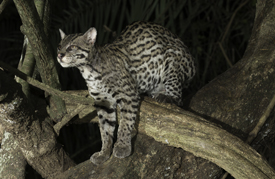
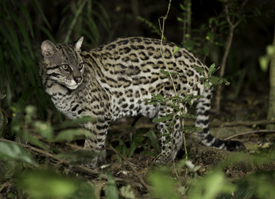
Day 7. Lodge 2
With a report of an Anteater with young we spent most of the morning searching the area around the lodge where the pair had been seen. We did not have luck with the mother, but did see several other Giant Anteaters and photographed two. When Tom and I did our scouting trip we saw only one here, and that one involved 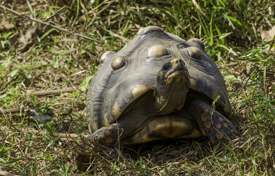 us in a crazy chase across a field in predawn light. I’ve lost count of how many Giant Anteaters we’ve seen on this trip, but a typical drive gives us at least three.
us in a crazy chase across a field in predawn light. I’ve lost count of how many Giant Anteaters we’ve seen on this trip, but a typical drive gives us at least three.
We circled a large area searching, and at one stop one of the guides found a Red-legged (or Red-Footed) Tortoise underneath a culvert. The tortoise came out and we did a multiple shots, mostly with wide-angle as the Tortoise lumbered along, heading towards a small forest. I’d only seen one other Tortoise, and that was at another lodge where it hung around the lodge and picnic tables – not the best locale for photography. This one was great.
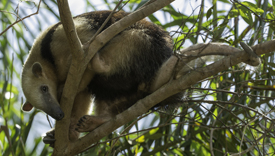 Our morning was finished and we were heading back to the lodge when we received a radio call that a Tamandua, or Lesser Anteater, had been seen. Did we want to see it? Of course, and we met the guide who had rode out on his motorbike to meet us, who then took the wheel of our jeep and led us back out towards the caiman ponds. In the flat plains several small tree hammocks dotted the grasslands, one of these perhaps hiding the Tamandua. Several of us spread out, searching for an animal that had been seen an hour earlier. The guides found the Tamandua near the edge of a hammock, and the shooting was excellent, although none of us had flashes along. Had we, fill-flash and balanced exposures with a sky would have been easy to achieve. As it was, this was only the second Tamandua I’ve seen in the Pantanal, and the third ever.
Our morning was finished and we were heading back to the lodge when we received a radio call that a Tamandua, or Lesser Anteater, had been seen. Did we want to see it? Of course, and we met the guide who had rode out on his motorbike to meet us, who then took the wheel of our jeep and led us back out towards the caiman ponds. In the flat plains several small tree hammocks dotted the grasslands, one of these perhaps hiding the Tamandua. Several of us spread out, searching for an animal that had been seen an hour earlier. The guides found the Tamandua near the edge of a hammock, and the shooting was excellent, although none of us had flashes along. Had we, fill-flash and balanced exposures with a sky would have been easy to achieve. As it was, this was only the second Tamandua I’ve seen in the Pantanal, and the third ever.
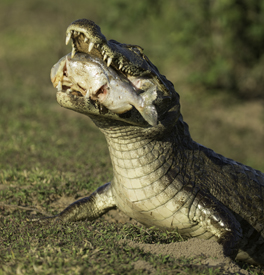
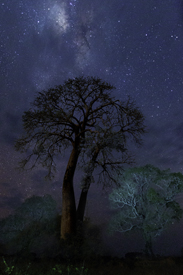
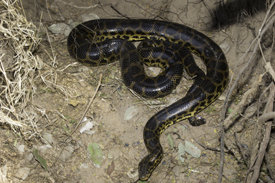
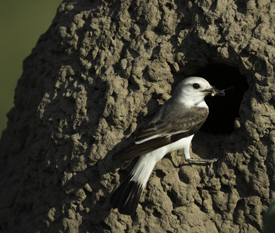
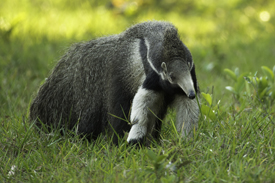
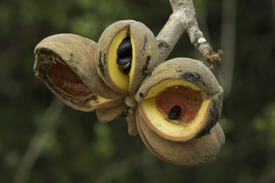
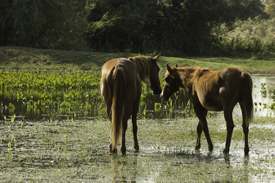
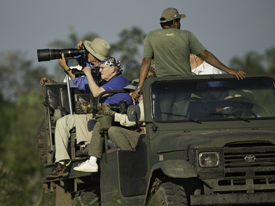
Top: Caiman feeding; the 'fat-bellied tree' against the stars.
Second Row: Yellow Anaconda; White-rumped Monjita.
Third Row: Giant Anteater; Fruit for Toucans and Macaws.
Bottom: Horses in a pond; Shooting on a truck safari.
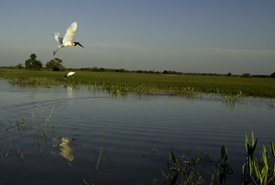 PM. We headed back to the Caiman ponds, hoping to do wide-angle shots of the Jabiru Storks as they flew in. We had mild success, but the Caimans were interesting, swimming rapidly towards us, creating V-shaped wakes in the still water from everywhere to seek a fish handout. Some of the Caimans were remarkably bold, almost aggressive, and I was glad they are only two meters long. One, waiting for a tossed fish, had its tail bit by another, smaller Caiman and in a lightning-fast move, completely reversed directions, a full 180 degree flip, to confront the smaller Caiman. That little demonstration illustrated the potential danger these animals could represent. We were careful.
PM. We headed back to the Caiman ponds, hoping to do wide-angle shots of the Jabiru Storks as they flew in. We had mild success, but the Caimans were interesting, swimming rapidly towards us, creating V-shaped wakes in the still water from everywhere to seek a fish handout. Some of the Caimans were remarkably bold, almost aggressive, and I was glad they are only two meters long. One, waiting for a tossed fish, had its tail bit by another, smaller Caiman and in a lightning-fast move, completely reversed directions, a full 180 degree flip, to confront the smaller Caiman. That little demonstration illustrated the potential danger these animals could represent. We were careful.
We finished the evening with the Crab-eating Foxes that followed our truck and circled around us, providing incredible shots in the late light of afternoon. We returned near dusk, giving us some time for the difficult packing for our trip home, a long day that begins tomorrow.
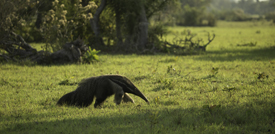
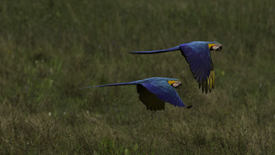
We will be offering this incredible extension again in 2016. Contact our office to get onto our first alert list, and sign up at Constant Contact for immediate updates.








Sign up for our Constant Contact Newsletter to receive the latest information on our up coming tours and safaris, immediate opening offerings, and other news. We do not share this list with any other source.
Join us on Facebook at: Follow Hoot Hollow
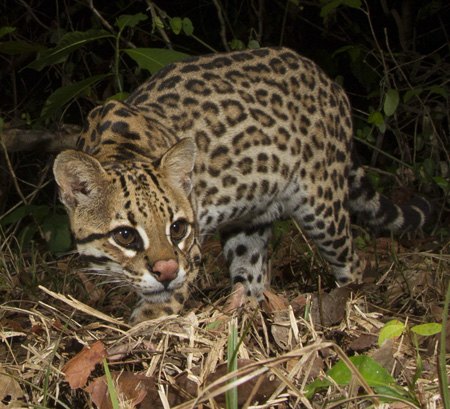
If you'd like to learn how to take images like this, we have the course.
In 2015 we are planning on running our Advanced Nature Photography Course which will be primarily concerned with Mastering Flash, remote or camera triggering devices like the Range IR, and macro photography. Contact our office if you are interested.
We would love if everyone who did our Photo Safaris and Tours did one of our Digital Complete Nature Photo Courses to learn manual exposure, flash, workflow, and basic Photoshop and in-depth RAW conversion. We think everyone would get even more out of our trips if they truly were masters of the craft.
Read any or all of our other Trip Reports.
Refer to our BROCHURE to get an idea of next year's trip!
Exact dates and prices may not be updated.
Check out our Blurp book,
Jaguars and the Wildlife of the Pantanal

Trip Reports:
The Southern Pantanal
Wildlife Photo Tour
2014
Read the reports for
The Summary of all three trips
Trip One
Trip Two


Two years ago my friend Tom Wester and I and a few others did a scouting trip to the Southern Pantanal. Various guides we had met in the north, in jaguar country, had talked about the area, as had some tour leaders that I had spoken to. Our scouting trip was a success, and I planned to return as soon as I could, but because of our schedule required a two year wait. The wait was worth it.
In contrast to the North, where so much time and energy is devoted to finding Jaguars, accomplished by cruising the rivers, in the South wildlife viewing is done by open truck or on foot, although the option exists to do boat trips as well. Indeed, on our Scouting Trip I had one of the best, and closest, Jaguar I ever had, being less than 22 feet away from a cat that rested on a river bank above us as we photographed from a skiff.
 This year, with sufficient success with Jaguars to not tempt us into cruising in boats, we spent all of our time game viewing and photographing by truck, or on foot when we were after Giant Anteaters or Tamandua (Lesser Anteaters). The diversity found in the South equals and perhaps even exceeds that which we find in the North, and coupling the two into one long trip provides one with almost all the significant wildlife, particularly mammals, one can expect to find in the entire region. Covering both areas I photographed 19 species of mammals, saw 20, and missed 3 that I've had in the past.
This year, with sufficient success with Jaguars to not tempt us into cruising in boats, we spent all of our time game viewing and photographing by truck, or on foot when we were after Giant Anteaters or Tamandua (Lesser Anteaters). The diversity found in the South equals and perhaps even exceeds that which we find in the North, and coupling the two into one long trip provides one with almost all the significant wildlife, particularly mammals, one can expect to find in the entire region. Covering both areas I photographed 19 species of mammals, saw 20, and missed 3 that I've had in the past.
We visited two very different ranches that provided us with a variety of opportunities, and many different subjects. Our two big objectives, to photograph Ocelots and Giant Anteaters, were met at both locations, and towards the end of the trip we had had so many Giant Anteaters that we were only interested in finding a female carrying young!
We'll be offering this wonderful Tour again in 2016 and to preserve some sense of uniqueness, and perhaps frustrate those who simply wish to copy an itinerary, I have not identified the particular lodges.
The following is the daily journal of the trip:

Day 1. We left PWC at 8AM in order for the folks flying home to make their connection, while the rest of us spent another five hours in the airport waiting for our flight. The flight to Campo Grande takes about an hour, and because of my Platinum and Bill’s Elite status via Delta, we had our entire group board the plane first, and our luggage arrived too! The drive to Jardim where we would spend the night was long, and started off poorly as our transportation connection screwed up and we had too many people with too much luggage, requiring us to jam stuff into every corner of the bus. Mid-way, this was corrected, and we picked up a pull-along trailer where we deposited the extra gear. We arrived in Jardim around 10, totally exhausted from a long day of travel.
Day 2. Jardim to the Sinkhole to Bonito to our first Lodge


 We had breakfast at 6 and we were on the road by 6:30 for a 50 minute drive to the Sinkhole where strikingly beautiful Red and Blue Macaws roost and nest in a huge limestone depression that is about 300 feet deep and 400 foot wide. The biggest Macaw show occurs at dawn when all the birds leave the crater to fly into fields and forests to feed, but throughout the morning small groups of birds return, where they fly inside the crater in circles and truly challenged our AF capabilities as we tried to follow the birds in flight. Several times birds perched on open branches, once truly at eye-level and close, so the shooting was quite good. By 10AM the bird activity had slowed down considerably, and our guide told us we’d have an hour’s drive to the next stop, where we’d have lunch and have a chance to photograph the birds at the feeder. Last time I was there birds were everywhere, so it sounded like a good plan. Thus, we cut short the crater shooting (although in truth not much was happening), and the light was growing increasingly contrasty.
We had breakfast at 6 and we were on the road by 6:30 for a 50 minute drive to the Sinkhole where strikingly beautiful Red and Blue Macaws roost and nest in a huge limestone depression that is about 300 feet deep and 400 foot wide. The biggest Macaw show occurs at dawn when all the birds leave the crater to fly into fields and forests to feed, but throughout the morning small groups of birds return, where they fly inside the crater in circles and truly challenged our AF capabilities as we tried to follow the birds in flight. Several times birds perched on open branches, once truly at eye-level and close, so the shooting was quite good. By 10AM the bird activity had slowed down considerably, and our guide told us we’d have an hour’s drive to the next stop, where we’d have lunch and have a chance to photograph the birds at the feeder. Last time I was there birds were everywhere, so it sounded like a good plan. Thus, we cut short the crater shooting (although in truth not much was happening), and the light was growing increasingly contrasty.
By the time we had drinks at the crater's kiosk and packed up and boarded the bus it was 10:45 but to our surprise, only 15-20 minutes later, we were at the lunch  spot!. That year the feeders outside the main building were packed with parrots and parakeets, but this year the feeders were empty. Luckily the shooting was still fairly productive – I found a Guira Cuckoo flock that cooperated briefly, and several in the group shot a Blue and Yellow Macaw at its nest, with Jerome catching a great image as the bird launched itself from the nest hole, straight towards him.
spot!. That year the feeders outside the main building were packed with parrots and parakeets, but this year the feeders were empty. Luckily the shooting was still fairly productive – I found a Guira Cuckoo flock that cooperated briefly, and several in the group shot a Blue and Yellow Macaw at its nest, with Jerome catching a great image as the bird launched itself from the nest hole, straight towards him.
Judy and Don had followed two Red-legged Seremias we had seen as we drove in, and had nice shots. These long-legged birds that are truly the ecological equivalent of the African Secretary Bird (much like the Crane Hawk with the Gymnogene), looking quite similar and having the same diet. When I met up with Don and Judy later at the Macaw nest they pointed out the direction where the birds had been and I found the birds beneath a tree. Using a ‘lost key’  approach, I got within frame-filling distance of the two birds, and I ended up shooting them with fill-flash to reduce the contrast between their shady spot and the bright, sunlit background. It was the best shooting I’ve ever had with this, the South American equivalent of a Velociraptor.
approach, I got within frame-filling distance of the two birds, and I ended up shooting them with fill-flash to reduce the contrast between their shady spot and the bright, sunlit background. It was the best shooting I’ve ever had with this, the South American equivalent of a Velociraptor.
We left at 1 for our next lodge, and although the roads in the South are paved (in contrast to the commute on the Transpantenaria Highway in the North), the trip was still long and arduous and we were beat by the time we arrived. We had planned a night game drive, but this one would be part of the lodge’s offering and would have 28 people aboard, if we went. Instead, all of us opted out to rest and unpack our gear in preparation for a busy day tomorrow.
Day 3. Lodge 1
We left shortly after 6AM, exchanging a smaller ‘safari truck’ for a larger version where we had much more room. We were hoping for Giant Anteaters, and watched carefully the area where, two years ago, we were quite successful with this  mammal. Then, on a given morning we might see as many as six anteaters, but today we had no luck. This pre-breakfast drive was fairly uneventful, but after breakfast (7:20-8:00 AM) we headed back out, covering some of the same upland territory once again. Our shooting was rather limited until we reached the flatlands and the rice fields, where we had fairly constant and rewarding shooting – doing all of it from the seats and bed of the safari truck.
mammal. Then, on a given morning we might see as many as six anteaters, but today we had no luck. This pre-breakfast drive was fairly uneventful, but after breakfast (7:20-8:00 AM) we headed back out, covering some of the same upland territory once again. Our shooting was rather limited until we reached the flatlands and the rice fields, where we had fairly constant and rewarding shooting – doing all of it from the seats and bed of the safari truck.
The subjects included a Burrowing Owl adult and a juvenile; great images of a Savannah Hawk; Crested Caracara; and Roadside Hawk; Marsh Deer – both does and two bucks; scenic shots of Fat-bellied Trees that resemble Madagascar baobobs; and poor record shots of Southern Screamers; Brazilian Teal; and a few other birds. The game drive lasted until 11:40, a good length of time for a private safari. It was a very good morning!




Shot right from our game-drive truck: Immature Burrowing Owl; Savannah Hawk
Southern Crested Caracara; Roadside Hawk
 PM. We left at 3:30PM in what seemed like impossibly hot conditions for having any luck, but by 4:15 we found our first Giant Anteater, in high grass but shy, and we continued on. Later, in the same field we found three more Anteaters, and we enjoyed a modest amount of success. The guides spotted a female Anteater with a baby on her back that was further out in the field and beacause of the distance our guide suggested we move on when she went into the woods and disappeared. While we considered this the Anteater reappeared, so Judy and I and one of the guides walked through the tall grass to approach, while the rest of the group drove on to reach the same spot via a road.
PM. We left at 3:30PM in what seemed like impossibly hot conditions for having any luck, but by 4:15 we found our first Giant Anteater, in high grass but shy, and we continued on. Later, in the same field we found three more Anteaters, and we enjoyed a modest amount of success. The guides spotted a female Anteater with a baby on her back that was further out in the field and beacause of the distance our guide suggested we move on when she went into the woods and disappeared. While we considered this the Anteater reappeared, so Judy and I and one of the guides walked through the tall grass to approach, while the rest of the group drove on to reach the same spot via a road.

 The anteater came out into the open, to an extent, but I think the guides here are accustomed to impatient tourists and our guide approached the anteater too quickly, and made enough noise walking through the leaves that evenI could hear him. The anteater must have been alerted as well and retreated deeper into the woods and did not return. We did have one brief shooting opportunity, but somehow, stupidly, my AF was set on the leaves behind the anteater, and my best shots are definitely soft. Judy, I’m hoping, did far better.
The anteater came out into the open, to an extent, but I think the guides here are accustomed to impatient tourists and our guide approached the anteater too quickly, and made enough noise walking through the leaves that evenI could hear him. The anteater must have been alerted as well and retreated deeper into the woods and did not return. We did have one brief shooting opportunity, but somehow, stupidly, my AF was set on the leaves behind the anteater, and my best shots are definitely soft. Judy, I’m hoping, did far better.
We returned by 5:30, and quickly grabbed flashes for an early night game drive where we hoped to photograph or see ocelot. One crossed the road that only the guides saw, but it remained hidden and we missed it. Near the lodge we did find another Giant Anteater close to the road, and everyone had a great view and a good opportunity for photos.
Day 4. Lodge 1
 We left at 6AM for what was supposed to be a 45 minute outing, since 40 school students would be at breakfast at 7AM. Soon out of camp we had a Crab-eating Fox wandering beside the road, watching a Greater Rhea that was being dive-bombed by a Southern Lapwing, apparently defending its nest. I missed several passes as the Lapwing harassed the Rhea as I was still on the fox, but the action with the Rhea continued and I made the switch, with the lapwing swooping quite close to the larger bird’s head and eventually driving the Rhea off.
We left at 6AM for what was supposed to be a 45 minute outing, since 40 school students would be at breakfast at 7AM. Soon out of camp we had a Crab-eating Fox wandering beside the road, watching a Greater Rhea that was being dive-bombed by a Southern Lapwing, apparently defending its nest. I missed several passes as the Lapwing harassed the Rhea as I was still on the fox, but the action with the Rhea continued and I made the switch, with the lapwing swooping quite close to the larger bird’s head and eventually driving the Rhea off.

 Around 6:30AM we found a fairly cooperative Giant Anteater that Tom, Judy, and I worked, walking through the wet grasses to get several nice early morning shots. The anteater ended up walking right beside our truck, where Bill, Doris, and Jerome were waiting and had a chance to shoot.
Around 6:30AM we found a fairly cooperative Giant Anteater that Tom, Judy, and I worked, walking through the wet grasses to get several nice early morning shots. The anteater ended up walking right beside our truck, where Bill, Doris, and Jerome were waiting and had a chance to shoot.
After breakfast we headed back out, finding Jaguar tracks quite close to the lodge. Along the canal bordering the jungle edge we photographed a Wattled Jacana family with three small chicks, a Black and White Marsh Tyrant, Black-collared Hawk, Rufous-collared Seedeater, Muscovy Duck, and Neotropical Cormorant.
 A Yellow-collared Macaw fed on a ‘magical fruit’ that is said to grow hair, and a Blue-crowned Trogan flew in to the same tree for some quick shots.
A Yellow-collared Macaw fed on a ‘magical fruit’ that is said to grow hair, and a Blue-crowned Trogan flew in to the same tree for some quick shots.
At a Rufous Hornero nest a group of Black-hooded Parakeets investigated the Hornero's clay nest, and our guide suspected they might have been checking out the opening as a nest hole for themselves. The construction of the nest, baked clay that develops the harness of a ceramic pot, seemed to defy the parakeet’s bills, but I wondered if, had they been able to open it, and chicks were inside, would the Parakeets eat them? I think they would. At any rate, the Hornero seemed confident about the futility of the Parakeets action and although it stayed near, the Hornero did not dive-bomb the parakeets, making me think it knew that the clay nest was solid and secure.


Shortly after our guides spotted an Ocelot approaching us, far up the road, but it eventually wandered into the brush and disappeared. While we waited, two Marsh Deer bucks ran along the rice fields on the other side of the canal bordering our track, and we raced ahead, hoping to get some shots before these long-legged deer disappeared in the high elephant grass that separated the two fields. Instead, when we stopped the truck, both bucks, sequentially, appeared on the canal bank directly across from us, ran down the bank, and dove into the canal to swim to our side, where they crossed the road and disappeared into the jungle. The shots as the deer jumped into the canal were spectacular.




On our way back to camp we passed several brush fires that had been set to remove ground cover for mice, and Savannah Hawks, Crested Caracaras, Roadside Hawks, and Greater Black Hawks, were all perched near the road waiting for scurrying prey. A White-tailed Hawk flushed out as well, but aside from giving us a good view we had no chance for photos. We did some nice shooting of Greater Rheas feeding in the brush, and a Barred Antshrike sang and displayed along the roadside, offering good shots too.
PM. We cruised the main road with a different driver but the same guide/spotter, hoping to find a mother Anteater with a baby. Although we saw several giant anteaters, and might have been able to work one or two of these, we held off, concentrating on our goal of finding a baby but we were unsuccess. The field where we had the mother Anteater yesterday was being worked by cowboys driving cattle, and that spectacle, which was quite dramatic to watch and photograph, undoubtedly kept any anteaters inside the forest . Except for the cowboy drive, we did little shooting.




After the game drive we had 20 minutes before we left for another early night game drive, since a ‘party’ or alcedo was planned at 8PM. I was a bit dubious about having the same schedule as last night since that one was unsuccessful but as it turned out this game drive was great. Shortly after dark we had our first Ocelot, walking down the road towards us. We immediately doused the lights out until it was quite near, with the Spotter following its approach in the dim light of a starry sky. I had a chance for a shot once the spotlight was turned on, but I was afraid I’d be blocking a view for the others and I waited, finally snapping one frame just as the ocelot turned and disappeared behind a bush. A few minutes later we encountered the cat again, lying peacefully just off the road, right on the edge of a great opening, but a few high grasses ruined what would have been a perfect view. When the Ocelot finally got up, the cat moved faster than I could obtain a focus and the cat disappeared in the high elephant grass. Again, our driver found an opening and surprised the cat when it reappeared, but the cat ran through the clearing before any of us had a chance to shoot.
 We moved on, soon finding another cat across an irrigation dike and in good view. Again I had trouble achieving focus and missed the first chances when the Ocelot’s head appeared in view facing us. The cat retreated from the lights and ran down the canal, crossing a bridge and passing behind our vehicle, and everyone – even me—got several nice shots as it ran by.
We moved on, soon finding another cat across an irrigation dike and in good view. Again I had trouble achieving focus and missed the first chances when the Ocelot’s head appeared in view facing us. The cat retreated from the lights and ran down the canal, crossing a bridge and passing behind our vehicle, and everyone – even me—got several nice shots as it ran by.
Two more Ocelots were spotted in fields that were either too far away or were too shy for shooting, and then we found another, this time a lame one whose normally resplendent fur looked very dull, as if the cat was ill. We made a few mediocre shots, but the grass, and the cat’s coloration, were not the best.
 A Striped Owl appeared on a tree, then flew off to a dirt mound, giving us two opportunities for this bird that resembles a long-eared owl from the US. I was in the process of adding more money into the tip envelope when the owl appeared, and I almost missed any shots.
A Striped Owl appeared on a tree, then flew off to a dirt mound, giving us two opportunities for this bird that resembles a long-eared owl from the US. I was in the process of adding more money into the tip envelope when the owl appeared, and I almost missed any shots.
Then, because we were now late for the dinner, I decided to add some more money and just as I pulled out the envelope we had another Ocelot, this one sitting in the crotch of a tree. It was a great front-on view and completely in the clear, and after 40 frames or so we moved a bit closer, whereupon the cat changed position and then climbed down the tree head-first. Again, in the process of stuffing envelopes I was unprepared, and I almost missed the shots!


It was interesting to watch the Ocelot climb down from the tree. A similar-looking cat, the Margay, rotates its ankle bones backwards, as a squirrel’s does, for a more secure anchor when it climbs down a tree. The Ocelot’s ankles do not rotate, just as a house cat’s do not, and the shots clearly showed this deficit as the cat finally had to jump to the ground. It was a spectacular ending to our first destination.
Day 5. Lodge 1 to Lodge 2
We left at 7:30 after paying our bills (requiring us to wake up the receptionis) for the 3 hour drive to our final destination. We stopped along the way at a supermarket where several of us bought gaucho knives, and I bought a mate’ set of cups, before continuing on, traveling on a paved road for most of the distance. En route we encountered another Giant Anteater, this one drinking at a water hole near the roadside, but by the time we stopped the bus and we got out the anteater had already moved off, a shaggy, improbably-looking mop of an animal drifting through the grasses.
 Our second lodge is one of my favorite locations, with Hyacinth Macaws roosting or perhaps even nesting in the tall broken palms towering right outside the reception area. A Swiss photographer, who may have supplied game cameras for an ocelot project, was reviewing images at the lunch area, and he had a nice Ocelot on his laptop screen, one that we too hoped to film that evening.
Our second lodge is one of my favorite locations, with Hyacinth Macaws roosting or perhaps even nesting in the tall broken palms towering right outside the reception area. A Swiss photographer, who may have supplied game cameras for an ocelot project, was reviewing images at the lunch area, and he had a nice Ocelot on his laptop screen, one that we too hoped to film that evening.


At 3:45 we did a game drive, traveling to an area where I had Crab-eating Foxes on my scouting trip. A fox did arrive, as did two Jabiru Storks, who flew in so close that a wide-angle lens (for shooting an animal in habitat image) would have been a better choice than would our telephotos. Still, we did get nice shots of the fox, the stork, and, as a real bonus, a buck Pampas Deer in velvet that we approached  using the truck and we did quite well. On my scouting trip I saw this deer a few times, but those shooting opportunities resulted in deer barely more than specks. This buck was a great one!
using the truck and we did quite well. On my scouting trip I saw this deer a few times, but those shooting opportunities resulted in deer barely more than specks. This buck was a great one!
We arrived back at the lodge at 5:50, and planned to turn around and head back out by 6PM for the ocelot, but some in the group were late and we didn’t leave until 6:10. It ended up not mattering, as the Swiss photographer had claimed the spot, and had set up serious lights with umbrellas for his shooting. It was obvious that we were not welcome, and getting a very frigid reception, we left. It was his last night of shooting and I knew we’d have a chance at the Ocelot tomorrow. In all fairness, I’d have wanted the private time, too, if it was my last evening to shoot, and I wouldn't want to be bothered by a bunch of 'tourists' either. We headed back for dinner where three Crab-eating Foxes and a Yellow Armadillo sat in the grasses near the dining area, waiting for handouts.
Day 6. Lodge 2
Pre-breakfast most of us photographed the birds at the feeder – Plush-crested Jays and Purplish Jays (a darkish bird that barely doesn't appear to have a purple color, unless hit by flash, when it certainly does!), Toco Toucans, and several Cowbirds.



Pied Plover; Plush-crested Jay; Purplish Jay
We headed back out to the Caiman pond area where we photographed several of these crocodilians that came ashore for a fish handout. Some of these reptiles were remarkably bold, requiring us to back up – we were laying on the ground using wide-angles. Don had his camera on a pole for video and let a Caiman come close, (you can see the video at https://vimeo.com/105677162 ) which then lunged and grabbed his camera! Judy caught the moment with her camera, too, which is quite comical with the caiman clamped down upon the front of the lens. Fortunately it released the camera quickly, injuring neither itself or the camera lens.






Top: The Caimans were fearless and we often had to back up, and
Don's video was grabbed when he extended it via a pole.
Middle: It looks like the Caiman was sneaking up to me ... was it?
Bottom: Jabiru Stork flying in to investigate; Roseate Spoonbill flying by.
Heading back to camp we stopped at a seed tree where a Toco Toucan was feeding, and a favorite tree for Hyacinth Macaws. A short while later, as we continued towards home we had another Giant Anteater, and did rather well with photos. After lunch I headed back out to the Ocelot spot which was now vacated by  the Swiss photographer and I began to set up my improvised lighting system, using bamboo poles and threaded rods for holding the Phottix slave trippers and flashes. My guide called me MacGiver because of the jury-rigging involved in setting up the flashes, using the bamboo and lashing poles to vines and tree trunks. While I was doing this I was practically mobbed by a gang of Coatimundis that apparently thought they were going to be fed. The Coati shooting was great, and several times while I was lying flat I had to kick out and rustle the leaves at my feet so that the Coatis would keep outside my minimum focus distance. They chirred and whistled oddly, annoyed or curious, but did not keeping me from setting the stands for the night’s shooting.
the Swiss photographer and I began to set up my improvised lighting system, using bamboo poles and threaded rods for holding the Phottix slave trippers and flashes. My guide called me MacGiver because of the jury-rigging involved in setting up the flashes, using the bamboo and lashing poles to vines and tree trunks. While I was doing this I was practically mobbed by a gang of Coatimundis that apparently thought they were going to be fed. The Coati shooting was great, and several times while I was lying flat I had to kick out and rustle the leaves at my feet so that the Coatis would keep outside my minimum focus distance. They chirred and whistled oddly, annoyed or curious, but did not keeping me from setting the stands for the night’s shooting.
 PM. An Anteater with a baby had been spotted and we spent the afternoon searching for it without success. Another anteater, however, offered some nice shots. As the sun set our driver dropped off everyone, and I ran to my room to get the flash gear to set up for the Ocelot before dark. About twenty minutes later Bill, Judy, Don, and Doris joined me at the Ocelot location where we waited in the growing gloom and buzzing mosquitos for the ocelot. By 6:45 our guide suggested we go to dinner, and Don, Judy, and Doris left, but Bill and I stayed in case the Ocelot arrived. To the north the sky was ablaze with a huge thunderstorm and the towering cumulous cloud periodically lit up as if by fireworks. Lightning was nearly constant, and never more than 5 seconds went by without a splash of orange color in the cloud, marking another strike. I was just about to get my camera and tripod from the ocelot set when our driver/guide spied the Ocelot. Over the next 45 minutes he slowly chummed the cat through the woods, leading it to the shooting site. Until it reached my lighting set up I couldn't shoot, so I held a flashlight for Bill to focus and photograph, and I did a few shots with Don’s camera in case he didn’t arrive back in time. The cat stayed at the bait site, and about 8 minutes into the shoot the three returned, and brought a doggie-bag of dinner for us, too. The Ocelot performed well, and after an hour or so the cat had eaten enough and moved off. We were done for the night, too.
PM. An Anteater with a baby had been spotted and we spent the afternoon searching for it without success. Another anteater, however, offered some nice shots. As the sun set our driver dropped off everyone, and I ran to my room to get the flash gear to set up for the Ocelot before dark. About twenty minutes later Bill, Judy, Don, and Doris joined me at the Ocelot location where we waited in the growing gloom and buzzing mosquitos for the ocelot. By 6:45 our guide suggested we go to dinner, and Don, Judy, and Doris left, but Bill and I stayed in case the Ocelot arrived. To the north the sky was ablaze with a huge thunderstorm and the towering cumulous cloud periodically lit up as if by fireworks. Lightning was nearly constant, and never more than 5 seconds went by without a splash of orange color in the cloud, marking another strike. I was just about to get my camera and tripod from the ocelot set when our driver/guide spied the Ocelot. Over the next 45 minutes he slowly chummed the cat through the woods, leading it to the shooting site. Until it reached my lighting set up I couldn't shoot, so I held a flashlight for Bill to focus and photograph, and I did a few shots with Don’s camera in case he didn’t arrive back in time. The cat stayed at the bait site, and about 8 minutes into the shoot the three returned, and brought a doggie-bag of dinner for us, too. The Ocelot performed well, and after an hour or so the cat had eaten enough and moved off. We were done for the night, too.


Day 7. Lodge 2
With a report of an Anteater with young we spent most of the morning searching the area around the lodge where the pair had been seen. We did not have luck with the mother, but did see several other Giant Anteaters and photographed two. When Tom and I did our scouting trip we saw only one here, and that one involved  us in a crazy chase across a field in predawn light. I’ve lost count of how many Giant Anteaters we’ve seen on this trip, but a typical drive gives us at least three.
us in a crazy chase across a field in predawn light. I’ve lost count of how many Giant Anteaters we’ve seen on this trip, but a typical drive gives us at least three.
We circled a large area searching, and at one stop one of the guides found a Red-legged (or Red-Footed) Tortoise underneath a culvert. The tortoise came out and we did a multiple shots, mostly with wide-angle as the Tortoise lumbered along, heading towards a small forest. I’d only seen one other Tortoise, and that was at another lodge where it hung around the lodge and picnic tables – not the best locale for photography. This one was great.
 Our morning was finished and we were heading back to the lodge when we received a radio call that a Tamandua, or Lesser Anteater, had been seen. Did we want to see it? Of course, and we met the guide who had rode out on his motorbike to meet us, who then took the wheel of our jeep and led us back out towards the caiman ponds. In the flat plains several small tree hammocks dotted the grasslands, one of these perhaps hiding the Tamandua. Several of us spread out, searching for an animal that had been seen an hour earlier. The guides found the Tamandua near the edge of a hammock, and the shooting was excellent, although none of us had flashes along. Had we, fill-flash and balanced exposures with a sky would have been easy to achieve. As it was, this was only the second Tamandua I’ve seen in the Pantanal, and the third ever.
Our morning was finished and we were heading back to the lodge when we received a radio call that a Tamandua, or Lesser Anteater, had been seen. Did we want to see it? Of course, and we met the guide who had rode out on his motorbike to meet us, who then took the wheel of our jeep and led us back out towards the caiman ponds. In the flat plains several small tree hammocks dotted the grasslands, one of these perhaps hiding the Tamandua. Several of us spread out, searching for an animal that had been seen an hour earlier. The guides found the Tamandua near the edge of a hammock, and the shooting was excellent, although none of us had flashes along. Had we, fill-flash and balanced exposures with a sky would have been easy to achieve. As it was, this was only the second Tamandua I’ve seen in the Pantanal, and the third ever.








Top: Caiman feeding; the 'fat-bellied tree' against the stars.
Second Row: Yellow Anaconda; White-rumped Monjita.
Third Row: Giant Anteater; Fruit for Toucans and Macaws.
Bottom: Horses in a pond; Shooting on a truck safari.
 PM. We headed back to the Caiman ponds, hoping to do wide-angle shots of the Jabiru Storks as they flew in. We had mild success, but the Caimans were interesting, swimming rapidly towards us, creating V-shaped wakes in the still water from everywhere to seek a fish handout. Some of the Caimans were remarkably bold, almost aggressive, and I was glad they are only two meters long. One, waiting for a tossed fish, had its tail bit by another, smaller Caiman and in a lightning-fast move, completely reversed directions, a full 180 degree flip, to confront the smaller Caiman. That little demonstration illustrated the potential danger these animals could represent. We were careful.
PM. We headed back to the Caiman ponds, hoping to do wide-angle shots of the Jabiru Storks as they flew in. We had mild success, but the Caimans were interesting, swimming rapidly towards us, creating V-shaped wakes in the still water from everywhere to seek a fish handout. Some of the Caimans were remarkably bold, almost aggressive, and I was glad they are only two meters long. One, waiting for a tossed fish, had its tail bit by another, smaller Caiman and in a lightning-fast move, completely reversed directions, a full 180 degree flip, to confront the smaller Caiman. That little demonstration illustrated the potential danger these animals could represent. We were careful.
We finished the evening with the Crab-eating Foxes that followed our truck and circled around us, providing incredible shots in the late light of afternoon. We returned near dusk, giving us some time for the difficult packing for our trip home, a long day that begins tomorrow.


We will be offering this incredible extension again in 2016. Contact our office to get onto our first alert list, and sign up at Constant Contact for immediate updates.








Sign up for our Constant Contact Newsletter to receive the latest information on our up coming tours and safaris, immediate opening offerings, and other news. We do not share this list with any other source.
Join us on Facebook at: Follow Hoot Hollow

If you'd like to learn how to take images like this, we have the course.
In 2015 we are planning on running our Advanced Nature Photography Course which will be primarily concerned with Mastering Flash, remote or camera triggering devices like the Range IR, and macro photography. Contact our office if you are interested.
We would love if everyone who did our Photo Safaris and Tours did one of our Digital Complete Nature Photo Courses to learn manual exposure, flash, workflow, and basic Photoshop and in-depth RAW conversion. We think everyone would get even more out of our trips if they truly were masters of the craft.
Read any or all of our other Trip Reports.
Refer to our BROCHURE to get an idea of next year's trip!
Exact dates and prices may not be updated.
Check out our Blurp book,
Jaguars and the Wildlife of the Pantanal

Trip Reports:
The Southern Pantanal
Wildlife Photo Tour
2014
Read the reports for
The Summary of all three trips
Trip One
Trip Two


Two years ago my friend Tom Wester and I and a few others did a scouting trip to the Southern Pantanal. Various guides we had met in the north, in jaguar country, had talked about the area, as had some tour leaders that I had spoken to. Our scouting trip was a success, and I planned to return as soon as I could, but because of our schedule required a two year wait. The wait was worth it.
In contrast to the North, where so much time and energy is devoted to finding Jaguars, accomplished by cruising the rivers, in the South wildlife viewing is done by open truck or on foot, although the option exists to do boat trips as well. Indeed, on our Scouting Trip I had one of the best, and closest, Jaguar I ever had, being less than 22 feet away from a cat that rested on a river bank above us as we photographed from a skiff.
 This year, with sufficient success with Jaguars to not tempt us into cruising in boats, we spent all of our time game viewing and photographing by truck, or on foot when we were after Giant Anteaters or Tamandua (Lesser Anteaters). The diversity found in the South equals and perhaps even exceeds that which we find in the North, and coupling the two into one long trip provides one with almost all the significant wildlife, particularly mammals, one can expect to find in the entire region. Covering both areas I photographed 19 species of mammals, saw 20, and missed 3 that I've had in the past.
This year, with sufficient success with Jaguars to not tempt us into cruising in boats, we spent all of our time game viewing and photographing by truck, or on foot when we were after Giant Anteaters or Tamandua (Lesser Anteaters). The diversity found in the South equals and perhaps even exceeds that which we find in the North, and coupling the two into one long trip provides one with almost all the significant wildlife, particularly mammals, one can expect to find in the entire region. Covering both areas I photographed 19 species of mammals, saw 20, and missed 3 that I've had in the past.
We visited two very different ranches that provided us with a variety of opportunities, and many different subjects. Our two big objectives, to photograph Ocelots and Giant Anteaters, were met at both locations, and towards the end of the trip we had had so many Giant Anteaters that we were only interested in finding a female carrying young!
We'll be offering this wonderful Tour again in 2016 and to preserve some sense of uniqueness, and perhaps frustrate those who simply wish to copy an itinerary, I have not identified the particular lodges.
The following is the daily journal of the trip:

Day 1. We left PWC at 8AM in order for the folks flying home to make their connection, while the rest of us spent another five hours in the airport waiting for our flight. The flight to Campo Grande takes about an hour, and because of my Platinum and Bill’s Elite status via Delta, we had our entire group board the plane first, and our luggage arrived too! The drive to Jardim where we would spend the night was long, and started off poorly as our transportation connection screwed up and we had too many people with too much luggage, requiring us to jam stuff into every corner of the bus. Mid-way, this was corrected, and we picked up a pull-along trailer where we deposited the extra gear. We arrived in Jardim around 10, totally exhausted from a long day of travel.
Day 2. Jardim to the Sinkhole to Bonito to our first Lodge


 We had breakfast at 6 and we were on the road by 6:30 for a 50 minute drive to the Sinkhole where strikingly beautiful Red and Blue Macaws roost and nest in a huge limestone depression that is about 300 feet deep and 400 foot wide. The biggest Macaw show occurs at dawn when all the birds leave the crater to fly into fields and forests to feed, but throughout the morning small groups of birds return, where they fly inside the crater in circles and truly challenged our AF capabilities as we tried to follow the birds in flight. Several times birds perched on open branches, once truly at eye-level and close, so the shooting was quite good. By 10AM the bird activity had slowed down considerably, and our guide told us we’d have an hour’s drive to the next stop, where we’d have lunch and have a chance to photograph the birds at the feeder. Last time I was there birds were everywhere, so it sounded like a good plan. Thus, we cut short the crater shooting (although in truth not much was happening), and the light was growing increasingly contrasty.
We had breakfast at 6 and we were on the road by 6:30 for a 50 minute drive to the Sinkhole where strikingly beautiful Red and Blue Macaws roost and nest in a huge limestone depression that is about 300 feet deep and 400 foot wide. The biggest Macaw show occurs at dawn when all the birds leave the crater to fly into fields and forests to feed, but throughout the morning small groups of birds return, where they fly inside the crater in circles and truly challenged our AF capabilities as we tried to follow the birds in flight. Several times birds perched on open branches, once truly at eye-level and close, so the shooting was quite good. By 10AM the bird activity had slowed down considerably, and our guide told us we’d have an hour’s drive to the next stop, where we’d have lunch and have a chance to photograph the birds at the feeder. Last time I was there birds were everywhere, so it sounded like a good plan. Thus, we cut short the crater shooting (although in truth not much was happening), and the light was growing increasingly contrasty.
By the time we had drinks at the crater's kiosk and packed up and boarded the bus it was 10:45 but to our surprise, only 15-20 minutes later, we were at the lunch  spot!. That year the feeders outside the main building were packed with parrots and parakeets, but this year the feeders were empty. Luckily the shooting was still fairly productive – I found a Guira Cuckoo flock that cooperated briefly, and several in the group shot a Blue and Yellow Macaw at its nest, with Jerome catching a great image as the bird launched itself from the nest hole, straight towards him.
spot!. That year the feeders outside the main building were packed with parrots and parakeets, but this year the feeders were empty. Luckily the shooting was still fairly productive – I found a Guira Cuckoo flock that cooperated briefly, and several in the group shot a Blue and Yellow Macaw at its nest, with Jerome catching a great image as the bird launched itself from the nest hole, straight towards him.
Judy and Don had followed two Red-legged Seremias we had seen as we drove in, and had nice shots. These long-legged birds that are truly the ecological equivalent of the African Secretary Bird (much like the Crane Hawk with the Gymnogene), looking quite similar and having the same diet. When I met up with Don and Judy later at the Macaw nest they pointed out the direction where the birds had been and I found the birds beneath a tree. Using a ‘lost key’  approach, I got within frame-filling distance of the two birds, and I ended up shooting them with fill-flash to reduce the contrast between their shady spot and the bright, sunlit background. It was the best shooting I’ve ever had with this, the South American equivalent of a Velociraptor.
approach, I got within frame-filling distance of the two birds, and I ended up shooting them with fill-flash to reduce the contrast between their shady spot and the bright, sunlit background. It was the best shooting I’ve ever had with this, the South American equivalent of a Velociraptor.
We left at 1 for our next lodge, and although the roads in the South are paved (in contrast to the commute on the Transpantenaria Highway in the North), the trip was still long and arduous and we were beat by the time we arrived. We had planned a night game drive, but this one would be part of the lodge’s offering and would have 28 people aboard, if we went. Instead, all of us opted out to rest and unpack our gear in preparation for a busy day tomorrow.
Day 3. Lodge 1
We left shortly after 6AM, exchanging a smaller ‘safari truck’ for a larger version where we had much more room. We were hoping for Giant Anteaters, and watched carefully the area where, two years ago, we were quite successful with this  mammal. Then, on a given morning we might see as many as six anteaters, but today we had no luck. This pre-breakfast drive was fairly uneventful, but after breakfast (7:20-8:00 AM) we headed back out, covering some of the same upland territory once again. Our shooting was rather limited until we reached the flatlands and the rice fields, where we had fairly constant and rewarding shooting – doing all of it from the seats and bed of the safari truck.
mammal. Then, on a given morning we might see as many as six anteaters, but today we had no luck. This pre-breakfast drive was fairly uneventful, but after breakfast (7:20-8:00 AM) we headed back out, covering some of the same upland territory once again. Our shooting was rather limited until we reached the flatlands and the rice fields, where we had fairly constant and rewarding shooting – doing all of it from the seats and bed of the safari truck.
The subjects included a Burrowing Owl adult and a juvenile; great images of a Savannah Hawk; Crested Caracara; and Roadside Hawk; Marsh Deer – both does and two bucks; scenic shots of Fat-bellied Trees that resemble Madagascar baobobs; and poor record shots of Southern Screamers; Brazilian Teal; and a few other birds. The game drive lasted until 11:40, a good length of time for a private safari. It was a very good morning!




Shot right from our game-drive truck: Immature Burrowing Owl; Savannah Hawk
Southern Crested Caracara; Roadside Hawk
 PM. We left at 3:30PM in what seemed like impossibly hot conditions for having any luck, but by 4:15 we found our first Giant Anteater, in high grass but shy, and we continued on. Later, in the same field we found three more Anteaters, and we enjoyed a modest amount of success. The guides spotted a female Anteater with a baby on her back that was further out in the field and beacause of the distance our guide suggested we move on when she went into the woods and disappeared. While we considered this the Anteater reappeared, so Judy and I and one of the guides walked through the tall grass to approach, while the rest of the group drove on to reach the same spot via a road.
PM. We left at 3:30PM in what seemed like impossibly hot conditions for having any luck, but by 4:15 we found our first Giant Anteater, in high grass but shy, and we continued on. Later, in the same field we found three more Anteaters, and we enjoyed a modest amount of success. The guides spotted a female Anteater with a baby on her back that was further out in the field and beacause of the distance our guide suggested we move on when she went into the woods and disappeared. While we considered this the Anteater reappeared, so Judy and I and one of the guides walked through the tall grass to approach, while the rest of the group drove on to reach the same spot via a road.

 The anteater came out into the open, to an extent, but I think the guides here are accustomed to impatient tourists and our guide approached the anteater too quickly, and made enough noise walking through the leaves that evenI could hear him. The anteater must have been alerted as well and retreated deeper into the woods and did not return. We did have one brief shooting opportunity, but somehow, stupidly, my AF was set on the leaves behind the anteater, and my best shots are definitely soft. Judy, I’m hoping, did far better.
The anteater came out into the open, to an extent, but I think the guides here are accustomed to impatient tourists and our guide approached the anteater too quickly, and made enough noise walking through the leaves that evenI could hear him. The anteater must have been alerted as well and retreated deeper into the woods and did not return. We did have one brief shooting opportunity, but somehow, stupidly, my AF was set on the leaves behind the anteater, and my best shots are definitely soft. Judy, I’m hoping, did far better.
We returned by 5:30, and quickly grabbed flashes for an early night game drive where we hoped to photograph or see ocelot. One crossed the road that only the guides saw, but it remained hidden and we missed it. Near the lodge we did find another Giant Anteater close to the road, and everyone had a great view and a good opportunity for photos.
Day 4. Lodge 1
 We left at 6AM for what was supposed to be a 45 minute outing, since 40 school students would be at breakfast at 7AM. Soon out of camp we had a Crab-eating Fox wandering beside the road, watching a Greater Rhea that was being dive-bombed by a Southern Lapwing, apparently defending its nest. I missed several passes as the Lapwing harassed the Rhea as I was still on the fox, but the action with the Rhea continued and I made the switch, with the lapwing swooping quite close to the larger bird’s head and eventually driving the Rhea off.
We left at 6AM for what was supposed to be a 45 minute outing, since 40 school students would be at breakfast at 7AM. Soon out of camp we had a Crab-eating Fox wandering beside the road, watching a Greater Rhea that was being dive-bombed by a Southern Lapwing, apparently defending its nest. I missed several passes as the Lapwing harassed the Rhea as I was still on the fox, but the action with the Rhea continued and I made the switch, with the lapwing swooping quite close to the larger bird’s head and eventually driving the Rhea off.

 Around 6:30AM we found a fairly cooperative Giant Anteater that Tom, Judy, and I worked, walking through the wet grasses to get several nice early morning shots. The anteater ended up walking right beside our truck, where Bill, Doris, and Jerome were waiting and had a chance to shoot.
Around 6:30AM we found a fairly cooperative Giant Anteater that Tom, Judy, and I worked, walking through the wet grasses to get several nice early morning shots. The anteater ended up walking right beside our truck, where Bill, Doris, and Jerome were waiting and had a chance to shoot.
After breakfast we headed back out, finding Jaguar tracks quite close to the lodge. Along the canal bordering the jungle edge we photographed a Wattled Jacana family with three small chicks, a Black and White Marsh Tyrant, Black-collared Hawk, Rufous-collared Seedeater, Muscovy Duck, and Neotropical Cormorant.
 A Yellow-collared Macaw fed on a ‘magical fruit’ that is said to grow hair, and a Blue-crowned Trogan flew in to the same tree for some quick shots.
A Yellow-collared Macaw fed on a ‘magical fruit’ that is said to grow hair, and a Blue-crowned Trogan flew in to the same tree for some quick shots.
At a Rufous Hornero nest a group of Black-hooded Parakeets investigated the Hornero's clay nest, and our guide suspected they might have been checking out the opening as a nest hole for themselves. The construction of the nest, baked clay that develops the harness of a ceramic pot, seemed to defy the parakeet’s bills, but I wondered if, had they been able to open it, and chicks were inside, would the Parakeets eat them? I think they would. At any rate, the Hornero seemed confident about the futility of the Parakeets action and although it stayed near, the Hornero did not dive-bomb the parakeets, making me think it knew that the clay nest was solid and secure.


Shortly after our guides spotted an Ocelot approaching us, far up the road, but it eventually wandered into the brush and disappeared. While we waited, two Marsh Deer bucks ran along the rice fields on the other side of the canal bordering our track, and we raced ahead, hoping to get some shots before these long-legged deer disappeared in the high elephant grass that separated the two fields. Instead, when we stopped the truck, both bucks, sequentially, appeared on the canal bank directly across from us, ran down the bank, and dove into the canal to swim to our side, where they crossed the road and disappeared into the jungle. The shots as the deer jumped into the canal were spectacular.




On our way back to camp we passed several brush fires that had been set to remove ground cover for mice, and Savannah Hawks, Crested Caracaras, Roadside Hawks, and Greater Black Hawks, were all perched near the road waiting for scurrying prey. A White-tailed Hawk flushed out as well, but aside from giving us a good view we had no chance for photos. We did some nice shooting of Greater Rheas feeding in the brush, and a Barred Antshrike sang and displayed along the roadside, offering good shots too.
PM. We cruised the main road with a different driver but the same guide/spotter, hoping to find a mother Anteater with a baby. Although we saw several giant anteaters, and might have been able to work one or two of these, we held off, concentrating on our goal of finding a baby but we were unsuccess. The field where we had the mother Anteater yesterday was being worked by cowboys driving cattle, and that spectacle, which was quite dramatic to watch and photograph, undoubtedly kept any anteaters inside the forest . Except for the cowboy drive, we did little shooting.




After the game drive we had 20 minutes before we left for another early night game drive, since a ‘party’ or alcedo was planned at 8PM. I was a bit dubious about having the same schedule as last night since that one was unsuccessful but as it turned out this game drive was great. Shortly after dark we had our first Ocelot, walking down the road towards us. We immediately doused the lights out until it was quite near, with the Spotter following its approach in the dim light of a starry sky. I had a chance for a shot once the spotlight was turned on, but I was afraid I’d be blocking a view for the others and I waited, finally snapping one frame just as the ocelot turned and disappeared behind a bush. A few minutes later we encountered the cat again, lying peacefully just off the road, right on the edge of a great opening, but a few high grasses ruined what would have been a perfect view. When the Ocelot finally got up, the cat moved faster than I could obtain a focus and the cat disappeared in the high elephant grass. Again, our driver found an opening and surprised the cat when it reappeared, but the cat ran through the clearing before any of us had a chance to shoot.
 We moved on, soon finding another cat across an irrigation dike and in good view. Again I had trouble achieving focus and missed the first chances when the Ocelot’s head appeared in view facing us. The cat retreated from the lights and ran down the canal, crossing a bridge and passing behind our vehicle, and everyone – even me—got several nice shots as it ran by.
We moved on, soon finding another cat across an irrigation dike and in good view. Again I had trouble achieving focus and missed the first chances when the Ocelot’s head appeared in view facing us. The cat retreated from the lights and ran down the canal, crossing a bridge and passing behind our vehicle, and everyone – even me—got several nice shots as it ran by.
Two more Ocelots were spotted in fields that were either too far away or were too shy for shooting, and then we found another, this time a lame one whose normally resplendent fur looked very dull, as if the cat was ill. We made a few mediocre shots, but the grass, and the cat’s coloration, were not the best.
 A Striped Owl appeared on a tree, then flew off to a dirt mound, giving us two opportunities for this bird that resembles a long-eared owl from the US. I was in the process of adding more money into the tip envelope when the owl appeared, and I almost missed any shots.
A Striped Owl appeared on a tree, then flew off to a dirt mound, giving us two opportunities for this bird that resembles a long-eared owl from the US. I was in the process of adding more money into the tip envelope when the owl appeared, and I almost missed any shots.
Then, because we were now late for the dinner, I decided to add some more money and just as I pulled out the envelope we had another Ocelot, this one sitting in the crotch of a tree. It was a great front-on view and completely in the clear, and after 40 frames or so we moved a bit closer, whereupon the cat changed position and then climbed down the tree head-first. Again, in the process of stuffing envelopes I was unprepared, and I almost missed the shots!


It was interesting to watch the Ocelot climb down from the tree. A similar-looking cat, the Margay, rotates its ankle bones backwards, as a squirrel’s does, for a more secure anchor when it climbs down a tree. The Ocelot’s ankles do not rotate, just as a house cat’s do not, and the shots clearly showed this deficit as the cat finally had to jump to the ground. It was a spectacular ending to our first destination.
Day 5. Lodge 1 to Lodge 2
We left at 7:30 after paying our bills (requiring us to wake up the receptionis) for the 3 hour drive to our final destination. We stopped along the way at a supermarket where several of us bought gaucho knives, and I bought a mate’ set of cups, before continuing on, traveling on a paved road for most of the distance. En route we encountered another Giant Anteater, this one drinking at a water hole near the roadside, but by the time we stopped the bus and we got out the anteater had already moved off, a shaggy, improbably-looking mop of an animal drifting through the grasses.
 Our second lodge is one of my favorite locations, with Hyacinth Macaws roosting or perhaps even nesting in the tall broken palms towering right outside the reception area. A Swiss photographer, who may have supplied game cameras for an ocelot project, was reviewing images at the lunch area, and he had a nice Ocelot on his laptop screen, one that we too hoped to film that evening.
Our second lodge is one of my favorite locations, with Hyacinth Macaws roosting or perhaps even nesting in the tall broken palms towering right outside the reception area. A Swiss photographer, who may have supplied game cameras for an ocelot project, was reviewing images at the lunch area, and he had a nice Ocelot on his laptop screen, one that we too hoped to film that evening.


At 3:45 we did a game drive, traveling to an area where I had Crab-eating Foxes on my scouting trip. A fox did arrive, as did two Jabiru Storks, who flew in so close that a wide-angle lens (for shooting an animal in habitat image) would have been a better choice than would our telephotos. Still, we did get nice shots of the fox, the stork, and, as a real bonus, a buck Pampas Deer in velvet that we approached  using the truck and we did quite well. On my scouting trip I saw this deer a few times, but those shooting opportunities resulted in deer barely more than specks. This buck was a great one!
using the truck and we did quite well. On my scouting trip I saw this deer a few times, but those shooting opportunities resulted in deer barely more than specks. This buck was a great one!
We arrived back at the lodge at 5:50, and planned to turn around and head back out by 6PM for the ocelot, but some in the group were late and we didn’t leave until 6:10. It ended up not mattering, as the Swiss photographer had claimed the spot, and had set up serious lights with umbrellas for his shooting. It was obvious that we were not welcome, and getting a very frigid reception, we left. It was his last night of shooting and I knew we’d have a chance at the Ocelot tomorrow. In all fairness, I’d have wanted the private time, too, if it was my last evening to shoot, and I wouldn't want to be bothered by a bunch of 'tourists' either. We headed back for dinner where three Crab-eating Foxes and a Yellow Armadillo sat in the grasses near the dining area, waiting for handouts.
Day 6. Lodge 2
Pre-breakfast most of us photographed the birds at the feeder – Plush-crested Jays and Purplish Jays (a darkish bird that barely doesn't appear to have a purple color, unless hit by flash, when it certainly does!), Toco Toucans, and several Cowbirds.



Pied Plover; Plush-crested Jay; Purplish Jay
We headed back out to the Caiman pond area where we photographed several of these crocodilians that came ashore for a fish handout. Some of these reptiles were remarkably bold, requiring us to back up – we were laying on the ground using wide-angles. Don had his camera on a pole for video and let a Caiman come close, (you can see the video at https://vimeo.com/105677162 ) which then lunged and grabbed his camera! Judy caught the moment with her camera, too, which is quite comical with the caiman clamped down upon the front of the lens. Fortunately it released the camera quickly, injuring neither itself or the camera lens.






Top: The Caimans were fearless and we often had to back up, and
Don's video was grabbed when he extended it via a pole.
Middle: It looks like the Caiman was sneaking up to me ... was it?
Bottom: Jabiru Stork flying in to investigate; Roseate Spoonbill flying by.
Heading back to camp we stopped at a seed tree where a Toco Toucan was feeding, and a favorite tree for Hyacinth Macaws. A short while later, as we continued towards home we had another Giant Anteater, and did rather well with photos. After lunch I headed back out to the Ocelot spot which was now vacated by  the Swiss photographer and I began to set up my improvised lighting system, using bamboo poles and threaded rods for holding the Phottix slave trippers and flashes. My guide called me MacGiver because of the jury-rigging involved in setting up the flashes, using the bamboo and lashing poles to vines and tree trunks. While I was doing this I was practically mobbed by a gang of Coatimundis that apparently thought they were going to be fed. The Coati shooting was great, and several times while I was lying flat I had to kick out and rustle the leaves at my feet so that the Coatis would keep outside my minimum focus distance. They chirred and whistled oddly, annoyed or curious, but did not keeping me from setting the stands for the night’s shooting.
the Swiss photographer and I began to set up my improvised lighting system, using bamboo poles and threaded rods for holding the Phottix slave trippers and flashes. My guide called me MacGiver because of the jury-rigging involved in setting up the flashes, using the bamboo and lashing poles to vines and tree trunks. While I was doing this I was practically mobbed by a gang of Coatimundis that apparently thought they were going to be fed. The Coati shooting was great, and several times while I was lying flat I had to kick out and rustle the leaves at my feet so that the Coatis would keep outside my minimum focus distance. They chirred and whistled oddly, annoyed or curious, but did not keeping me from setting the stands for the night’s shooting.
 PM. An Anteater with a baby had been spotted and we spent the afternoon searching for it without success. Another anteater, however, offered some nice shots. As the sun set our driver dropped off everyone, and I ran to my room to get the flash gear to set up for the Ocelot before dark. About twenty minutes later Bill, Judy, Don, and Doris joined me at the Ocelot location where we waited in the growing gloom and buzzing mosquitos for the ocelot. By 6:45 our guide suggested we go to dinner, and Don, Judy, and Doris left, but Bill and I stayed in case the Ocelot arrived. To the north the sky was ablaze with a huge thunderstorm and the towering cumulous cloud periodically lit up as if by fireworks. Lightning was nearly constant, and never more than 5 seconds went by without a splash of orange color in the cloud, marking another strike. I was just about to get my camera and tripod from the ocelot set when our driver/guide spied the Ocelot. Over the next 45 minutes he slowly chummed the cat through the woods, leading it to the shooting site. Until it reached my lighting set up I couldn't shoot, so I held a flashlight for Bill to focus and photograph, and I did a few shots with Don’s camera in case he didn’t arrive back in time. The cat stayed at the bait site, and about 8 minutes into the shoot the three returned, and brought a doggie-bag of dinner for us, too. The Ocelot performed well, and after an hour or so the cat had eaten enough and moved off. We were done for the night, too.
PM. An Anteater with a baby had been spotted and we spent the afternoon searching for it without success. Another anteater, however, offered some nice shots. As the sun set our driver dropped off everyone, and I ran to my room to get the flash gear to set up for the Ocelot before dark. About twenty minutes later Bill, Judy, Don, and Doris joined me at the Ocelot location where we waited in the growing gloom and buzzing mosquitos for the ocelot. By 6:45 our guide suggested we go to dinner, and Don, Judy, and Doris left, but Bill and I stayed in case the Ocelot arrived. To the north the sky was ablaze with a huge thunderstorm and the towering cumulous cloud periodically lit up as if by fireworks. Lightning was nearly constant, and never more than 5 seconds went by without a splash of orange color in the cloud, marking another strike. I was just about to get my camera and tripod from the ocelot set when our driver/guide spied the Ocelot. Over the next 45 minutes he slowly chummed the cat through the woods, leading it to the shooting site. Until it reached my lighting set up I couldn't shoot, so I held a flashlight for Bill to focus and photograph, and I did a few shots with Don’s camera in case he didn’t arrive back in time. The cat stayed at the bait site, and about 8 minutes into the shoot the three returned, and brought a doggie-bag of dinner for us, too. The Ocelot performed well, and after an hour or so the cat had eaten enough and moved off. We were done for the night, too.


Day 7. Lodge 2
With a report of an Anteater with young we spent most of the morning searching the area around the lodge where the pair had been seen. We did not have luck with the mother, but did see several other Giant Anteaters and photographed two. When Tom and I did our scouting trip we saw only one here, and that one involved  us in a crazy chase across a field in predawn light. I’ve lost count of how many Giant Anteaters we’ve seen on this trip, but a typical drive gives us at least three.
us in a crazy chase across a field in predawn light. I’ve lost count of how many Giant Anteaters we’ve seen on this trip, but a typical drive gives us at least three.
We circled a large area searching, and at one stop one of the guides found a Red-legged (or Red-Footed) Tortoise underneath a culvert. The tortoise came out and we did a multiple shots, mostly with wide-angle as the Tortoise lumbered along, heading towards a small forest. I’d only seen one other Tortoise, and that was at another lodge where it hung around the lodge and picnic tables – not the best locale for photography. This one was great.
 Our morning was finished and we were heading back to the lodge when we received a radio call that a Tamandua, or Lesser Anteater, had been seen. Did we want to see it? Of course, and we met the guide who had rode out on his motorbike to meet us, who then took the wheel of our jeep and led us back out towards the caiman ponds. In the flat plains several small tree hammocks dotted the grasslands, one of these perhaps hiding the Tamandua. Several of us spread out, searching for an animal that had been seen an hour earlier. The guides found the Tamandua near the edge of a hammock, and the shooting was excellent, although none of us had flashes along. Had we, fill-flash and balanced exposures with a sky would have been easy to achieve. As it was, this was only the second Tamandua I’ve seen in the Pantanal, and the third ever.
Our morning was finished and we were heading back to the lodge when we received a radio call that a Tamandua, or Lesser Anteater, had been seen. Did we want to see it? Of course, and we met the guide who had rode out on his motorbike to meet us, who then took the wheel of our jeep and led us back out towards the caiman ponds. In the flat plains several small tree hammocks dotted the grasslands, one of these perhaps hiding the Tamandua. Several of us spread out, searching for an animal that had been seen an hour earlier. The guides found the Tamandua near the edge of a hammock, and the shooting was excellent, although none of us had flashes along. Had we, fill-flash and balanced exposures with a sky would have been easy to achieve. As it was, this was only the second Tamandua I’ve seen in the Pantanal, and the third ever.








Top: Caiman feeding; the 'fat-bellied tree' against the stars.
Second Row: Yellow Anaconda; White-rumped Monjita.
Third Row: Giant Anteater; Fruit for Toucans and Macaws.
Bottom: Horses in a pond; Shooting on a truck safari.
 PM. We headed back to the Caiman ponds, hoping to do wide-angle shots of the Jabiru Storks as they flew in. We had mild success, but the Caimans were interesting, swimming rapidly towards us, creating V-shaped wakes in the still water from everywhere to seek a fish handout. Some of the Caimans were remarkably bold, almost aggressive, and I was glad they are only two meters long. One, waiting for a tossed fish, had its tail bit by another, smaller Caiman and in a lightning-fast move, completely reversed directions, a full 180 degree flip, to confront the smaller Caiman. That little demonstration illustrated the potential danger these animals could represent. We were careful.
PM. We headed back to the Caiman ponds, hoping to do wide-angle shots of the Jabiru Storks as they flew in. We had mild success, but the Caimans were interesting, swimming rapidly towards us, creating V-shaped wakes in the still water from everywhere to seek a fish handout. Some of the Caimans were remarkably bold, almost aggressive, and I was glad they are only two meters long. One, waiting for a tossed fish, had its tail bit by another, smaller Caiman and in a lightning-fast move, completely reversed directions, a full 180 degree flip, to confront the smaller Caiman. That little demonstration illustrated the potential danger these animals could represent. We were careful.
We finished the evening with the Crab-eating Foxes that followed our truck and circled around us, providing incredible shots in the late light of afternoon. We returned near dusk, giving us some time for the difficult packing for our trip home, a long day that begins tomorrow.


We will be offering this incredible extension again in 2016. Contact our office to get onto our first alert list, and sign up at Constant Contact for immediate updates.








Sign up for our Constant Contact Newsletter to receive the latest information on our up coming tours and safaris, immediate opening offerings, and other news. We do not share this list with any other source.
Join us on Facebook at: Follow Hoot Hollow

If you'd like to learn how to take images like this, we have the course.
In 2015 we are planning on running our Advanced Nature Photography Course which will be primarily concerned with Mastering Flash, remote or camera triggering devices like the Range IR, and macro photography. Contact our office if you are interested.
We would love if everyone who did our Photo Safaris and Tours did one of our Digital Complete Nature Photo Courses to learn manual exposure, flash, workflow, and basic Photoshop and in-depth RAW conversion. We think everyone would get even more out of our trips if they truly were masters of the craft.
Read any or all of our other Trip Reports.
Refer to our BROCHURE to get an idea of next year's trip!
Exact dates and prices may not be updated.
Check out our Blurp book,
Jaguars and the Wildlife of the Pantanal

Trip Reports:
The Southern Pantanal
Wildlife Photo Tour
2014
Read the reports for
The Summary of all three trips
Trip One
Trip Two


Two years ago my friend Tom Wester and I and a few others did a scouting trip to the Southern Pantanal. Various guides we had met in the north, in jaguar country, had talked about the area, as had some tour leaders that I had spoken to. Our scouting trip was a success, and I planned to return as soon as I could, but because of our schedule required a two year wait. The wait was worth it.
In contrast to the North, where so much time and energy is devoted to finding Jaguars, accomplished by cruising the rivers, in the South wildlife viewing is done by open truck or on foot, although the option exists to do boat trips as well. Indeed, on our Scouting Trip I had one of the best, and closest, Jaguar I ever had, being less than 22 feet away from a cat that rested on a river bank above us as we photographed from a skiff.
 This year, with sufficient success with Jaguars to not tempt us into cruising in boats, we spent all of our time game viewing and photographing by truck, or on foot when we were after Giant Anteaters or Tamandua (Lesser Anteaters). The diversity found in the South equals and perhaps even exceeds that which we find in the North, and coupling the two into one long trip provides one with almost all the significant wildlife, particularly mammals, one can expect to find in the entire region. Covering both areas I photographed 19 species of mammals, saw 20, and missed 3 that I've had in the past.
This year, with sufficient success with Jaguars to not tempt us into cruising in boats, we spent all of our time game viewing and photographing by truck, or on foot when we were after Giant Anteaters or Tamandua (Lesser Anteaters). The diversity found in the South equals and perhaps even exceeds that which we find in the North, and coupling the two into one long trip provides one with almost all the significant wildlife, particularly mammals, one can expect to find in the entire region. Covering both areas I photographed 19 species of mammals, saw 20, and missed 3 that I've had in the past.
We visited two very different ranches that provided us with a variety of opportunities, and many different subjects. Our two big objectives, to photograph Ocelots and Giant Anteaters, were met at both locations, and towards the end of the trip we had had so many Giant Anteaters that we were only interested in finding a female carrying young!
We'll be offering this wonderful Tour again in 2016 and to preserve some sense of uniqueness, and perhaps frustrate those who simply wish to copy an itinerary, I have not identified the particular lodges.
The following is the daily journal of the trip:

Day 1. We left PWC at 8AM in order for the folks flying home to make their connection, while the rest of us spent another five hours in the airport waiting for our flight. The flight to Campo Grande takes about an hour, and because of my Platinum and Bill’s Elite status via Delta, we had our entire group board the plane first, and our luggage arrived too! The drive to Jardim where we would spend the night was long, and started off poorly as our transportation connection screwed up and we had too many people with too much luggage, requiring us to jam stuff into every corner of the bus. Mid-way, this was corrected, and we picked up a pull-along trailer where we deposited the extra gear. We arrived in Jardim around 10, totally exhausted from a long day of travel.
Day 2. Jardim to the Sinkhole to Bonito to our first Lodge


 We had breakfast at 6 and we were on the road by 6:30 for a 50 minute drive to the Sinkhole where strikingly beautiful Red and Blue Macaws roost and nest in a huge limestone depression that is about 300 feet deep and 400 foot wide. The biggest Macaw show occurs at dawn when all the birds leave the crater to fly into fields and forests to feed, but throughout the morning small groups of birds return, where they fly inside the crater in circles and truly challenged our AF capabilities as we tried to follow the birds in flight. Several times birds perched on open branches, once truly at eye-level and close, so the shooting was quite good. By 10AM the bird activity had slowed down considerably, and our guide told us we’d have an hour’s drive to the next stop, where we’d have lunch and have a chance to photograph the birds at the feeder. Last time I was there birds were everywhere, so it sounded like a good plan. Thus, we cut short the crater shooting (although in truth not much was happening), and the light was growing increasingly contrasty.
We had breakfast at 6 and we were on the road by 6:30 for a 50 minute drive to the Sinkhole where strikingly beautiful Red and Blue Macaws roost and nest in a huge limestone depression that is about 300 feet deep and 400 foot wide. The biggest Macaw show occurs at dawn when all the birds leave the crater to fly into fields and forests to feed, but throughout the morning small groups of birds return, where they fly inside the crater in circles and truly challenged our AF capabilities as we tried to follow the birds in flight. Several times birds perched on open branches, once truly at eye-level and close, so the shooting was quite good. By 10AM the bird activity had slowed down considerably, and our guide told us we’d have an hour’s drive to the next stop, where we’d have lunch and have a chance to photograph the birds at the feeder. Last time I was there birds were everywhere, so it sounded like a good plan. Thus, we cut short the crater shooting (although in truth not much was happening), and the light was growing increasingly contrasty.
By the time we had drinks at the crater's kiosk and packed up and boarded the bus it was 10:45 but to our surprise, only 15-20 minutes later, we were at the lunch  spot!. That year the feeders outside the main building were packed with parrots and parakeets, but this year the feeders were empty. Luckily the shooting was still fairly productive – I found a Guira Cuckoo flock that cooperated briefly, and several in the group shot a Blue and Yellow Macaw at its nest, with Jerome catching a great image as the bird launched itself from the nest hole, straight towards him.
spot!. That year the feeders outside the main building were packed with parrots and parakeets, but this year the feeders were empty. Luckily the shooting was still fairly productive – I found a Guira Cuckoo flock that cooperated briefly, and several in the group shot a Blue and Yellow Macaw at its nest, with Jerome catching a great image as the bird launched itself from the nest hole, straight towards him.
Judy and Don had followed two Red-legged Seremias we had seen as we drove in, and had nice shots. These long-legged birds that are truly the ecological equivalent of the African Secretary Bird (much like the Crane Hawk with the Gymnogene), looking quite similar and having the same diet. When I met up with Don and Judy later at the Macaw nest they pointed out the direction where the birds had been and I found the birds beneath a tree. Using a ‘lost key’  approach, I got within frame-filling distance of the two birds, and I ended up shooting them with fill-flash to reduce the contrast between their shady spot and the bright, sunlit background. It was the best shooting I’ve ever had with this, the South American equivalent of a Velociraptor.
approach, I got within frame-filling distance of the two birds, and I ended up shooting them with fill-flash to reduce the contrast between their shady spot and the bright, sunlit background. It was the best shooting I’ve ever had with this, the South American equivalent of a Velociraptor.
We left at 1 for our next lodge, and although the roads in the South are paved (in contrast to the commute on the Transpantenaria Highway in the North), the trip was still long and arduous and we were beat by the time we arrived. We had planned a night game drive, but this one would be part of the lodge’s offering and would have 28 people aboard, if we went. Instead, all of us opted out to rest and unpack our gear in preparation for a busy day tomorrow.
Day 3. Lodge 1
We left shortly after 6AM, exchanging a smaller ‘safari truck’ for a larger version where we had much more room. We were hoping for Giant Anteaters, and watched carefully the area where, two years ago, we were quite successful with this  mammal. Then, on a given morning we might see as many as six anteaters, but today we had no luck. This pre-breakfast drive was fairly uneventful, but after breakfast (7:20-8:00 AM) we headed back out, covering some of the same upland territory once again. Our shooting was rather limited until we reached the flatlands and the rice fields, where we had fairly constant and rewarding shooting – doing all of it from the seats and bed of the safari truck.
mammal. Then, on a given morning we might see as many as six anteaters, but today we had no luck. This pre-breakfast drive was fairly uneventful, but after breakfast (7:20-8:00 AM) we headed back out, covering some of the same upland territory once again. Our shooting was rather limited until we reached the flatlands and the rice fields, where we had fairly constant and rewarding shooting – doing all of it from the seats and bed of the safari truck.
The subjects included a Burrowing Owl adult and a juvenile; great images of a Savannah Hawk; Crested Caracara; and Roadside Hawk; Marsh Deer – both does and two bucks; scenic shots of Fat-bellied Trees that resemble Madagascar baobobs; and poor record shots of Southern Screamers; Brazilian Teal; and a few other birds. The game drive lasted until 11:40, a good length of time for a private safari. It was a very good morning!




Shot right from our game-drive truck: Immature Burrowing Owl; Savannah Hawk
Southern Crested Caracara; Roadside Hawk
 PM. We left at 3:30PM in what seemed like impossibly hot conditions for having any luck, but by 4:15 we found our first Giant Anteater, in high grass but shy, and we continued on. Later, in the same field we found three more Anteaters, and we enjoyed a modest amount of success. The guides spotted a female Anteater with a baby on her back that was further out in the field and beacause of the distance our guide suggested we move on when she went into the woods and disappeared. While we considered this the Anteater reappeared, so Judy and I and one of the guides walked through the tall grass to approach, while the rest of the group drove on to reach the same spot via a road.
PM. We left at 3:30PM in what seemed like impossibly hot conditions for having any luck, but by 4:15 we found our first Giant Anteater, in high grass but shy, and we continued on. Later, in the same field we found three more Anteaters, and we enjoyed a modest amount of success. The guides spotted a female Anteater with a baby on her back that was further out in the field and beacause of the distance our guide suggested we move on when she went into the woods and disappeared. While we considered this the Anteater reappeared, so Judy and I and one of the guides walked through the tall grass to approach, while the rest of the group drove on to reach the same spot via a road.

 The anteater came out into the open, to an extent, but I think the guides here are accustomed to impatient tourists and our guide approached the anteater too quickly, and made enough noise walking through the leaves that evenI could hear him. The anteater must have been alerted as well and retreated deeper into the woods and did not return. We did have one brief shooting opportunity, but somehow, stupidly, my AF was set on the leaves behind the anteater, and my best shots are definitely soft. Judy, I’m hoping, did far better.
The anteater came out into the open, to an extent, but I think the guides here are accustomed to impatient tourists and our guide approached the anteater too quickly, and made enough noise walking through the leaves that evenI could hear him. The anteater must have been alerted as well and retreated deeper into the woods and did not return. We did have one brief shooting opportunity, but somehow, stupidly, my AF was set on the leaves behind the anteater, and my best shots are definitely soft. Judy, I’m hoping, did far better.
We returned by 5:30, and quickly grabbed flashes for an early night game drive where we hoped to photograph or see ocelot. One crossed the road that only the guides saw, but it remained hidden and we missed it. Near the lodge we did find another Giant Anteater close to the road, and everyone had a great view and a good opportunity for photos.
Day 4. Lodge 1
 We left at 6AM for what was supposed to be a 45 minute outing, since 40 school students would be at breakfast at 7AM. Soon out of camp we had a Crab-eating Fox wandering beside the road, watching a Greater Rhea that was being dive-bombed by a Southern Lapwing, apparently defending its nest. I missed several passes as the Lapwing harassed the Rhea as I was still on the fox, but the action with the Rhea continued and I made the switch, with the lapwing swooping quite close to the larger bird’s head and eventually driving the Rhea off.
We left at 6AM for what was supposed to be a 45 minute outing, since 40 school students would be at breakfast at 7AM. Soon out of camp we had a Crab-eating Fox wandering beside the road, watching a Greater Rhea that was being dive-bombed by a Southern Lapwing, apparently defending its nest. I missed several passes as the Lapwing harassed the Rhea as I was still on the fox, but the action with the Rhea continued and I made the switch, with the lapwing swooping quite close to the larger bird’s head and eventually driving the Rhea off.

 Around 6:30AM we found a fairly cooperative Giant Anteater that Tom, Judy, and I worked, walking through the wet grasses to get several nice early morning shots. The anteater ended up walking right beside our truck, where Bill, Doris, and Jerome were waiting and had a chance to shoot.
Around 6:30AM we found a fairly cooperative Giant Anteater that Tom, Judy, and I worked, walking through the wet grasses to get several nice early morning shots. The anteater ended up walking right beside our truck, where Bill, Doris, and Jerome were waiting and had a chance to shoot.
After breakfast we headed back out, finding Jaguar tracks quite close to the lodge. Along the canal bordering the jungle edge we photographed a Wattled Jacana family with three small chicks, a Black and White Marsh Tyrant, Black-collared Hawk, Rufous-collared Seedeater, Muscovy Duck, and Neotropical Cormorant.
 A Yellow-collared Macaw fed on a ‘magical fruit’ that is said to grow hair, and a Blue-crowned Trogan flew in to the same tree for some quick shots.
A Yellow-collared Macaw fed on a ‘magical fruit’ that is said to grow hair, and a Blue-crowned Trogan flew in to the same tree for some quick shots.
At a Rufous Hornero nest a group of Black-hooded Parakeets investigated the Hornero's clay nest, and our guide suspected they might have been checking out the opening as a nest hole for themselves. The construction of the nest, baked clay that develops the harness of a ceramic pot, seemed to defy the parakeet’s bills, but I wondered if, had they been able to open it, and chicks were inside, would the Parakeets eat them? I think they would. At any rate, the Hornero seemed confident about the futility of the Parakeets action and although it stayed near, the Hornero did not dive-bomb the parakeets, making me think it knew that the clay nest was solid and secure.


Shortly after our guides spotted an Ocelot approaching us, far up the road, but it eventually wandered into the brush and disappeared. While we waited, two Marsh Deer bucks ran along the rice fields on the other side of the canal bordering our track, and we raced ahead, hoping to get some shots before these long-legged deer disappeared in the high elephant grass that separated the two fields. Instead, when we stopped the truck, both bucks, sequentially, appeared on the canal bank directly across from us, ran down the bank, and dove into the canal to swim to our side, where they crossed the road and disappeared into the jungle. The shots as the deer jumped into the canal were spectacular.




On our way back to camp we passed several brush fires that had been set to remove ground cover for mice, and Savannah Hawks, Crested Caracaras, Roadside Hawks, and Greater Black Hawks, were all perched near the road waiting for scurrying prey. A White-tailed Hawk flushed out as well, but aside from giving us a good view we had no chance for photos. We did some nice shooting of Greater Rheas feeding in the brush, and a Barred Antshrike sang and displayed along the roadside, offering good shots too.
PM. We cruised the main road with a different driver but the same guide/spotter, hoping to find a mother Anteater with a baby. Although we saw several giant anteaters, and might have been able to work one or two of these, we held off, concentrating on our goal of finding a baby but we were unsuccess. The field where we had the mother Anteater yesterday was being worked by cowboys driving cattle, and that spectacle, which was quite dramatic to watch and photograph, undoubtedly kept any anteaters inside the forest . Except for the cowboy drive, we did little shooting.




After the game drive we had 20 minutes before we left for another early night game drive, since a ‘party’ or alcedo was planned at 8PM. I was a bit dubious about having the same schedule as last night since that one was unsuccessful but as it turned out this game drive was great. Shortly after dark we had our first Ocelot, walking down the road towards us. We immediately doused the lights out until it was quite near, with the Spotter following its approach in the dim light of a starry sky. I had a chance for a shot once the spotlight was turned on, but I was afraid I’d be blocking a view for the others and I waited, finally snapping one frame just as the ocelot turned and disappeared behind a bush. A few minutes later we encountered the cat again, lying peacefully just off the road, right on the edge of a great opening, but a few high grasses ruined what would have been a perfect view. When the Ocelot finally got up, the cat moved faster than I could obtain a focus and the cat disappeared in the high elephant grass. Again, our driver found an opening and surprised the cat when it reappeared, but the cat ran through the clearing before any of us had a chance to shoot.
 We moved on, soon finding another cat across an irrigation dike and in good view. Again I had trouble achieving focus and missed the first chances when the Ocelot’s head appeared in view facing us. The cat retreated from the lights and ran down the canal, crossing a bridge and passing behind our vehicle, and everyone – even me—got several nice shots as it ran by.
We moved on, soon finding another cat across an irrigation dike and in good view. Again I had trouble achieving focus and missed the first chances when the Ocelot’s head appeared in view facing us. The cat retreated from the lights and ran down the canal, crossing a bridge and passing behind our vehicle, and everyone – even me—got several nice shots as it ran by.
Two more Ocelots were spotted in fields that were either too far away or were too shy for shooting, and then we found another, this time a lame one whose normally resplendent fur looked very dull, as if the cat was ill. We made a few mediocre shots, but the grass, and the cat’s coloration, were not the best.
 A Striped Owl appeared on a tree, then flew off to a dirt mound, giving us two opportunities for this bird that resembles a long-eared owl from the US. I was in the process of adding more money into the tip envelope when the owl appeared, and I almost missed any shots.
A Striped Owl appeared on a tree, then flew off to a dirt mound, giving us two opportunities for this bird that resembles a long-eared owl from the US. I was in the process of adding more money into the tip envelope when the owl appeared, and I almost missed any shots.
Then, because we were now late for the dinner, I decided to add some more money and just as I pulled out the envelope we had another Ocelot, this one sitting in the crotch of a tree. It was a great front-on view and completely in the clear, and after 40 frames or so we moved a bit closer, whereupon the cat changed position and then climbed down the tree head-first. Again, in the process of stuffing envelopes I was unprepared, and I almost missed the shots!


It was interesting to watch the Ocelot climb down from the tree. A similar-looking cat, the Margay, rotates its ankle bones backwards, as a squirrel’s does, for a more secure anchor when it climbs down a tree. The Ocelot’s ankles do not rotate, just as a house cat’s do not, and the shots clearly showed this deficit as the cat finally had to jump to the ground. It was a spectacular ending to our first destination.
Day 5. Lodge 1 to Lodge 2
We left at 7:30 after paying our bills (requiring us to wake up the receptionis) for the 3 hour drive to our final destination. We stopped along the way at a supermarket where several of us bought gaucho knives, and I bought a mate’ set of cups, before continuing on, traveling on a paved road for most of the distance. En route we encountered another Giant Anteater, this one drinking at a water hole near the roadside, but by the time we stopped the bus and we got out the anteater had already moved off, a shaggy, improbably-looking mop of an animal drifting through the grasses.
 Our second lodge is one of my favorite locations, with Hyacinth Macaws roosting or perhaps even nesting in the tall broken palms towering right outside the reception area. A Swiss photographer, who may have supplied game cameras for an ocelot project, was reviewing images at the lunch area, and he had a nice Ocelot on his laptop screen, one that we too hoped to film that evening.
Our second lodge is one of my favorite locations, with Hyacinth Macaws roosting or perhaps even nesting in the tall broken palms towering right outside the reception area. A Swiss photographer, who may have supplied game cameras for an ocelot project, was reviewing images at the lunch area, and he had a nice Ocelot on his laptop screen, one that we too hoped to film that evening.


At 3:45 we did a game drive, traveling to an area where I had Crab-eating Foxes on my scouting trip. A fox did arrive, as did two Jabiru Storks, who flew in so close that a wide-angle lens (for shooting an animal in habitat image) would have been a better choice than would our telephotos. Still, we did get nice shots of the fox, the stork, and, as a real bonus, a buck Pampas Deer in velvet that we approached  using the truck and we did quite well. On my scouting trip I saw this deer a few times, but those shooting opportunities resulted in deer barely more than specks. This buck was a great one!
using the truck and we did quite well. On my scouting trip I saw this deer a few times, but those shooting opportunities resulted in deer barely more than specks. This buck was a great one!
We arrived back at the lodge at 5:50, and planned to turn around and head back out by 6PM for the ocelot, but some in the group were late and we didn’t leave until 6:10. It ended up not mattering, as the Swiss photographer had claimed the spot, and had set up serious lights with umbrellas for his shooting. It was obvious that we were not welcome, and getting a very frigid reception, we left. It was his last night of shooting and I knew we’d have a chance at the Ocelot tomorrow. In all fairness, I’d have wanted the private time, too, if it was my last evening to shoot, and I wouldn't want to be bothered by a bunch of 'tourists' either. We headed back for dinner where three Crab-eating Foxes and a Yellow Armadillo sat in the grasses near the dining area, waiting for handouts.
Day 6. Lodge 2
Pre-breakfast most of us photographed the birds at the feeder – Plush-crested Jays and Purplish Jays (a darkish bird that barely doesn't appear to have a purple color, unless hit by flash, when it certainly does!), Toco Toucans, and several Cowbirds.



Pied Plover; Plush-crested Jay; Purplish Jay
We headed back out to the Caiman pond area where we photographed several of these crocodilians that came ashore for a fish handout. Some of these reptiles were remarkably bold, requiring us to back up – we were laying on the ground using wide-angles. Don had his camera on a pole for video and let a Caiman come close, (you can see the video at https://vimeo.com/105677162 ) which then lunged and grabbed his camera! Judy caught the moment with her camera, too, which is quite comical with the caiman clamped down upon the front of the lens. Fortunately it released the camera quickly, injuring neither itself or the camera lens.






Top: The Caimans were fearless and we often had to back up, and
Don's video was grabbed when he extended it via a pole.
Middle: It looks like the Caiman was sneaking up to me ... was it?
Bottom: Jabiru Stork flying in to investigate; Roseate Spoonbill flying by.
Heading back to camp we stopped at a seed tree where a Toco Toucan was feeding, and a favorite tree for Hyacinth Macaws. A short while later, as we continued towards home we had another Giant Anteater, and did rather well with photos. After lunch I headed back out to the Ocelot spot which was now vacated by  the Swiss photographer and I began to set up my improvised lighting system, using bamboo poles and threaded rods for holding the Phottix slave trippers and flashes. My guide called me MacGiver because of the jury-rigging involved in setting up the flashes, using the bamboo and lashing poles to vines and tree trunks. While I was doing this I was practically mobbed by a gang of Coatimundis that apparently thought they were going to be fed. The Coati shooting was great, and several times while I was lying flat I had to kick out and rustle the leaves at my feet so that the Coatis would keep outside my minimum focus distance. They chirred and whistled oddly, annoyed or curious, but did not keeping me from setting the stands for the night’s shooting.
the Swiss photographer and I began to set up my improvised lighting system, using bamboo poles and threaded rods for holding the Phottix slave trippers and flashes. My guide called me MacGiver because of the jury-rigging involved in setting up the flashes, using the bamboo and lashing poles to vines and tree trunks. While I was doing this I was practically mobbed by a gang of Coatimundis that apparently thought they were going to be fed. The Coati shooting was great, and several times while I was lying flat I had to kick out and rustle the leaves at my feet so that the Coatis would keep outside my minimum focus distance. They chirred and whistled oddly, annoyed or curious, but did not keeping me from setting the stands for the night’s shooting.
 PM. An Anteater with a baby had been spotted and we spent the afternoon searching for it without success. Another anteater, however, offered some nice shots. As the sun set our driver dropped off everyone, and I ran to my room to get the flash gear to set up for the Ocelot before dark. About twenty minutes later Bill, Judy, Don, and Doris joined me at the Ocelot location where we waited in the growing gloom and buzzing mosquitos for the ocelot. By 6:45 our guide suggested we go to dinner, and Don, Judy, and Doris left, but Bill and I stayed in case the Ocelot arrived. To the north the sky was ablaze with a huge thunderstorm and the towering cumulous cloud periodically lit up as if by fireworks. Lightning was nearly constant, and never more than 5 seconds went by without a splash of orange color in the cloud, marking another strike. I was just about to get my camera and tripod from the ocelot set when our driver/guide spied the Ocelot. Over the next 45 minutes he slowly chummed the cat through the woods, leading it to the shooting site. Until it reached my lighting set up I couldn't shoot, so I held a flashlight for Bill to focus and photograph, and I did a few shots with Don’s camera in case he didn’t arrive back in time. The cat stayed at the bait site, and about 8 minutes into the shoot the three returned, and brought a doggie-bag of dinner for us, too. The Ocelot performed well, and after an hour or so the cat had eaten enough and moved off. We were done for the night, too.
PM. An Anteater with a baby had been spotted and we spent the afternoon searching for it without success. Another anteater, however, offered some nice shots. As the sun set our driver dropped off everyone, and I ran to my room to get the flash gear to set up for the Ocelot before dark. About twenty minutes later Bill, Judy, Don, and Doris joined me at the Ocelot location where we waited in the growing gloom and buzzing mosquitos for the ocelot. By 6:45 our guide suggested we go to dinner, and Don, Judy, and Doris left, but Bill and I stayed in case the Ocelot arrived. To the north the sky was ablaze with a huge thunderstorm and the towering cumulous cloud periodically lit up as if by fireworks. Lightning was nearly constant, and never more than 5 seconds went by without a splash of orange color in the cloud, marking another strike. I was just about to get my camera and tripod from the ocelot set when our driver/guide spied the Ocelot. Over the next 45 minutes he slowly chummed the cat through the woods, leading it to the shooting site. Until it reached my lighting set up I couldn't shoot, so I held a flashlight for Bill to focus and photograph, and I did a few shots with Don’s camera in case he didn’t arrive back in time. The cat stayed at the bait site, and about 8 minutes into the shoot the three returned, and brought a doggie-bag of dinner for us, too. The Ocelot performed well, and after an hour or so the cat had eaten enough and moved off. We were done for the night, too.


Day 7. Lodge 2
With a report of an Anteater with young we spent most of the morning searching the area around the lodge where the pair had been seen. We did not have luck with the mother, but did see several other Giant Anteaters and photographed two. When Tom and I did our scouting trip we saw only one here, and that one involved  us in a crazy chase across a field in predawn light. I’ve lost count of how many Giant Anteaters we’ve seen on this trip, but a typical drive gives us at least three.
us in a crazy chase across a field in predawn light. I’ve lost count of how many Giant Anteaters we’ve seen on this trip, but a typical drive gives us at least three.
We circled a large area searching, and at one stop one of the guides found a Red-legged (or Red-Footed) Tortoise underneath a culvert. The tortoise came out and we did a multiple shots, mostly with wide-angle as the Tortoise lumbered along, heading towards a small forest. I’d only seen one other Tortoise, and that was at another lodge where it hung around the lodge and picnic tables – not the best locale for photography. This one was great.
 Our morning was finished and we were heading back to the lodge when we received a radio call that a Tamandua, or Lesser Anteater, had been seen. Did we want to see it? Of course, and we met the guide who had rode out on his motorbike to meet us, who then took the wheel of our jeep and led us back out towards the caiman ponds. In the flat plains several small tree hammocks dotted the grasslands, one of these perhaps hiding the Tamandua. Several of us spread out, searching for an animal that had been seen an hour earlier. The guides found the Tamandua near the edge of a hammock, and the shooting was excellent, although none of us had flashes along. Had we, fill-flash and balanced exposures with a sky would have been easy to achieve. As it was, this was only the second Tamandua I’ve seen in the Pantanal, and the third ever.
Our morning was finished and we were heading back to the lodge when we received a radio call that a Tamandua, or Lesser Anteater, had been seen. Did we want to see it? Of course, and we met the guide who had rode out on his motorbike to meet us, who then took the wheel of our jeep and led us back out towards the caiman ponds. In the flat plains several small tree hammocks dotted the grasslands, one of these perhaps hiding the Tamandua. Several of us spread out, searching for an animal that had been seen an hour earlier. The guides found the Tamandua near the edge of a hammock, and the shooting was excellent, although none of us had flashes along. Had we, fill-flash and balanced exposures with a sky would have been easy to achieve. As it was, this was only the second Tamandua I’ve seen in the Pantanal, and the third ever.








Top: Caiman feeding; the 'fat-bellied tree' against the stars.
Second Row: Yellow Anaconda; White-rumped Monjita.
Third Row: Giant Anteater; Fruit for Toucans and Macaws.
Bottom: Horses in a pond; Shooting on a truck safari.
 PM. We headed back to the Caiman ponds, hoping to do wide-angle shots of the Jabiru Storks as they flew in. We had mild success, but the Caimans were interesting, swimming rapidly towards us, creating V-shaped wakes in the still water from everywhere to seek a fish handout. Some of the Caimans were remarkably bold, almost aggressive, and I was glad they are only two meters long. One, waiting for a tossed fish, had its tail bit by another, smaller Caiman and in a lightning-fast move, completely reversed directions, a full 180 degree flip, to confront the smaller Caiman. That little demonstration illustrated the potential danger these animals could represent. We were careful.
PM. We headed back to the Caiman ponds, hoping to do wide-angle shots of the Jabiru Storks as they flew in. We had mild success, but the Caimans were interesting, swimming rapidly towards us, creating V-shaped wakes in the still water from everywhere to seek a fish handout. Some of the Caimans were remarkably bold, almost aggressive, and I was glad they are only two meters long. One, waiting for a tossed fish, had its tail bit by another, smaller Caiman and in a lightning-fast move, completely reversed directions, a full 180 degree flip, to confront the smaller Caiman. That little demonstration illustrated the potential danger these animals could represent. We were careful.
We finished the evening with the Crab-eating Foxes that followed our truck and circled around us, providing incredible shots in the late light of afternoon. We returned near dusk, giving us some time for the difficult packing for our trip home, a long day that begins tomorrow.


We will be offering this incredible extension again in 2016. Contact our office to get onto our first alert list, and sign up at Constant Contact for immediate updates.








Sign up for our Constant Contact Newsletter to receive the latest information on our up coming tours and safaris, immediate opening offerings, and other news. We do not share this list with any other source.
Join us on Facebook at: Follow Hoot Hollow

If you'd like to learn how to take images like this, we have the course.
In 2015 we are planning on running our Advanced Nature Photography Course which will be primarily concerned with Mastering Flash, remote or camera triggering devices like the Range IR, and macro photography. Contact our office if you are interested.
We would love if everyone who did our Photo Safaris and Tours did one of our Digital Complete Nature Photo Courses to learn manual exposure, flash, workflow, and basic Photoshop and in-depth RAW conversion. We think everyone would get even more out of our trips if they truly were masters of the craft.
Read any or all of our other Trip Reports.
Refer to our BROCHURE to get an idea of next year's trip!
Exact dates and prices may not be updated.
Check out our Blurp book,
Jaguars and the Wildlife of the Pantanal

Trip Reports:
The Southern Pantanal
Wildlife Photo Tour
2014
Read the reports for
The Summary of all three trips
Trip One
Trip Two


Two years ago my friend Tom Wester and I and a few others did a scouting trip to the Southern Pantanal. Various guides we had met in the north, in jaguar country, had talked about the area, as had some tour leaders that I had spoken to. Our scouting trip was a success, and I planned to return as soon as I could, but because of our schedule required a two year wait. The wait was worth it.
In contrast to the North, where so much time and energy is devoted to finding Jaguars, accomplished by cruising the rivers, in the South wildlife viewing is done by open truck or on foot, although the option exists to do boat trips as well. Indeed, on our Scouting Trip I had one of the best, and closest, Jaguar I ever had, being less than 22 feet away from a cat that rested on a river bank above us as we photographed from a skiff.
 This year, with sufficient success with Jaguars to not tempt us into cruising in boats, we spent all of our time game viewing and photographing by truck, or on foot when we were after Giant Anteaters or Tamandua (Lesser Anteaters). The diversity found in the South equals and perhaps even exceeds that which we find in the North, and coupling the two into one long trip provides one with almost all the significant wildlife, particularly mammals, one can expect to find in the entire region. Covering both areas I photographed 19 species of mammals, saw 20, and missed 3 that I've had in the past.
This year, with sufficient success with Jaguars to not tempt us into cruising in boats, we spent all of our time game viewing and photographing by truck, or on foot when we were after Giant Anteaters or Tamandua (Lesser Anteaters). The diversity found in the South equals and perhaps even exceeds that which we find in the North, and coupling the two into one long trip provides one with almost all the significant wildlife, particularly mammals, one can expect to find in the entire region. Covering both areas I photographed 19 species of mammals, saw 20, and missed 3 that I've had in the past.
We visited two very different ranches that provided us with a variety of opportunities, and many different subjects. Our two big objectives, to photograph Ocelots and Giant Anteaters, were met at both locations, and towards the end of the trip we had had so many Giant Anteaters that we were only interested in finding a female carrying young!
We'll be offering this wonderful Tour again in 2016 and to preserve some sense of uniqueness, and perhaps frustrate those who simply wish to copy an itinerary, I have not identified the particular lodges.
The following is the daily journal of the trip:

Day 1. We left PWC at 8AM in order for the folks flying home to make their connection, while the rest of us spent another five hours in the airport waiting for our flight. The flight to Campo Grande takes about an hour, and because of my Platinum and Bill’s Elite status via Delta, we had our entire group board the plane first, and our luggage arrived too! The drive to Jardim where we would spend the night was long, and started off poorly as our transportation connection screwed up and we had too many people with too much luggage, requiring us to jam stuff into every corner of the bus. Mid-way, this was corrected, and we picked up a pull-along trailer where we deposited the extra gear. We arrived in Jardim around 10, totally exhausted from a long day of travel.
Day 2. Jardim to the Sinkhole to Bonito to our first Lodge


 We had breakfast at 6 and we were on the road by 6:30 for a 50 minute drive to the Sinkhole where strikingly beautiful Red and Blue Macaws roost and nest in a huge limestone depression that is about 300 feet deep and 400 foot wide. The biggest Macaw show occurs at dawn when all the birds leave the crater to fly into fields and forests to feed, but throughout the morning small groups of birds return, where they fly inside the crater in circles and truly challenged our AF capabilities as we tried to follow the birds in flight. Several times birds perched on open branches, once truly at eye-level and close, so the shooting was quite good. By 10AM the bird activity had slowed down considerably, and our guide told us we’d have an hour’s drive to the next stop, where we’d have lunch and have a chance to photograph the birds at the feeder. Last time I was there birds were everywhere, so it sounded like a good plan. Thus, we cut short the crater shooting (although in truth not much was happening), and the light was growing increasingly contrasty.
We had breakfast at 6 and we were on the road by 6:30 for a 50 minute drive to the Sinkhole where strikingly beautiful Red and Blue Macaws roost and nest in a huge limestone depression that is about 300 feet deep and 400 foot wide. The biggest Macaw show occurs at dawn when all the birds leave the crater to fly into fields and forests to feed, but throughout the morning small groups of birds return, where they fly inside the crater in circles and truly challenged our AF capabilities as we tried to follow the birds in flight. Several times birds perched on open branches, once truly at eye-level and close, so the shooting was quite good. By 10AM the bird activity had slowed down considerably, and our guide told us we’d have an hour’s drive to the next stop, where we’d have lunch and have a chance to photograph the birds at the feeder. Last time I was there birds were everywhere, so it sounded like a good plan. Thus, we cut short the crater shooting (although in truth not much was happening), and the light was growing increasingly contrasty.
By the time we had drinks at the crater's kiosk and packed up and boarded the bus it was 10:45 but to our surprise, only 15-20 minutes later, we were at the lunch  spot!. That year the feeders outside the main building were packed with parrots and parakeets, but this year the feeders were empty. Luckily the shooting was still fairly productive – I found a Guira Cuckoo flock that cooperated briefly, and several in the group shot a Blue and Yellow Macaw at its nest, with Jerome catching a great image as the bird launched itself from the nest hole, straight towards him.
spot!. That year the feeders outside the main building were packed with parrots and parakeets, but this year the feeders were empty. Luckily the shooting was still fairly productive – I found a Guira Cuckoo flock that cooperated briefly, and several in the group shot a Blue and Yellow Macaw at its nest, with Jerome catching a great image as the bird launched itself from the nest hole, straight towards him.
Judy and Don had followed two Red-legged Seremias we had seen as we drove in, and had nice shots. These long-legged birds that are truly the ecological equivalent of the African Secretary Bird (much like the Crane Hawk with the Gymnogene), looking quite similar and having the same diet. When I met up with Don and Judy later at the Macaw nest they pointed out the direction where the birds had been and I found the birds beneath a tree. Using a ‘lost key’  approach, I got within frame-filling distance of the two birds, and I ended up shooting them with fill-flash to reduce the contrast between their shady spot and the bright, sunlit background. It was the best shooting I’ve ever had with this, the South American equivalent of a Velociraptor.
approach, I got within frame-filling distance of the two birds, and I ended up shooting them with fill-flash to reduce the contrast between their shady spot and the bright, sunlit background. It was the best shooting I’ve ever had with this, the South American equivalent of a Velociraptor.
We left at 1 for our next lodge, and although the roads in the South are paved (in contrast to the commute on the Transpantenaria Highway in the North), the trip was still long and arduous and we were beat by the time we arrived. We had planned a night game drive, but this one would be part of the lodge’s offering and would have 28 people aboard, if we went. Instead, all of us opted out to rest and unpack our gear in preparation for a busy day tomorrow.
Day 3. Lodge 1
We left shortly after 6AM, exchanging a smaller ‘safari truck’ for a larger version where we had much more room. We were hoping for Giant Anteaters, and watched carefully the area where, two years ago, we were quite successful with this  mammal. Then, on a given morning we might see as many as six anteaters, but today we had no luck. This pre-breakfast drive was fairly uneventful, but after breakfast (7:20-8:00 AM) we headed back out, covering some of the same upland territory once again. Our shooting was rather limited until we reached the flatlands and the rice fields, where we had fairly constant and rewarding shooting – doing all of it from the seats and bed of the safari truck.
mammal. Then, on a given morning we might see as many as six anteaters, but today we had no luck. This pre-breakfast drive was fairly uneventful, but after breakfast (7:20-8:00 AM) we headed back out, covering some of the same upland territory once again. Our shooting was rather limited until we reached the flatlands and the rice fields, where we had fairly constant and rewarding shooting – doing all of it from the seats and bed of the safari truck.
The subjects included a Burrowing Owl adult and a juvenile; great images of a Savannah Hawk; Crested Caracara; and Roadside Hawk; Marsh Deer – both does and two bucks; scenic shots of Fat-bellied Trees that resemble Madagascar baobobs; and poor record shots of Southern Screamers; Brazilian Teal; and a few other birds. The game drive lasted until 11:40, a good length of time for a private safari. It was a very good morning!




Shot right from our game-drive truck: Immature Burrowing Owl; Savannah Hawk
Southern Crested Caracara; Roadside Hawk
 PM. We left at 3:30PM in what seemed like impossibly hot conditions for having any luck, but by 4:15 we found our first Giant Anteater, in high grass but shy, and we continued on. Later, in the same field we found three more Anteaters, and we enjoyed a modest amount of success. The guides spotted a female Anteater with a baby on her back that was further out in the field and beacause of the distance our guide suggested we move on when she went into the woods and disappeared. While we considered this the Anteater reappeared, so Judy and I and one of the guides walked through the tall grass to approach, while the rest of the group drove on to reach the same spot via a road.
PM. We left at 3:30PM in what seemed like impossibly hot conditions for having any luck, but by 4:15 we found our first Giant Anteater, in high grass but shy, and we continued on. Later, in the same field we found three more Anteaters, and we enjoyed a modest amount of success. The guides spotted a female Anteater with a baby on her back that was further out in the field and beacause of the distance our guide suggested we move on when she went into the woods and disappeared. While we considered this the Anteater reappeared, so Judy and I and one of the guides walked through the tall grass to approach, while the rest of the group drove on to reach the same spot via a road.

 The anteater came out into the open, to an extent, but I think the guides here are accustomed to impatient tourists and our guide approached the anteater too quickly, and made enough noise walking through the leaves that evenI could hear him. The anteater must have been alerted as well and retreated deeper into the woods and did not return. We did have one brief shooting opportunity, but somehow, stupidly, my AF was set on the leaves behind the anteater, and my best shots are definitely soft. Judy, I’m hoping, did far better.
The anteater came out into the open, to an extent, but I think the guides here are accustomed to impatient tourists and our guide approached the anteater too quickly, and made enough noise walking through the leaves that evenI could hear him. The anteater must have been alerted as well and retreated deeper into the woods and did not return. We did have one brief shooting opportunity, but somehow, stupidly, my AF was set on the leaves behind the anteater, and my best shots are definitely soft. Judy, I’m hoping, did far better.
We returned by 5:30, and quickly grabbed flashes for an early night game drive where we hoped to photograph or see ocelot. One crossed the road that only the guides saw, but it remained hidden and we missed it. Near the lodge we did find another Giant Anteater close to the road, and everyone had a great view and a good opportunity for photos.
Day 4. Lodge 1
 We left at 6AM for what was supposed to be a 45 minute outing, since 40 school students would be at breakfast at 7AM. Soon out of camp we had a Crab-eating Fox wandering beside the road, watching a Greater Rhea that was being dive-bombed by a Southern Lapwing, apparently defending its nest. I missed several passes as the Lapwing harassed the Rhea as I was still on the fox, but the action with the Rhea continued and I made the switch, with the lapwing swooping quite close to the larger bird’s head and eventually driving the Rhea off.
We left at 6AM for what was supposed to be a 45 minute outing, since 40 school students would be at breakfast at 7AM. Soon out of camp we had a Crab-eating Fox wandering beside the road, watching a Greater Rhea that was being dive-bombed by a Southern Lapwing, apparently defending its nest. I missed several passes as the Lapwing harassed the Rhea as I was still on the fox, but the action with the Rhea continued and I made the switch, with the lapwing swooping quite close to the larger bird’s head and eventually driving the Rhea off.

 Around 6:30AM we found a fairly cooperative Giant Anteater that Tom, Judy, and I worked, walking through the wet grasses to get several nice early morning shots. The anteater ended up walking right beside our truck, where Bill, Doris, and Jerome were waiting and had a chance to shoot.
Around 6:30AM we found a fairly cooperative Giant Anteater that Tom, Judy, and I worked, walking through the wet grasses to get several nice early morning shots. The anteater ended up walking right beside our truck, where Bill, Doris, and Jerome were waiting and had a chance to shoot.
After breakfast we headed back out, finding Jaguar tracks quite close to the lodge. Along the canal bordering the jungle edge we photographed a Wattled Jacana family with three small chicks, a Black and White Marsh Tyrant, Black-collared Hawk, Rufous-collared Seedeater, Muscovy Duck, and Neotropical Cormorant.
 A Yellow-collared Macaw fed on a ‘magical fruit’ that is said to grow hair, and a Blue-crowned Trogan flew in to the same tree for some quick shots.
A Yellow-collared Macaw fed on a ‘magical fruit’ that is said to grow hair, and a Blue-crowned Trogan flew in to the same tree for some quick shots.
At a Rufous Hornero nest a group of Black-hooded Parakeets investigated the Hornero's clay nest, and our guide suspected they might have been checking out the opening as a nest hole for themselves. The construction of the nest, baked clay that develops the harness of a ceramic pot, seemed to defy the parakeet’s bills, but I wondered if, had they been able to open it, and chicks were inside, would the Parakeets eat them? I think they would. At any rate, the Hornero seemed confident about the futility of the Parakeets action and although it stayed near, the Hornero did not dive-bomb the parakeets, making me think it knew that the clay nest was solid and secure.


Shortly after our guides spotted an Ocelot approaching us, far up the road, but it eventually wandered into the brush and disappeared. While we waited, two Marsh Deer bucks ran along the rice fields on the other side of the canal bordering our track, and we raced ahead, hoping to get some shots before these long-legged deer disappeared in the high elephant grass that separated the two fields. Instead, when we stopped the truck, both bucks, sequentially, appeared on the canal bank directly across from us, ran down the bank, and dove into the canal to swim to our side, where they crossed the road and disappeared into the jungle. The shots as the deer jumped into the canal were spectacular.




On our way back to camp we passed several brush fires that had been set to remove ground cover for mice, and Savannah Hawks, Crested Caracaras, Roadside Hawks, and Greater Black Hawks, were all perched near the road waiting for scurrying prey. A White-tailed Hawk flushed out as well, but aside from giving us a good view we had no chance for photos. We did some nice shooting of Greater Rheas feeding in the brush, and a Barred Antshrike sang and displayed along the roadside, offering good shots too.
PM. We cruised the main road with a different driver but the same guide/spotter, hoping to find a mother Anteater with a baby. Although we saw several giant anteaters, and might have been able to work one or two of these, we held off, concentrating on our goal of finding a baby but we were unsuccess. The field where we had the mother Anteater yesterday was being worked by cowboys driving cattle, and that spectacle, which was quite dramatic to watch and photograph, undoubtedly kept any anteaters inside the forest . Except for the cowboy drive, we did little shooting.




After the game drive we had 20 minutes before we left for another early night game drive, since a ‘party’ or alcedo was planned at 8PM. I was a bit dubious about having the same schedule as last night since that one was unsuccessful but as it turned out this game drive was great. Shortly after dark we had our first Ocelot, walking down the road towards us. We immediately doused the lights out until it was quite near, with the Spotter following its approach in the dim light of a starry sky. I had a chance for a shot once the spotlight was turned on, but I was afraid I’d be blocking a view for the others and I waited, finally snapping one frame just as the ocelot turned and disappeared behind a bush. A few minutes later we encountered the cat again, lying peacefully just off the road, right on the edge of a great opening, but a few high grasses ruined what would have been a perfect view. When the Ocelot finally got up, the cat moved faster than I could obtain a focus and the cat disappeared in the high elephant grass. Again, our driver found an opening and surprised the cat when it reappeared, but the cat ran through the clearing before any of us had a chance to shoot.
 We moved on, soon finding another cat across an irrigation dike and in good view. Again I had trouble achieving focus and missed the first chances when the Ocelot’s head appeared in view facing us. The cat retreated from the lights and ran down the canal, crossing a bridge and passing behind our vehicle, and everyone – even me—got several nice shots as it ran by.
We moved on, soon finding another cat across an irrigation dike and in good view. Again I had trouble achieving focus and missed the first chances when the Ocelot’s head appeared in view facing us. The cat retreated from the lights and ran down the canal, crossing a bridge and passing behind our vehicle, and everyone – even me—got several nice shots as it ran by.
Two more Ocelots were spotted in fields that were either too far away or were too shy for shooting, and then we found another, this time a lame one whose normally resplendent fur looked very dull, as if the cat was ill. We made a few mediocre shots, but the grass, and the cat’s coloration, were not the best.
 A Striped Owl appeared on a tree, then flew off to a dirt mound, giving us two opportunities for this bird that resembles a long-eared owl from the US. I was in the process of adding more money into the tip envelope when the owl appeared, and I almost missed any shots.
A Striped Owl appeared on a tree, then flew off to a dirt mound, giving us two opportunities for this bird that resembles a long-eared owl from the US. I was in the process of adding more money into the tip envelope when the owl appeared, and I almost missed any shots.
Then, because we were now late for the dinner, I decided to add some more money and just as I pulled out the envelope we had another Ocelot, this one sitting in the crotch of a tree. It was a great front-on view and completely in the clear, and after 40 frames or so we moved a bit closer, whereupon the cat changed position and then climbed down the tree head-first. Again, in the process of stuffing envelopes I was unprepared, and I almost missed the shots!


It was interesting to watch the Ocelot climb down from the tree. A similar-looking cat, the Margay, rotates its ankle bones backwards, as a squirrel’s does, for a more secure anchor when it climbs down a tree. The Ocelot’s ankles do not rotate, just as a house cat’s do not, and the shots clearly showed this deficit as the cat finally had to jump to the ground. It was a spectacular ending to our first destination.
Day 5. Lodge 1 to Lodge 2
We left at 7:30 after paying our bills (requiring us to wake up the receptionis) for the 3 hour drive to our final destination. We stopped along the way at a supermarket where several of us bought gaucho knives, and I bought a mate’ set of cups, before continuing on, traveling on a paved road for most of the distance. En route we encountered another Giant Anteater, this one drinking at a water hole near the roadside, but by the time we stopped the bus and we got out the anteater had already moved off, a shaggy, improbably-looking mop of an animal drifting through the grasses.
 Our second lodge is one of my favorite locations, with Hyacinth Macaws roosting or perhaps even nesting in the tall broken palms towering right outside the reception area. A Swiss photographer, who may have supplied game cameras for an ocelot project, was reviewing images at the lunch area, and he had a nice Ocelot on his laptop screen, one that we too hoped to film that evening.
Our second lodge is one of my favorite locations, with Hyacinth Macaws roosting or perhaps even nesting in the tall broken palms towering right outside the reception area. A Swiss photographer, who may have supplied game cameras for an ocelot project, was reviewing images at the lunch area, and he had a nice Ocelot on his laptop screen, one that we too hoped to film that evening.


At 3:45 we did a game drive, traveling to an area where I had Crab-eating Foxes on my scouting trip. A fox did arrive, as did two Jabiru Storks, who flew in so close that a wide-angle lens (for shooting an animal in habitat image) would have been a better choice than would our telephotos. Still, we did get nice shots of the fox, the stork, and, as a real bonus, a buck Pampas Deer in velvet that we approached  using the truck and we did quite well. On my scouting trip I saw this deer a few times, but those shooting opportunities resulted in deer barely more than specks. This buck was a great one!
using the truck and we did quite well. On my scouting trip I saw this deer a few times, but those shooting opportunities resulted in deer barely more than specks. This buck was a great one!
We arrived back at the lodge at 5:50, and planned to turn around and head back out by 6PM for the ocelot, but some in the group were late and we didn’t leave until 6:10. It ended up not mattering, as the Swiss photographer had claimed the spot, and had set up serious lights with umbrellas for his shooting. It was obvious that we were not welcome, and getting a very frigid reception, we left. It was his last night of shooting and I knew we’d have a chance at the Ocelot tomorrow. In all fairness, I’d have wanted the private time, too, if it was my last evening to shoot, and I wouldn't want to be bothered by a bunch of 'tourists' either. We headed back for dinner where three Crab-eating Foxes and a Yellow Armadillo sat in the grasses near the dining area, waiting for handouts.
Day 6. Lodge 2
Pre-breakfast most of us photographed the birds at the feeder – Plush-crested Jays and Purplish Jays (a darkish bird that barely doesn't appear to have a purple color, unless hit by flash, when it certainly does!), Toco Toucans, and several Cowbirds.



Pied Plover; Plush-crested Jay; Purplish Jay
We headed back out to the Caiman pond area where we photographed several of these crocodilians that came ashore for a fish handout. Some of these reptiles were remarkably bold, requiring us to back up – we were laying on the ground using wide-angles. Don had his camera on a pole for video and let a Caiman come close, (you can see the video at https://vimeo.com/105677162 ) which then lunged and grabbed his camera! Judy caught the moment with her camera, too, which is quite comical with the caiman clamped down upon the front of the lens. Fortunately it released the camera quickly, injuring neither itself or the camera lens.






Top: The Caimans were fearless and we often had to back up, and
Don's video was grabbed when he extended it via a pole.
Middle: It looks like the Caiman was sneaking up to me ... was it?
Bottom: Jabiru Stork flying in to investigate; Roseate Spoonbill flying by.
Heading back to camp we stopped at a seed tree where a Toco Toucan was feeding, and a favorite tree for Hyacinth Macaws. A short while later, as we continued towards home we had another Giant Anteater, and did rather well with photos. After lunch I headed back out to the Ocelot spot which was now vacated by  the Swiss photographer and I began to set up my improvised lighting system, using bamboo poles and threaded rods for holding the Phottix slave trippers and flashes. My guide called me MacGiver because of the jury-rigging involved in setting up the flashes, using the bamboo and lashing poles to vines and tree trunks. While I was doing this I was practically mobbed by a gang of Coatimundis that apparently thought they were going to be fed. The Coati shooting was great, and several times while I was lying flat I had to kick out and rustle the leaves at my feet so that the Coatis would keep outside my minimum focus distance. They chirred and whistled oddly, annoyed or curious, but did not keeping me from setting the stands for the night’s shooting.
the Swiss photographer and I began to set up my improvised lighting system, using bamboo poles and threaded rods for holding the Phottix slave trippers and flashes. My guide called me MacGiver because of the jury-rigging involved in setting up the flashes, using the bamboo and lashing poles to vines and tree trunks. While I was doing this I was practically mobbed by a gang of Coatimundis that apparently thought they were going to be fed. The Coati shooting was great, and several times while I was lying flat I had to kick out and rustle the leaves at my feet so that the Coatis would keep outside my minimum focus distance. They chirred and whistled oddly, annoyed or curious, but did not keeping me from setting the stands for the night’s shooting.
 PM. An Anteater with a baby had been spotted and we spent the afternoon searching for it without success. Another anteater, however, offered some nice shots. As the sun set our driver dropped off everyone, and I ran to my room to get the flash gear to set up for the Ocelot before dark. About twenty minutes later Bill, Judy, Don, and Doris joined me at the Ocelot location where we waited in the growing gloom and buzzing mosquitos for the ocelot. By 6:45 our guide suggested we go to dinner, and Don, Judy, and Doris left, but Bill and I stayed in case the Ocelot arrived. To the north the sky was ablaze with a huge thunderstorm and the towering cumulous cloud periodically lit up as if by fireworks. Lightning was nearly constant, and never more than 5 seconds went by without a splash of orange color in the cloud, marking another strike. I was just about to get my camera and tripod from the ocelot set when our driver/guide spied the Ocelot. Over the next 45 minutes he slowly chummed the cat through the woods, leading it to the shooting site. Until it reached my lighting set up I couldn't shoot, so I held a flashlight for Bill to focus and photograph, and I did a few shots with Don’s camera in case he didn’t arrive back in time. The cat stayed at the bait site, and about 8 minutes into the shoot the three returned, and brought a doggie-bag of dinner for us, too. The Ocelot performed well, and after an hour or so the cat had eaten enough and moved off. We were done for the night, too.
PM. An Anteater with a baby had been spotted and we spent the afternoon searching for it without success. Another anteater, however, offered some nice shots. As the sun set our driver dropped off everyone, and I ran to my room to get the flash gear to set up for the Ocelot before dark. About twenty minutes later Bill, Judy, Don, and Doris joined me at the Ocelot location where we waited in the growing gloom and buzzing mosquitos for the ocelot. By 6:45 our guide suggested we go to dinner, and Don, Judy, and Doris left, but Bill and I stayed in case the Ocelot arrived. To the north the sky was ablaze with a huge thunderstorm and the towering cumulous cloud periodically lit up as if by fireworks. Lightning was nearly constant, and never more than 5 seconds went by without a splash of orange color in the cloud, marking another strike. I was just about to get my camera and tripod from the ocelot set when our driver/guide spied the Ocelot. Over the next 45 minutes he slowly chummed the cat through the woods, leading it to the shooting site. Until it reached my lighting set up I couldn't shoot, so I held a flashlight for Bill to focus and photograph, and I did a few shots with Don’s camera in case he didn’t arrive back in time. The cat stayed at the bait site, and about 8 minutes into the shoot the three returned, and brought a doggie-bag of dinner for us, too. The Ocelot performed well, and after an hour or so the cat had eaten enough and moved off. We were done for the night, too.


Day 7. Lodge 2
With a report of an Anteater with young we spent most of the morning searching the area around the lodge where the pair had been seen. We did not have luck with the mother, but did see several other Giant Anteaters and photographed two. When Tom and I did our scouting trip we saw only one here, and that one involved  us in a crazy chase across a field in predawn light. I’ve lost count of how many Giant Anteaters we’ve seen on this trip, but a typical drive gives us at least three.
us in a crazy chase across a field in predawn light. I’ve lost count of how many Giant Anteaters we’ve seen on this trip, but a typical drive gives us at least three.
We circled a large area searching, and at one stop one of the guides found a Red-legged (or Red-Footed) Tortoise underneath a culvert. The tortoise came out and we did a multiple shots, mostly with wide-angle as the Tortoise lumbered along, heading towards a small forest. I’d only seen one other Tortoise, and that was at another lodge where it hung around the lodge and picnic tables – not the best locale for photography. This one was great.
 Our morning was finished and we were heading back to the lodge when we received a radio call that a Tamandua, or Lesser Anteater, had been seen. Did we want to see it? Of course, and we met the guide who had rode out on his motorbike to meet us, who then took the wheel of our jeep and led us back out towards the caiman ponds. In the flat plains several small tree hammocks dotted the grasslands, one of these perhaps hiding the Tamandua. Several of us spread out, searching for an animal that had been seen an hour earlier. The guides found the Tamandua near the edge of a hammock, and the shooting was excellent, although none of us had flashes along. Had we, fill-flash and balanced exposures with a sky would have been easy to achieve. As it was, this was only the second Tamandua I’ve seen in the Pantanal, and the third ever.
Our morning was finished and we were heading back to the lodge when we received a radio call that a Tamandua, or Lesser Anteater, had been seen. Did we want to see it? Of course, and we met the guide who had rode out on his motorbike to meet us, who then took the wheel of our jeep and led us back out towards the caiman ponds. In the flat plains several small tree hammocks dotted the grasslands, one of these perhaps hiding the Tamandua. Several of us spread out, searching for an animal that had been seen an hour earlier. The guides found the Tamandua near the edge of a hammock, and the shooting was excellent, although none of us had flashes along. Had we, fill-flash and balanced exposures with a sky would have been easy to achieve. As it was, this was only the second Tamandua I’ve seen in the Pantanal, and the third ever.








Top: Caiman feeding; the 'fat-bellied tree' against the stars.
Second Row: Yellow Anaconda; White-rumped Monjita.
Third Row: Giant Anteater; Fruit for Toucans and Macaws.
Bottom: Horses in a pond; Shooting on a truck safari.
 PM. We headed back to the Caiman ponds, hoping to do wide-angle shots of the Jabiru Storks as they flew in. We had mild success, but the Caimans were interesting, swimming rapidly towards us, creating V-shaped wakes in the still water from everywhere to seek a fish handout. Some of the Caimans were remarkably bold, almost aggressive, and I was glad they are only two meters long. One, waiting for a tossed fish, had its tail bit by another, smaller Caiman and in a lightning-fast move, completely reversed directions, a full 180 degree flip, to confront the smaller Caiman. That little demonstration illustrated the potential danger these animals could represent. We were careful.
PM. We headed back to the Caiman ponds, hoping to do wide-angle shots of the Jabiru Storks as they flew in. We had mild success, but the Caimans were interesting, swimming rapidly towards us, creating V-shaped wakes in the still water from everywhere to seek a fish handout. Some of the Caimans were remarkably bold, almost aggressive, and I was glad they are only two meters long. One, waiting for a tossed fish, had its tail bit by another, smaller Caiman and in a lightning-fast move, completely reversed directions, a full 180 degree flip, to confront the smaller Caiman. That little demonstration illustrated the potential danger these animals could represent. We were careful.
We finished the evening with the Crab-eating Foxes that followed our truck and circled around us, providing incredible shots in the late light of afternoon. We returned near dusk, giving us some time for the difficult packing for our trip home, a long day that begins tomorrow.


We will be offering this incredible extension again in 2016. Contact our office to get onto our first alert list, and sign up at Constant Contact for immediate updates.








Sign up for our Constant Contact Newsletter to receive the latest information on our up coming tours and safaris, immediate opening offerings, and other news. We do not share this list with any other source.
Join us on Facebook at: Follow Hoot Hollow

If you'd like to learn how to take images like this, we have the course.
In 2015 we are planning on running our Advanced Nature Photography Course which will be primarily concerned with Mastering Flash, remote or camera triggering devices like the Range IR, and macro photography. Contact our office if you are interested.
We would love if everyone who did our Photo Safaris and Tours did one of our Digital Complete Nature Photo Courses to learn manual exposure, flash, workflow, and basic Photoshop and in-depth RAW conversion. We think everyone would get even more out of our trips if they truly were masters of the craft.
Read any or all of our other Trip Reports.
Refer to our BROCHURE to get an idea of next year's trip!
Exact dates and prices may not be updated.
Check out our Blurp book,
Jaguars and the Wildlife of the Pantanal
Trip Reports:
The Southern Pantanal
Wildlife Photo Tour
2014
Read the reports for
The Summary of all three trips
Trip One
Trip Two


Two years ago my friend Tom Wester and I and a few others did a scouting trip to the Southern Pantanal. Various guides we had met in the north, in jaguar country, had talked about the area, as had some tour leaders that I had spoken to. Our scouting trip was a success, and I planned to return as soon as I could, but because of our schedule required a two year wait. The wait was worth it.
In contrast to the North, where so much time and energy is devoted to finding Jaguars, accomplished by cruising the rivers, in the South wildlife viewing is done by open truck or on foot, although the option exists to do boat trips as well. Indeed, on our Scouting Trip I had one of the best, and closest, Jaguar I ever had, being less than 22 feet away from a cat that rested on a river bank above us as we photographed from a skiff.
 This year, with sufficient success with Jaguars to not tempt us into cruising in boats, we spent all of our time game viewing and photographing by truck, or on foot when we were after Giant Anteaters or Tamandua (Lesser Anteaters). The diversity found in the South equals and perhaps even exceeds that which we find in the North, and coupling the two into one long trip provides one with almost all the significant wildlife, particularly mammals, one can expect to find in the entire region. Covering both areas I photographed 19 species of mammals, saw 20, and missed 3 that I've had in the past.
This year, with sufficient success with Jaguars to not tempt us into cruising in boats, we spent all of our time game viewing and photographing by truck, or on foot when we were after Giant Anteaters or Tamandua (Lesser Anteaters). The diversity found in the South equals and perhaps even exceeds that which we find in the North, and coupling the two into one long trip provides one with almost all the significant wildlife, particularly mammals, one can expect to find in the entire region. Covering both areas I photographed 19 species of mammals, saw 20, and missed 3 that I've had in the past.
We visited two very different ranches that provided us with a variety of opportunities, and many different subjects. Our two big objectives, to photograph Ocelots and Giant Anteaters, were met at both locations, and towards the end of the trip we had had so many Giant Anteaters that we were only interested in finding a female carrying young!
We'll be offering this wonderful Tour again in 2016 and to preserve some sense of uniqueness, and perhaps frustrate those who simply wish to copy an itinerary, I have not identified the particular lodges.
The following is the daily journal of the trip:

Day 1. We left PWC at 8AM in order for the folks flying home to make their connection, while the rest of us spent another five hours in the airport waiting for our flight. The flight to Campo Grande takes about an hour, and because of my Platinum and Bill’s Elite status via Delta, we had our entire group board the plane first, and our luggage arrived too! The drive to Jardim where we would spend the night was long, and started off poorly as our transportation connection screwed up and we had too many people with too much luggage, requiring us to jam stuff into every corner of the bus. Mid-way, this was corrected, and we picked up a pull-along trailer where we deposited the extra gear. We arrived in Jardim around 10, totally exhausted from a long day of travel.
Day 2. Jardim to the Sinkhole to Bonito to our first Lodge


 We had breakfast at 6 and we were on the road by 6:30 for a 50 minute drive to the Sinkhole where strikingly beautiful Red and Blue Macaws roost and nest in a huge limestone depression that is about 300 feet deep and 400 foot wide. The biggest Macaw show occurs at dawn when all the birds leave the crater to fly into fields and forests to feed, but throughout the morning small groups of birds return, where they fly inside the crater in circles and truly challenged our AF capabilities as we tried to follow the birds in flight. Several times birds perched on open branches, once truly at eye-level and close, so the shooting was quite good. By 10AM the bird activity had slowed down considerably, and our guide told us we’d have an hour’s drive to the next stop, where we’d have lunch and have a chance to photograph the birds at the feeder. Last time I was there birds were everywhere, so it sounded like a good plan. Thus, we cut short the crater shooting (although in truth not much was happening), and the light was growing increasingly contrasty.
We had breakfast at 6 and we were on the road by 6:30 for a 50 minute drive to the Sinkhole where strikingly beautiful Red and Blue Macaws roost and nest in a huge limestone depression that is about 300 feet deep and 400 foot wide. The biggest Macaw show occurs at dawn when all the birds leave the crater to fly into fields and forests to feed, but throughout the morning small groups of birds return, where they fly inside the crater in circles and truly challenged our AF capabilities as we tried to follow the birds in flight. Several times birds perched on open branches, once truly at eye-level and close, so the shooting was quite good. By 10AM the bird activity had slowed down considerably, and our guide told us we’d have an hour’s drive to the next stop, where we’d have lunch and have a chance to photograph the birds at the feeder. Last time I was there birds were everywhere, so it sounded like a good plan. Thus, we cut short the crater shooting (although in truth not much was happening), and the light was growing increasingly contrasty.
By the time we had drinks at the crater's kiosk and packed up and boarded the bus it was 10:45 but to our surprise, only 15-20 minutes later, we were at the lunch  spot!. That year the feeders outside the main building were packed with parrots and parakeets, but this year the feeders were empty. Luckily the shooting was still fairly productive – I found a Guira Cuckoo flock that cooperated briefly, and several in the group shot a Blue and Yellow Macaw at its nest, with Jerome catching a great image as the bird launched itself from the nest hole, straight towards him.
spot!. That year the feeders outside the main building were packed with parrots and parakeets, but this year the feeders were empty. Luckily the shooting was still fairly productive – I found a Guira Cuckoo flock that cooperated briefly, and several in the group shot a Blue and Yellow Macaw at its nest, with Jerome catching a great image as the bird launched itself from the nest hole, straight towards him.
Judy and Don had followed two Red-legged Seremias we had seen as we drove in, and had nice shots. These long-legged birds that are truly the ecological equivalent of the African Secretary Bird (much like the Crane Hawk with the Gymnogene), looking quite similar and having the same diet. When I met up with Don and Judy later at the Macaw nest they pointed out the direction where the birds had been and I found the birds beneath a tree. Using a ‘lost key’  approach, I got within frame-filling distance of the two birds, and I ended up shooting them with fill-flash to reduce the contrast between their shady spot and the bright, sunlit background. It was the best shooting I’ve ever had with this, the South American equivalent of a Velociraptor.
approach, I got within frame-filling distance of the two birds, and I ended up shooting them with fill-flash to reduce the contrast between their shady spot and the bright, sunlit background. It was the best shooting I’ve ever had with this, the South American equivalent of a Velociraptor.
We left at 1 for our next lodge, and although the roads in the South are paved (in contrast to the commute on the Transpantenaria Highway in the North), the trip was still long and arduous and we were beat by the time we arrived. We had planned a night game drive, but this one would be part of the lodge’s offering and would have 28 people aboard, if we went. Instead, all of us opted out to rest and unpack our gear in preparation for a busy day tomorrow.
Day 3. Lodge 1
We left shortly after 6AM, exchanging a smaller ‘safari truck’ for a larger version where we had much more room. We were hoping for Giant Anteaters, and watched carefully the area where, two years ago, we were quite successful with this  mammal. Then, on a given morning we might see as many as six anteaters, but today we had no luck. This pre-breakfast drive was fairly uneventful, but after breakfast (7:20-8:00 AM) we headed back out, covering some of the same upland territory once again. Our shooting was rather limited until we reached the flatlands and the rice fields, where we had fairly constant and rewarding shooting – doing all of it from the seats and bed of the safari truck.
mammal. Then, on a given morning we might see as many as six anteaters, but today we had no luck. This pre-breakfast drive was fairly uneventful, but after breakfast (7:20-8:00 AM) we headed back out, covering some of the same upland territory once again. Our shooting was rather limited until we reached the flatlands and the rice fields, where we had fairly constant and rewarding shooting – doing all of it from the seats and bed of the safari truck.
The subjects included a Burrowing Owl adult and a juvenile; great images of a Savannah Hawk; Crested Caracara; and Roadside Hawk; Marsh Deer – both does and two bucks; scenic shots of Fat-bellied Trees that resemble Madagascar baobobs; and poor record shots of Southern Screamers; Brazilian Teal; and a few other birds. The game drive lasted until 11:40, a good length of time for a private safari. It was a very good morning!




Shot right from our game-drive truck: Immature Burrowing Owl; Savannah Hawk
Southern Crested Caracara; Roadside Hawk
 PM. We left at 3:30PM in what seemed like impossibly hot conditions for having any luck, but by 4:15 we found our first Giant Anteater, in high grass but shy, and we continued on. Later, in the same field we found three more Anteaters, and we enjoyed a modest amount of success. The guides spotted a female Anteater with a baby on her back that was further out in the field and beacause of the distance our guide suggested we move on when she went into the woods and disappeared. While we considered this the Anteater reappeared, so Judy and I and one of the guides walked through the tall grass to approach, while the rest of the group drove on to reach the same spot via a road.
PM. We left at 3:30PM in what seemed like impossibly hot conditions for having any luck, but by 4:15 we found our first Giant Anteater, in high grass but shy, and we continued on. Later, in the same field we found three more Anteaters, and we enjoyed a modest amount of success. The guides spotted a female Anteater with a baby on her back that was further out in the field and beacause of the distance our guide suggested we move on when she went into the woods and disappeared. While we considered this the Anteater reappeared, so Judy and I and one of the guides walked through the tall grass to approach, while the rest of the group drove on to reach the same spot via a road.

 The anteater came out into the open, to an extent, but I think the guides here are accustomed to impatient tourists and our guide approached the anteater too quickly, and made enough noise walking through the leaves that evenI could hear him. The anteater must have been alerted as well and retreated deeper into the woods and did not return. We did have one brief shooting opportunity, but somehow, stupidly, my AF was set on the leaves behind the anteater, and my best shots are definitely soft. Judy, I’m hoping, did far better.
The anteater came out into the open, to an extent, but I think the guides here are accustomed to impatient tourists and our guide approached the anteater too quickly, and made enough noise walking through the leaves that evenI could hear him. The anteater must have been alerted as well and retreated deeper into the woods and did not return. We did have one brief shooting opportunity, but somehow, stupidly, my AF was set on the leaves behind the anteater, and my best shots are definitely soft. Judy, I’m hoping, did far better.
We returned by 5:30, and quickly grabbed flashes for an early night game drive where we hoped to photograph or see ocelot. One crossed the road that only the guides saw, but it remained hidden and we missed it. Near the lodge we did find another Giant Anteater close to the road, and everyone had a great view and a good opportunity for photos.
Day 4. Lodge 1
 We left at 6AM for what was supposed to be a 45 minute outing, since 40 school students would be at breakfast at 7AM. Soon out of camp we had a Crab-eating Fox wandering beside the road, watching a Greater Rhea that was being dive-bombed by a Southern Lapwing, apparently defending its nest. I missed several passes as the Lapwing harassed the Rhea as I was still on the fox, but the action with the Rhea continued and I made the switch, with the lapwing swooping quite close to the larger bird’s head and eventually driving the Rhea off.
We left at 6AM for what was supposed to be a 45 minute outing, since 40 school students would be at breakfast at 7AM. Soon out of camp we had a Crab-eating Fox wandering beside the road, watching a Greater Rhea that was being dive-bombed by a Southern Lapwing, apparently defending its nest. I missed several passes as the Lapwing harassed the Rhea as I was still on the fox, but the action with the Rhea continued and I made the switch, with the lapwing swooping quite close to the larger bird’s head and eventually driving the Rhea off.

 Around 6:30AM we found a fairly cooperative Giant Anteater that Tom, Judy, and I worked, walking through the wet grasses to get several nice early morning shots. The anteater ended up walking right beside our truck, where Bill, Doris, and Jerome were waiting and had a chance to shoot.
Around 6:30AM we found a fairly cooperative Giant Anteater that Tom, Judy, and I worked, walking through the wet grasses to get several nice early morning shots. The anteater ended up walking right beside our truck, where Bill, Doris, and Jerome were waiting and had a chance to shoot.
After breakfast we headed back out, finding Jaguar tracks quite close to the lodge. Along the canal bordering the jungle edge we photographed a Wattled Jacana family with three small chicks, a Black and White Marsh Tyrant, Black-collared Hawk, Rufous-collared Seedeater, Muscovy Duck, and Neotropical Cormorant.
 A Yellow-collared Macaw fed on a ‘magical fruit’ that is said to grow hair, and a Blue-crowned Trogan flew in to the same tree for some quick shots.
A Yellow-collared Macaw fed on a ‘magical fruit’ that is said to grow hair, and a Blue-crowned Trogan flew in to the same tree for some quick shots.
At a Rufous Hornero nest a group of Black-hooded Parakeets investigated the Hornero's clay nest, and our guide suspected they might have been checking out the opening as a nest hole for themselves. The construction of the nest, baked clay that develops the harness of a ceramic pot, seemed to defy the parakeet’s bills, but I wondered if, had they been able to open it, and chicks were inside, would the Parakeets eat them? I think they would. At any rate, the Hornero seemed confident about the futility of the Parakeets action and although it stayed near, the Hornero did not dive-bomb the parakeets, making me think it knew that the clay nest was solid and secure.


Shortly after our guides spotted an Ocelot approaching us, far up the road, but it eventually wandered into the brush and disappeared. While we waited, two Marsh Deer bucks ran along the rice fields on the other side of the canal bordering our track, and we raced ahead, hoping to get some shots before these long-legged deer disappeared in the high elephant grass that separated the two fields. Instead, when we stopped the truck, both bucks, sequentially, appeared on the canal bank directly across from us, ran down the bank, and dove into the canal to swim to our side, where they crossed the road and disappeared into the jungle. The shots as the deer jumped into the canal were spectacular.




On our way back to camp we passed several brush fires that had been set to remove ground cover for mice, and Savannah Hawks, Crested Caracaras, Roadside Hawks, and Greater Black Hawks, were all perched near the road waiting for scurrying prey. A White-tailed Hawk flushed out as well, but aside from giving us a good view we had no chance for photos. We did some nice shooting of Greater Rheas feeding in the brush, and a Barred Antshrike sang and displayed along the roadside, offering good shots too.
PM. We cruised the main road with a different driver but the same guide/spotter, hoping to find a mother Anteater with a baby. Although we saw several giant anteaters, and might have been able to work one or two of these, we held off, concentrating on our goal of finding a baby but we were unsuccess. The field where we had the mother Anteater yesterday was being worked by cowboys driving cattle, and that spectacle, which was quite dramatic to watch and photograph, undoubtedly kept any anteaters inside the forest . Except for the cowboy drive, we did little shooting.




After the game drive we had 20 minutes before we left for another early night game drive, since a ‘party’ or alcedo was planned at 8PM. I was a bit dubious about having the same schedule as last night since that one was unsuccessful but as it turned out this game drive was great. Shortly after dark we had our first Ocelot, walking down the road towards us. We immediately doused the lights out until it was quite near, with the Spotter following its approach in the dim light of a starry sky. I had a chance for a shot once the spotlight was turned on, but I was afraid I’d be blocking a view for the others and I waited, finally snapping one frame just as the ocelot turned and disappeared behind a bush. A few minutes later we encountered the cat again, lying peacefully just off the road, right on the edge of a great opening, but a few high grasses ruined what would have been a perfect view. When the Ocelot finally got up, the cat moved faster than I could obtain a focus and the cat disappeared in the high elephant grass. Again, our driver found an opening and surprised the cat when it reappeared, but the cat ran through the clearing before any of us had a chance to shoot.
 We moved on, soon finding another cat across an irrigation dike and in good view. Again I had trouble achieving focus and missed the first chances when the Ocelot’s head appeared in view facing us. The cat retreated from the lights and ran down the canal, crossing a bridge and passing behind our vehicle, and everyone – even me—got several nice shots as it ran by.
We moved on, soon finding another cat across an irrigation dike and in good view. Again I had trouble achieving focus and missed the first chances when the Ocelot’s head appeared in view facing us. The cat retreated from the lights and ran down the canal, crossing a bridge and passing behind our vehicle, and everyone – even me—got several nice shots as it ran by.
Two more Ocelots were spotted in fields that were either too far away or were too shy for shooting, and then we found another, this time a lame one whose normally resplendent fur looked very dull, as if the cat was ill. We made a few mediocre shots, but the grass, and the cat’s coloration, were not the best.
 A Striped Owl appeared on a tree, then flew off to a dirt mound, giving us two opportunities for this bird that resembles a long-eared owl from the US. I was in the process of adding more money into the tip envelope when the owl appeared, and I almost missed any shots.
A Striped Owl appeared on a tree, then flew off to a dirt mound, giving us two opportunities for this bird that resembles a long-eared owl from the US. I was in the process of adding more money into the tip envelope when the owl appeared, and I almost missed any shots.
Then, because we were now late for the dinner, I decided to add some more money and just as I pulled out the envelope we had another Ocelot, this one sitting in the crotch of a tree. It was a great front-on view and completely in the clear, and after 40 frames or so we moved a bit closer, whereupon the cat changed position and then climbed down the tree head-first. Again, in the process of stuffing envelopes I was unprepared, and I almost missed the shots!


It was interesting to watch the Ocelot climb down from the tree. A similar-looking cat, the Margay, rotates its ankle bones backwards, as a squirrel’s does, for a more secure anchor when it climbs down a tree. The Ocelot’s ankles do not rotate, just as a house cat’s do not, and the shots clearly showed this deficit as the cat finally had to jump to the ground. It was a spectacular ending to our first destination.
Day 5. Lodge 1 to Lodge 2
We left at 7:30 after paying our bills (requiring us to wake up the receptionis) for the 3 hour drive to our final destination. We stopped along the way at a supermarket where several of us bought gaucho knives, and I bought a mate’ set of cups, before continuing on, traveling on a paved road for most of the distance. En route we encountered another Giant Anteater, this one drinking at a water hole near the roadside, but by the time we stopped the bus and we got out the anteater had already moved off, a shaggy, improbably-looking mop of an animal drifting through the grasses.
 Our second lodge is one of my favorite locations, with Hyacinth Macaws roosting or perhaps even nesting in the tall broken palms towering right outside the reception area. A Swiss photographer, who may have supplied game cameras for an ocelot project, was reviewing images at the lunch area, and he had a nice Ocelot on his laptop screen, one that we too hoped to film that evening.
Our second lodge is one of my favorite locations, with Hyacinth Macaws roosting or perhaps even nesting in the tall broken palms towering right outside the reception area. A Swiss photographer, who may have supplied game cameras for an ocelot project, was reviewing images at the lunch area, and he had a nice Ocelot on his laptop screen, one that we too hoped to film that evening.


At 3:45 we did a game drive, traveling to an area where I had Crab-eating Foxes on my scouting trip. A fox did arrive, as did two Jabiru Storks, who flew in so close that a wide-angle lens (for shooting an animal in habitat image) would have been a better choice than would our telephotos. Still, we did get nice shots of the fox, the stork, and, as a real bonus, a buck Pampas Deer in velvet that we approached  using the truck and we did quite well. On my scouting trip I saw this deer a few times, but those shooting opportunities resulted in deer barely more than specks. This buck was a great one!
using the truck and we did quite well. On my scouting trip I saw this deer a few times, but those shooting opportunities resulted in deer barely more than specks. This buck was a great one!
We arrived back at the lodge at 5:50, and planned to turn around and head back out by 6PM for the ocelot, but some in the group were late and we didn’t leave until 6:10. It ended up not mattering, as the Swiss photographer had claimed the spot, and had set up serious lights with umbrellas for his shooting. It was obvious that we were not welcome, and getting a very frigid reception, we left. It was his last night of shooting and I knew we’d have a chance at the Ocelot tomorrow. In all fairness, I’d have wanted the private time, too, if it was my last evening to shoot, and I wouldn't want to be bothered by a bunch of 'tourists' either. We headed back for dinner where three Crab-eating Foxes and a Yellow Armadillo sat in the grasses near the dining area, waiting for handouts.
Day 6. Lodge 2
Pre-breakfast most of us photographed the birds at the feeder – Plush-crested Jays and Purplish Jays (a darkish bird that barely doesn't appear to have a purple color, unless hit by flash, when it certainly does!), Toco Toucans, and several Cowbirds.



Pied Plover; Plush-crested Jay; Purplish Jay
We headed back out to the Caiman pond area where we photographed several of these crocodilians that came ashore for a fish handout. Some of these reptiles were remarkably bold, requiring us to back up – we were laying on the ground using wide-angles. Don had his camera on a pole for video and let a Caiman come close, (you can see the video at https://vimeo.com/105677162 ) which then lunged and grabbed his camera! Judy caught the moment with her camera, too, which is quite comical with the caiman clamped down upon the front of the lens. Fortunately it released the camera quickly, injuring neither itself or the camera lens.






Top: The Caimans were fearless and we often had to back up, and
Don's video was grabbed when he extended it via a pole.
Middle: It looks like the Caiman was sneaking up to me ... was it?
Bottom: Jabiru Stork flying in to investigate; Roseate Spoonbill flying by.
Heading back to camp we stopped at a seed tree where a Toco Toucan was feeding, and a favorite tree for Hyacinth Macaws. A short while later, as we continued towards home we had another Giant Anteater, and did rather well with photos. After lunch I headed back out to the Ocelot spot which was now vacated by  the Swiss photographer and I began to set up my improvised lighting system, using bamboo poles and threaded rods for holding the Phottix slave trippers and flashes. My guide called me MacGiver because of the jury-rigging involved in setting up the flashes, using the bamboo and lashing poles to vines and tree trunks. While I was doing this I was practically mobbed by a gang of Coatimundis that apparently thought they were going to be fed. The Coati shooting was great, and several times while I was lying flat I had to kick out and rustle the leaves at my feet so that the Coatis would keep outside my minimum focus distance. They chirred and whistled oddly, annoyed or curious, but did not keeping me from setting the stands for the night’s shooting.
the Swiss photographer and I began to set up my improvised lighting system, using bamboo poles and threaded rods for holding the Phottix slave trippers and flashes. My guide called me MacGiver because of the jury-rigging involved in setting up the flashes, using the bamboo and lashing poles to vines and tree trunks. While I was doing this I was practically mobbed by a gang of Coatimundis that apparently thought they were going to be fed. The Coati shooting was great, and several times while I was lying flat I had to kick out and rustle the leaves at my feet so that the Coatis would keep outside my minimum focus distance. They chirred and whistled oddly, annoyed or curious, but did not keeping me from setting the stands for the night’s shooting.
 PM. An Anteater with a baby had been spotted and we spent the afternoon searching for it without success. Another anteater, however, offered some nice shots. As the sun set our driver dropped off everyone, and I ran to my room to get the flash gear to set up for the Ocelot before dark. About twenty minutes later Bill, Judy, Don, and Doris joined me at the Ocelot location where we waited in the growing gloom and buzzing mosquitos for the ocelot. By 6:45 our guide suggested we go to dinner, and Don, Judy, and Doris left, but Bill and I stayed in case the Ocelot arrived. To the north the sky was ablaze with a huge thunderstorm and the towering cumulous cloud periodically lit up as if by fireworks. Lightning was nearly constant, and never more than 5 seconds went by without a splash of orange color in the cloud, marking another strike. I was just about to get my camera and tripod from the ocelot set when our driver/guide spied the Ocelot. Over the next 45 minutes he slowly chummed the cat through the woods, leading it to the shooting site. Until it reached my lighting set up I couldn't shoot, so I held a flashlight for Bill to focus and photograph, and I did a few shots with Don’s camera in case he didn’t arrive back in time. The cat stayed at the bait site, and about 8 minutes into the shoot the three returned, and brought a doggie-bag of dinner for us, too. The Ocelot performed well, and after an hour or so the cat had eaten enough and moved off. We were done for the night, too.
PM. An Anteater with a baby had been spotted and we spent the afternoon searching for it without success. Another anteater, however, offered some nice shots. As the sun set our driver dropped off everyone, and I ran to my room to get the flash gear to set up for the Ocelot before dark. About twenty minutes later Bill, Judy, Don, and Doris joined me at the Ocelot location where we waited in the growing gloom and buzzing mosquitos for the ocelot. By 6:45 our guide suggested we go to dinner, and Don, Judy, and Doris left, but Bill and I stayed in case the Ocelot arrived. To the north the sky was ablaze with a huge thunderstorm and the towering cumulous cloud periodically lit up as if by fireworks. Lightning was nearly constant, and never more than 5 seconds went by without a splash of orange color in the cloud, marking another strike. I was just about to get my camera and tripod from the ocelot set when our driver/guide spied the Ocelot. Over the next 45 minutes he slowly chummed the cat through the woods, leading it to the shooting site. Until it reached my lighting set up I couldn't shoot, so I held a flashlight for Bill to focus and photograph, and I did a few shots with Don’s camera in case he didn’t arrive back in time. The cat stayed at the bait site, and about 8 minutes into the shoot the three returned, and brought a doggie-bag of dinner for us, too. The Ocelot performed well, and after an hour or so the cat had eaten enough and moved off. We were done for the night, too.


Day 7. Lodge 2
With a report of an Anteater with young we spent most of the morning searching the area around the lodge where the pair had been seen. We did not have luck with the mother, but did see several other Giant Anteaters and photographed two. When Tom and I did our scouting trip we saw only one here, and that one involved  us in a crazy chase across a field in predawn light. I’ve lost count of how many Giant Anteaters we’ve seen on this trip, but a typical drive gives us at least three.
us in a crazy chase across a field in predawn light. I’ve lost count of how many Giant Anteaters we’ve seen on this trip, but a typical drive gives us at least three.
We circled a large area searching, and at one stop one of the guides found a Red-legged (or Red-Footed) Tortoise underneath a culvert. The tortoise came out and we did a multiple shots, mostly with wide-angle as the Tortoise lumbered along, heading towards a small forest. I’d only seen one other Tortoise, and that was at another lodge where it hung around the lodge and picnic tables – not the best locale for photography. This one was great.
 Our morning was finished and we were heading back to the lodge when we received a radio call that a Tamandua, or Lesser Anteater, had been seen. Did we want to see it? Of course, and we met the guide who had rode out on his motorbike to meet us, who then took the wheel of our jeep and led us back out towards the caiman ponds. In the flat plains several small tree hammocks dotted the grasslands, one of these perhaps hiding the Tamandua. Several of us spread out, searching for an animal that had been seen an hour earlier. The guides found the Tamandua near the edge of a hammock, and the shooting was excellent, although none of us had flashes along. Had we, fill-flash and balanced exposures with a sky would have been easy to achieve. As it was, this was only the second Tamandua I’ve seen in the Pantanal, and the third ever.
Our morning was finished and we were heading back to the lodge when we received a radio call that a Tamandua, or Lesser Anteater, had been seen. Did we want to see it? Of course, and we met the guide who had rode out on his motorbike to meet us, who then took the wheel of our jeep and led us back out towards the caiman ponds. In the flat plains several small tree hammocks dotted the grasslands, one of these perhaps hiding the Tamandua. Several of us spread out, searching for an animal that had been seen an hour earlier. The guides found the Tamandua near the edge of a hammock, and the shooting was excellent, although none of us had flashes along. Had we, fill-flash and balanced exposures with a sky would have been easy to achieve. As it was, this was only the second Tamandua I’ve seen in the Pantanal, and the third ever.








Top: Caiman feeding; the 'fat-bellied tree' against the stars.
Second Row: Yellow Anaconda; White-rumped Monjita.
Third Row: Giant Anteater; Fruit for Toucans and Macaws.
Bottom: Horses in a pond; Shooting on a truck safari.
 PM. We headed back to the Caiman ponds, hoping to do wide-angle shots of the Jabiru Storks as they flew in. We had mild success, but the Caimans were interesting, swimming rapidly towards us, creating V-shaped wakes in the still water from everywhere to seek a fish handout. Some of the Caimans were remarkably bold, almost aggressive, and I was glad they are only two meters long. One, waiting for a tossed fish, had its tail bit by another, smaller Caiman and in a lightning-fast move, completely reversed directions, a full 180 degree flip, to confront the smaller Caiman. That little demonstration illustrated the potential danger these animals could represent. We were careful.
PM. We headed back to the Caiman ponds, hoping to do wide-angle shots of the Jabiru Storks as they flew in. We had mild success, but the Caimans were interesting, swimming rapidly towards us, creating V-shaped wakes in the still water from everywhere to seek a fish handout. Some of the Caimans were remarkably bold, almost aggressive, and I was glad they are only two meters long. One, waiting for a tossed fish, had its tail bit by another, smaller Caiman and in a lightning-fast move, completely reversed directions, a full 180 degree flip, to confront the smaller Caiman. That little demonstration illustrated the potential danger these animals could represent. We were careful.
We finished the evening with the Crab-eating Foxes that followed our truck and circled around us, providing incredible shots in the late light of afternoon. We returned near dusk, giving us some time for the difficult packing for our trip home, a long day that begins tomorrow.


We will be offering this incredible extension again in 2016. Contact our office to get onto our first alert list, and sign up at Constant Contact for immediate updates.








Sign up for our Constant Contact Newsletter to receive the latest information on our up coming tours and safaris, immediate opening offerings, and other news. We do not share this list with any other source.
Join us on Facebook at: Follow Hoot Hollow

If you'd like to learn how to take images like this, we have the course.
In 2015 we are planning on running our Advanced Nature Photography Course which will be primarily concerned with Mastering Flash, remote or camera triggering devices like the Range IR, and macro photography. Contact our office if you are interested.
We would love if everyone who did our Photo Safaris and Tours did one of our Digital Complete Nature Photo Courses to learn manual exposure, flash, workflow, and basic Photoshop and in-depth RAW conversion. We think everyone would get even more out of our trips if they truly were masters of the craft.
Read any or all of our other Trip Reports.
Refer to our BROCHURE to get an idea of next year's trip!
Exact dates and prices may not be updated.
Check out our Blurp book,
Jaguars and the Wildlife of the Pantanal
Trip Reports:
The Southern Pantanal
Wildlife Photo Tour
2014
Read the reports for
The Summary of all three trips
Trip One
Trip Two


Two years ago my friend Tom Wester and I and a few others did a scouting trip to the Southern Pantanal. Various guides we had met in the north, in jaguar country, had talked about the area, as had some tour leaders that I had spoken to. Our scouting trip was a success, and I planned to return as soon as I could, but because of our schedule required a two year wait. The wait was worth it.
In contrast to the North, where so much time and energy is devoted to finding Jaguars, accomplished by cruising the rivers, in the South wildlife viewing is done by open truck or on foot, although the option exists to do boat trips as well. Indeed, on our Scouting Trip I had one of the best, and closest, Jaguar I ever had, being less than 22 feet away from a cat that rested on a river bank above us as we photographed from a skiff.
 This year, with sufficient success with Jaguars to not tempt us into cruising in boats, we spent all of our time game viewing and photographing by truck, or on foot when we were after Giant Anteaters or Tamandua (Lesser Anteaters). The diversity found in the South equals and perhaps even exceeds that which we find in the North, and coupling the two into one long trip provides one with almost all the significant wildlife, particularly mammals, one can expect to find in the entire region. Covering both areas I photographed 19 species of mammals, saw 20, and missed 3 that I've had in the past.
This year, with sufficient success with Jaguars to not tempt us into cruising in boats, we spent all of our time game viewing and photographing by truck, or on foot when we were after Giant Anteaters or Tamandua (Lesser Anteaters). The diversity found in the South equals and perhaps even exceeds that which we find in the North, and coupling the two into one long trip provides one with almost all the significant wildlife, particularly mammals, one can expect to find in the entire region. Covering both areas I photographed 19 species of mammals, saw 20, and missed 3 that I've had in the past.
We visited two very different ranches that provided us with a variety of opportunities, and many different subjects. Our two big objectives, to photograph Ocelots and Giant Anteaters, were met at both locations, and towards the end of the trip we had had so many Giant Anteaters that we were only interested in finding a female carrying young!
We'll be offering this wonderful Tour again in 2016 and to preserve some sense of uniqueness, and perhaps frustrate those who simply wish to copy an itinerary, I have not identified the particular lodges.
The following is the daily journal of the trip:

Day 1. We left PWC at 8AM in order for the folks flying home to make their connection, while the rest of us spent another five hours in the airport waiting for our flight. The flight to Campo Grande takes about an hour, and because of my Platinum and Bill’s Elite status via Delta, we had our entire group board the plane first, and our luggage arrived too! The drive to Jardim where we would spend the night was long, and started off poorly as our transportation connection screwed up and we had too many people with too much luggage, requiring us to jam stuff into every corner of the bus. Mid-way, this was corrected, and we picked up a pull-along trailer where we deposited the extra gear. We arrived in Jardim around 10, totally exhausted from a long day of travel.
Day 2. Jardim to the Sinkhole to Bonito to our first Lodge


 We had breakfast at 6 and we were on the road by 6:30 for a 50 minute drive to the Sinkhole where strikingly beautiful Red and Blue Macaws roost and nest in a huge limestone depression that is about 300 feet deep and 400 foot wide. The biggest Macaw show occurs at dawn when all the birds leave the crater to fly into fields and forests to feed, but throughout the morning small groups of birds return, where they fly inside the crater in circles and truly challenged our AF capabilities as we tried to follow the birds in flight. Several times birds perched on open branches, once truly at eye-level and close, so the shooting was quite good. By 10AM the bird activity had slowed down considerably, and our guide told us we’d have an hour’s drive to the next stop, where we’d have lunch and have a chance to photograph the birds at the feeder. Last time I was there birds were everywhere, so it sounded like a good plan. Thus, we cut short the crater shooting (although in truth not much was happening), and the light was growing increasingly contrasty.
We had breakfast at 6 and we were on the road by 6:30 for a 50 minute drive to the Sinkhole where strikingly beautiful Red and Blue Macaws roost and nest in a huge limestone depression that is about 300 feet deep and 400 foot wide. The biggest Macaw show occurs at dawn when all the birds leave the crater to fly into fields and forests to feed, but throughout the morning small groups of birds return, where they fly inside the crater in circles and truly challenged our AF capabilities as we tried to follow the birds in flight. Several times birds perched on open branches, once truly at eye-level and close, so the shooting was quite good. By 10AM the bird activity had slowed down considerably, and our guide told us we’d have an hour’s drive to the next stop, where we’d have lunch and have a chance to photograph the birds at the feeder. Last time I was there birds were everywhere, so it sounded like a good plan. Thus, we cut short the crater shooting (although in truth not much was happening), and the light was growing increasingly contrasty.
By the time we had drinks at the crater's kiosk and packed up and boarded the bus it was 10:45 but to our surprise, only 15-20 minutes later, we were at the lunch  spot!. That year the feeders outside the main building were packed with parrots and parakeets, but this year the feeders were empty. Luckily the shooting was still fairly productive – I found a Guira Cuckoo flock that cooperated briefly, and several in the group shot a Blue and Yellow Macaw at its nest, with Jerome catching a great image as the bird launched itself from the nest hole, straight towards him.
spot!. That year the feeders outside the main building were packed with parrots and parakeets, but this year the feeders were empty. Luckily the shooting was still fairly productive – I found a Guira Cuckoo flock that cooperated briefly, and several in the group shot a Blue and Yellow Macaw at its nest, with Jerome catching a great image as the bird launched itself from the nest hole, straight towards him.
Judy and Don had followed two Red-legged Seremias we had seen as we drove in, and had nice shots. These long-legged birds that are truly the ecological equivalent of the African Secretary Bird (much like the Crane Hawk with the Gymnogene), looking quite similar and having the same diet. When I met up with Don and Judy later at the Macaw nest they pointed out the direction where the birds had been and I found the birds beneath a tree. Using a ‘lost key’  approach, I got within frame-filling distance of the two birds, and I ended up shooting them with fill-flash to reduce the contrast between their shady spot and the bright, sunlit background. It was the best shooting I’ve ever had with this, the South American equivalent of a Velociraptor.
approach, I got within frame-filling distance of the two birds, and I ended up shooting them with fill-flash to reduce the contrast between their shady spot and the bright, sunlit background. It was the best shooting I’ve ever had with this, the South American equivalent of a Velociraptor.
We left at 1 for our next lodge, and although the roads in the South are paved (in contrast to the commute on the Transpantenaria Highway in the North), the trip was still long and arduous and we were beat by the time we arrived. We had planned a night game drive, but this one would be part of the lodge’s offering and would have 28 people aboard, if we went. Instead, all of us opted out to rest and unpack our gear in preparation for a busy day tomorrow.
Day 3. Lodge 1
We left shortly after 6AM, exchanging a smaller ‘safari truck’ for a larger version where we had much more room. We were hoping for Giant Anteaters, and watched carefully the area where, two years ago, we were quite successful with this  mammal. Then, on a given morning we might see as many as six anteaters, but today we had no luck. This pre-breakfast drive was fairly uneventful, but after breakfast (7:20-8:00 AM) we headed back out, covering some of the same upland territory once again. Our shooting was rather limited until we reached the flatlands and the rice fields, where we had fairly constant and rewarding shooting – doing all of it from the seats and bed of the safari truck.
mammal. Then, on a given morning we might see as many as six anteaters, but today we had no luck. This pre-breakfast drive was fairly uneventful, but after breakfast (7:20-8:00 AM) we headed back out, covering some of the same upland territory once again. Our shooting was rather limited until we reached the flatlands and the rice fields, where we had fairly constant and rewarding shooting – doing all of it from the seats and bed of the safari truck.
The subjects included a Burrowing Owl adult and a juvenile; great images of a Savannah Hawk; Crested Caracara; and Roadside Hawk; Marsh Deer – both does and two bucks; scenic shots of Fat-bellied Trees that resemble Madagascar baobobs; and poor record shots of Southern Screamers; Brazilian Teal; and a few other birds. The game drive lasted until 11:40, a good length of time for a private safari. It was a very good morning!




Shot right from our game-drive truck: Immature Burrowing Owl; Savannah Hawk
Southern Crested Caracara; Roadside Hawk
 PM. We left at 3:30PM in what seemed like impossibly hot conditions for having any luck, but by 4:15 we found our first Giant Anteater, in high grass but shy, and we continued on. Later, in the same field we found three more Anteaters, and we enjoyed a modest amount of success. The guides spotted a female Anteater with a baby on her back that was further out in the field and beacause of the distance our guide suggested we move on when she went into the woods and disappeared. While we considered this the Anteater reappeared, so Judy and I and one of the guides walked through the tall grass to approach, while the rest of the group drove on to reach the same spot via a road.
PM. We left at 3:30PM in what seemed like impossibly hot conditions for having any luck, but by 4:15 we found our first Giant Anteater, in high grass but shy, and we continued on. Later, in the same field we found three more Anteaters, and we enjoyed a modest amount of success. The guides spotted a female Anteater with a baby on her back that was further out in the field and beacause of the distance our guide suggested we move on when she went into the woods and disappeared. While we considered this the Anteater reappeared, so Judy and I and one of the guides walked through the tall grass to approach, while the rest of the group drove on to reach the same spot via a road.

 The anteater came out into the open, to an extent, but I think the guides here are accustomed to impatient tourists and our guide approached the anteater too quickly, and made enough noise walking through the leaves that evenI could hear him. The anteater must have been alerted as well and retreated deeper into the woods and did not return. We did have one brief shooting opportunity, but somehow, stupidly, my AF was set on the leaves behind the anteater, and my best shots are definitely soft. Judy, I’m hoping, did far better.
The anteater came out into the open, to an extent, but I think the guides here are accustomed to impatient tourists and our guide approached the anteater too quickly, and made enough noise walking through the leaves that evenI could hear him. The anteater must have been alerted as well and retreated deeper into the woods and did not return. We did have one brief shooting opportunity, but somehow, stupidly, my AF was set on the leaves behind the anteater, and my best shots are definitely soft. Judy, I’m hoping, did far better.
We returned by 5:30, and quickly grabbed flashes for an early night game drive where we hoped to photograph or see ocelot. One crossed the road that only the guides saw, but it remained hidden and we missed it. Near the lodge we did find another Giant Anteater close to the road, and everyone had a great view and a good opportunity for photos.
Day 4. Lodge 1
 We left at 6AM for what was supposed to be a 45 minute outing, since 40 school students would be at breakfast at 7AM. Soon out of camp we had a Crab-eating Fox wandering beside the road, watching a Greater Rhea that was being dive-bombed by a Southern Lapwing, apparently defending its nest. I missed several passes as the Lapwing harassed the Rhea as I was still on the fox, but the action with the Rhea continued and I made the switch, with the lapwing swooping quite close to the larger bird’s head and eventually driving the Rhea off.
We left at 6AM for what was supposed to be a 45 minute outing, since 40 school students would be at breakfast at 7AM. Soon out of camp we had a Crab-eating Fox wandering beside the road, watching a Greater Rhea that was being dive-bombed by a Southern Lapwing, apparently defending its nest. I missed several passes as the Lapwing harassed the Rhea as I was still on the fox, but the action with the Rhea continued and I made the switch, with the lapwing swooping quite close to the larger bird’s head and eventually driving the Rhea off.

 Around 6:30AM we found a fairly cooperative Giant Anteater that Tom, Judy, and I worked, walking through the wet grasses to get several nice early morning shots. The anteater ended up walking right beside our truck, where Bill, Doris, and Jerome were waiting and had a chance to shoot.
Around 6:30AM we found a fairly cooperative Giant Anteater that Tom, Judy, and I worked, walking through the wet grasses to get several nice early morning shots. The anteater ended up walking right beside our truck, where Bill, Doris, and Jerome were waiting and had a chance to shoot.
After breakfast we headed back out, finding Jaguar tracks quite close to the lodge. Along the canal bordering the jungle edge we photographed a Wattled Jacana family with three small chicks, a Black and White Marsh Tyrant, Black-collared Hawk, Rufous-collared Seedeater, Muscovy Duck, and Neotropical Cormorant.
 A Yellow-collared Macaw fed on a ‘magical fruit’ that is said to grow hair, and a Blue-crowned Trogan flew in to the same tree for some quick shots.
A Yellow-collared Macaw fed on a ‘magical fruit’ that is said to grow hair, and a Blue-crowned Trogan flew in to the same tree for some quick shots.
At a Rufous Hornero nest a group of Black-hooded Parakeets investigated the Hornero's clay nest, and our guide suspected they might have been checking out the opening as a nest hole for themselves. The construction of the nest, baked clay that develops the harness of a ceramic pot, seemed to defy the parakeet’s bills, but I wondered if, had they been able to open it, and chicks were inside, would the Parakeets eat them? I think they would. At any rate, the Hornero seemed confident about the futility of the Parakeets action and although it stayed near, the Hornero did not dive-bomb the parakeets, making me think it knew that the clay nest was solid and secure.


Shortly after our guides spotted an Ocelot approaching us, far up the road, but it eventually wandered into the brush and disappeared. While we waited, two Marsh Deer bucks ran along the rice fields on the other side of the canal bordering our track, and we raced ahead, hoping to get some shots before these long-legged deer disappeared in the high elephant grass that separated the two fields. Instead, when we stopped the truck, both bucks, sequentially, appeared on the canal bank directly across from us, ran down the bank, and dove into the canal to swim to our side, where they crossed the road and disappeared into the jungle. The shots as the deer jumped into the canal were spectacular.




On our way back to camp we passed several brush fires that had been set to remove ground cover for mice, and Savannah Hawks, Crested Caracaras, Roadside Hawks, and Greater Black Hawks, were all perched near the road waiting for scurrying prey. A White-tailed Hawk flushed out as well, but aside from giving us a good view we had no chance for photos. We did some nice shooting of Greater Rheas feeding in the brush, and a Barred Antshrike sang and displayed along the roadside, offering good shots too.
PM. We cruised the main road with a different driver but the same guide/spotter, hoping to find a mother Anteater with a baby. Although we saw several giant anteaters, and might have been able to work one or two of these, we held off, concentrating on our goal of finding a baby but we were unsuccess. The field where we had the mother Anteater yesterday was being worked by cowboys driving cattle, and that spectacle, which was quite dramatic to watch and photograph, undoubtedly kept any anteaters inside the forest . Except for the cowboy drive, we did little shooting.




After the game drive we had 20 minutes before we left for another early night game drive, since a ‘party’ or alcedo was planned at 8PM. I was a bit dubious about having the same schedule as last night since that one was unsuccessful but as it turned out this game drive was great. Shortly after dark we had our first Ocelot, walking down the road towards us. We immediately doused the lights out until it was quite near, with the Spotter following its approach in the dim light of a starry sky. I had a chance for a shot once the spotlight was turned on, but I was afraid I’d be blocking a view for the others and I waited, finally snapping one frame just as the ocelot turned and disappeared behind a bush. A few minutes later we encountered the cat again, lying peacefully just off the road, right on the edge of a great opening, but a few high grasses ruined what would have been a perfect view. When the Ocelot finally got up, the cat moved faster than I could obtain a focus and the cat disappeared in the high elephant grass. Again, our driver found an opening and surprised the cat when it reappeared, but the cat ran through the clearing before any of us had a chance to shoot.
 We moved on, soon finding another cat across an irrigation dike and in good view. Again I had trouble achieving focus and missed the first chances when the Ocelot’s head appeared in view facing us. The cat retreated from the lights and ran down the canal, crossing a bridge and passing behind our vehicle, and everyone – even me—got several nice shots as it ran by.
We moved on, soon finding another cat across an irrigation dike and in good view. Again I had trouble achieving focus and missed the first chances when the Ocelot’s head appeared in view facing us. The cat retreated from the lights and ran down the canal, crossing a bridge and passing behind our vehicle, and everyone – even me—got several nice shots as it ran by.
Two more Ocelots were spotted in fields that were either too far away or were too shy for shooting, and then we found another, this time a lame one whose normally resplendent fur looked very dull, as if the cat was ill. We made a few mediocre shots, but the grass, and the cat’s coloration, were not the best.
 A Striped Owl appeared on a tree, then flew off to a dirt mound, giving us two opportunities for this bird that resembles a long-eared owl from the US. I was in the process of adding more money into the tip envelope when the owl appeared, and I almost missed any shots.
A Striped Owl appeared on a tree, then flew off to a dirt mound, giving us two opportunities for this bird that resembles a long-eared owl from the US. I was in the process of adding more money into the tip envelope when the owl appeared, and I almost missed any shots.
Then, because we were now late for the dinner, I decided to add some more money and just as I pulled out the envelope we had another Ocelot, this one sitting in the crotch of a tree. It was a great front-on view and completely in the clear, and after 40 frames or so we moved a bit closer, whereupon the cat changed position and then climbed down the tree head-first. Again, in the process of stuffing envelopes I was unprepared, and I almost missed the shots!


It was interesting to watch the Ocelot climb down from the tree. A similar-looking cat, the Margay, rotates its ankle bones backwards, as a squirrel’s does, for a more secure anchor when it climbs down a tree. The Ocelot’s ankles do not rotate, just as a house cat’s do not, and the shots clearly showed this deficit as the cat finally had to jump to the ground. It was a spectacular ending to our first destination.
Day 5. Lodge 1 to Lodge 2
We left at 7:30 after paying our bills (requiring us to wake up the receptionis) for the 3 hour drive to our final destination. We stopped along the way at a supermarket where several of us bought gaucho knives, and I bought a mate’ set of cups, before continuing on, traveling on a paved road for most of the distance. En route we encountered another Giant Anteater, this one drinking at a water hole near the roadside, but by the time we stopped the bus and we got out the anteater had already moved off, a shaggy, improbably-looking mop of an animal drifting through the grasses.
 Our second lodge is one of my favorite locations, with Hyacinth Macaws roosting or perhaps even nesting in the tall broken palms towering right outside the reception area. A Swiss photographer, who may have supplied game cameras for an ocelot project, was reviewing images at the lunch area, and he had a nice Ocelot on his laptop screen, one that we too hoped to film that evening.
Our second lodge is one of my favorite locations, with Hyacinth Macaws roosting or perhaps even nesting in the tall broken palms towering right outside the reception area. A Swiss photographer, who may have supplied game cameras for an ocelot project, was reviewing images at the lunch area, and he had a nice Ocelot on his laptop screen, one that we too hoped to film that evening.


At 3:45 we did a game drive, traveling to an area where I had Crab-eating Foxes on my scouting trip. A fox did arrive, as did two Jabiru Storks, who flew in so close that a wide-angle lens (for shooting an animal in habitat image) would have been a better choice than would our telephotos. Still, we did get nice shots of the fox, the stork, and, as a real bonus, a buck Pampas Deer in velvet that we approached  using the truck and we did quite well. On my scouting trip I saw this deer a few times, but those shooting opportunities resulted in deer barely more than specks. This buck was a great one!
using the truck and we did quite well. On my scouting trip I saw this deer a few times, but those shooting opportunities resulted in deer barely more than specks. This buck was a great one!
We arrived back at the lodge at 5:50, and planned to turn around and head back out by 6PM for the ocelot, but some in the group were late and we didn’t leave until 6:10. It ended up not mattering, as the Swiss photographer had claimed the spot, and had set up serious lights with umbrellas for his shooting. It was obvious that we were not welcome, and getting a very frigid reception, we left. It was his last night of shooting and I knew we’d have a chance at the Ocelot tomorrow. In all fairness, I’d have wanted the private time, too, if it was my last evening to shoot, and I wouldn't want to be bothered by a bunch of 'tourists' either. We headed back for dinner where three Crab-eating Foxes and a Yellow Armadillo sat in the grasses near the dining area, waiting for handouts.
Day 6. Lodge 2
Pre-breakfast most of us photographed the birds at the feeder – Plush-crested Jays and Purplish Jays (a darkish bird that barely doesn't appear to have a purple color, unless hit by flash, when it certainly does!), Toco Toucans, and several Cowbirds.



Pied Plover; Plush-crested Jay; Purplish Jay
We headed back out to the Caiman pond area where we photographed several of these crocodilians that came ashore for a fish handout. Some of these reptiles were remarkably bold, requiring us to back up – we were laying on the ground using wide-angles. Don had his camera on a pole for video and let a Caiman come close, (you can see the video at https://vimeo.com/105677162 ) which then lunged and grabbed his camera! Judy caught the moment with her camera, too, which is quite comical with the caiman clamped down upon the front of the lens. Fortunately it released the camera quickly, injuring neither itself or the camera lens.






Top: The Caimans were fearless and we often had to back up, and
Don's video was grabbed when he extended it via a pole.
Middle: It looks like the Caiman was sneaking up to me ... was it?
Bottom: Jabiru Stork flying in to investigate; Roseate Spoonbill flying by.
Heading back to camp we stopped at a seed tree where a Toco Toucan was feeding, and a favorite tree for Hyacinth Macaws. A short while later, as we continued towards home we had another Giant Anteater, and did rather well with photos. After lunch I headed back out to the Ocelot spot which was now vacated by  the Swiss photographer and I began to set up my improvised lighting system, using bamboo poles and threaded rods for holding the Phottix slave trippers and flashes. My guide called me MacGiver because of the jury-rigging involved in setting up the flashes, using the bamboo and lashing poles to vines and tree trunks. While I was doing this I was practically mobbed by a gang of Coatimundis that apparently thought they were going to be fed. The Coati shooting was great, and several times while I was lying flat I had to kick out and rustle the leaves at my feet so that the Coatis would keep outside my minimum focus distance. They chirred and whistled oddly, annoyed or curious, but did not keeping me from setting the stands for the night’s shooting.
the Swiss photographer and I began to set up my improvised lighting system, using bamboo poles and threaded rods for holding the Phottix slave trippers and flashes. My guide called me MacGiver because of the jury-rigging involved in setting up the flashes, using the bamboo and lashing poles to vines and tree trunks. While I was doing this I was practically mobbed by a gang of Coatimundis that apparently thought they were going to be fed. The Coati shooting was great, and several times while I was lying flat I had to kick out and rustle the leaves at my feet so that the Coatis would keep outside my minimum focus distance. They chirred and whistled oddly, annoyed or curious, but did not keeping me from setting the stands for the night’s shooting.
 PM. An Anteater with a baby had been spotted and we spent the afternoon searching for it without success. Another anteater, however, offered some nice shots. As the sun set our driver dropped off everyone, and I ran to my room to get the flash gear to set up for the Ocelot before dark. About twenty minutes later Bill, Judy, Don, and Doris joined me at the Ocelot location where we waited in the growing gloom and buzzing mosquitos for the ocelot. By 6:45 our guide suggested we go to dinner, and Don, Judy, and Doris left, but Bill and I stayed in case the Ocelot arrived. To the north the sky was ablaze with a huge thunderstorm and the towering cumulous cloud periodically lit up as if by fireworks. Lightning was nearly constant, and never more than 5 seconds went by without a splash of orange color in the cloud, marking another strike. I was just about to get my camera and tripod from the ocelot set when our driver/guide spied the Ocelot. Over the next 45 minutes he slowly chummed the cat through the woods, leading it to the shooting site. Until it reached my lighting set up I couldn't shoot, so I held a flashlight for Bill to focus and photograph, and I did a few shots with Don’s camera in case he didn’t arrive back in time. The cat stayed at the bait site, and about 8 minutes into the shoot the three returned, and brought a doggie-bag of dinner for us, too. The Ocelot performed well, and after an hour or so the cat had eaten enough and moved off. We were done for the night, too.
PM. An Anteater with a baby had been spotted and we spent the afternoon searching for it without success. Another anteater, however, offered some nice shots. As the sun set our driver dropped off everyone, and I ran to my room to get the flash gear to set up for the Ocelot before dark. About twenty minutes later Bill, Judy, Don, and Doris joined me at the Ocelot location where we waited in the growing gloom and buzzing mosquitos for the ocelot. By 6:45 our guide suggested we go to dinner, and Don, Judy, and Doris left, but Bill and I stayed in case the Ocelot arrived. To the north the sky was ablaze with a huge thunderstorm and the towering cumulous cloud periodically lit up as if by fireworks. Lightning was nearly constant, and never more than 5 seconds went by without a splash of orange color in the cloud, marking another strike. I was just about to get my camera and tripod from the ocelot set when our driver/guide spied the Ocelot. Over the next 45 minutes he slowly chummed the cat through the woods, leading it to the shooting site. Until it reached my lighting set up I couldn't shoot, so I held a flashlight for Bill to focus and photograph, and I did a few shots with Don’s camera in case he didn’t arrive back in time. The cat stayed at the bait site, and about 8 minutes into the shoot the three returned, and brought a doggie-bag of dinner for us, too. The Ocelot performed well, and after an hour or so the cat had eaten enough and moved off. We were done for the night, too.


Day 7. Lodge 2
With a report of an Anteater with young we spent most of the morning searching the area around the lodge where the pair had been seen. We did not have luck with the mother, but did see several other Giant Anteaters and photographed two. When Tom and I did our scouting trip we saw only one here, and that one involved  us in a crazy chase across a field in predawn light. I’ve lost count of how many Giant Anteaters we’ve seen on this trip, but a typical drive gives us at least three.
us in a crazy chase across a field in predawn light. I’ve lost count of how many Giant Anteaters we’ve seen on this trip, but a typical drive gives us at least three.
We circled a large area searching, and at one stop one of the guides found a Red-legged (or Red-Footed) Tortoise underneath a culvert. The tortoise came out and we did a multiple shots, mostly with wide-angle as the Tortoise lumbered along, heading towards a small forest. I’d only seen one other Tortoise, and that was at another lodge where it hung around the lodge and picnic tables – not the best locale for photography. This one was great.
 Our morning was finished and we were heading back to the lodge when we received a radio call that a Tamandua, or Lesser Anteater, had been seen. Did we want to see it? Of course, and we met the guide who had rode out on his motorbike to meet us, who then took the wheel of our jeep and led us back out towards the caiman ponds. In the flat plains several small tree hammocks dotted the grasslands, one of these perhaps hiding the Tamandua. Several of us spread out, searching for an animal that had been seen an hour earlier. The guides found the Tamandua near the edge of a hammock, and the shooting was excellent, although none of us had flashes along. Had we, fill-flash and balanced exposures with a sky would have been easy to achieve. As it was, this was only the second Tamandua I’ve seen in the Pantanal, and the third ever.
Our morning was finished and we were heading back to the lodge when we received a radio call that a Tamandua, or Lesser Anteater, had been seen. Did we want to see it? Of course, and we met the guide who had rode out on his motorbike to meet us, who then took the wheel of our jeep and led us back out towards the caiman ponds. In the flat plains several small tree hammocks dotted the grasslands, one of these perhaps hiding the Tamandua. Several of us spread out, searching for an animal that had been seen an hour earlier. The guides found the Tamandua near the edge of a hammock, and the shooting was excellent, although none of us had flashes along. Had we, fill-flash and balanced exposures with a sky would have been easy to achieve. As it was, this was only the second Tamandua I’ve seen in the Pantanal, and the third ever.








Top: Caiman feeding; the 'fat-bellied tree' against the stars.
Second Row: Yellow Anaconda; White-rumped Monjita.
Third Row: Giant Anteater; Fruit for Toucans and Macaws.
Bottom: Horses in a pond; Shooting on a truck safari.
 PM. We headed back to the Caiman ponds, hoping to do wide-angle shots of the Jabiru Storks as they flew in. We had mild success, but the Caimans were interesting, swimming rapidly towards us, creating V-shaped wakes in the still water from everywhere to seek a fish handout. Some of the Caimans were remarkably bold, almost aggressive, and I was glad they are only two meters long. One, waiting for a tossed fish, had its tail bit by another, smaller Caiman and in a lightning-fast move, completely reversed directions, a full 180 degree flip, to confront the smaller Caiman. That little demonstration illustrated the potential danger these animals could represent. We were careful.
PM. We headed back to the Caiman ponds, hoping to do wide-angle shots of the Jabiru Storks as they flew in. We had mild success, but the Caimans were interesting, swimming rapidly towards us, creating V-shaped wakes in the still water from everywhere to seek a fish handout. Some of the Caimans were remarkably bold, almost aggressive, and I was glad they are only two meters long. One, waiting for a tossed fish, had its tail bit by another, smaller Caiman and in a lightning-fast move, completely reversed directions, a full 180 degree flip, to confront the smaller Caiman. That little demonstration illustrated the potential danger these animals could represent. We were careful.
We finished the evening with the Crab-eating Foxes that followed our truck and circled around us, providing incredible shots in the late light of afternoon. We returned near dusk, giving us some time for the difficult packing for our trip home, a long day that begins tomorrow.


We will be offering this incredible extension again in 2016. Contact our office to get onto our first alert list, and sign up at Constant Contact for immediate updates.
Join us on Facebook at: Follow Hoot Hollow |
|||||||||||

If you'd like to learn how to take images like this, we have the course.
In 2015 we are planning on running our Advanced Nature Photography Course which will be primarily concerned with Mastering Flash, remote or camera triggering devices like the Range IR, and macro photography. Contact our office if you are interested.
We would love if everyone who did our Photo Safaris and Tours did one of our Digital Complete Nature Photo Courses to learn manual exposure, flash, workflow, and basic Photoshop and in-depth RAW conversion. We think everyone would get even more out of our trips if they truly were masters of the craft.
Read any or all of our other Trip Reports.
Refer to our BROCHURE to get an idea of next year's trip!
Exact dates and prices may not be updated.
Check out our Blurp book,
Jaguars and the Wildlife of the Pantanal


